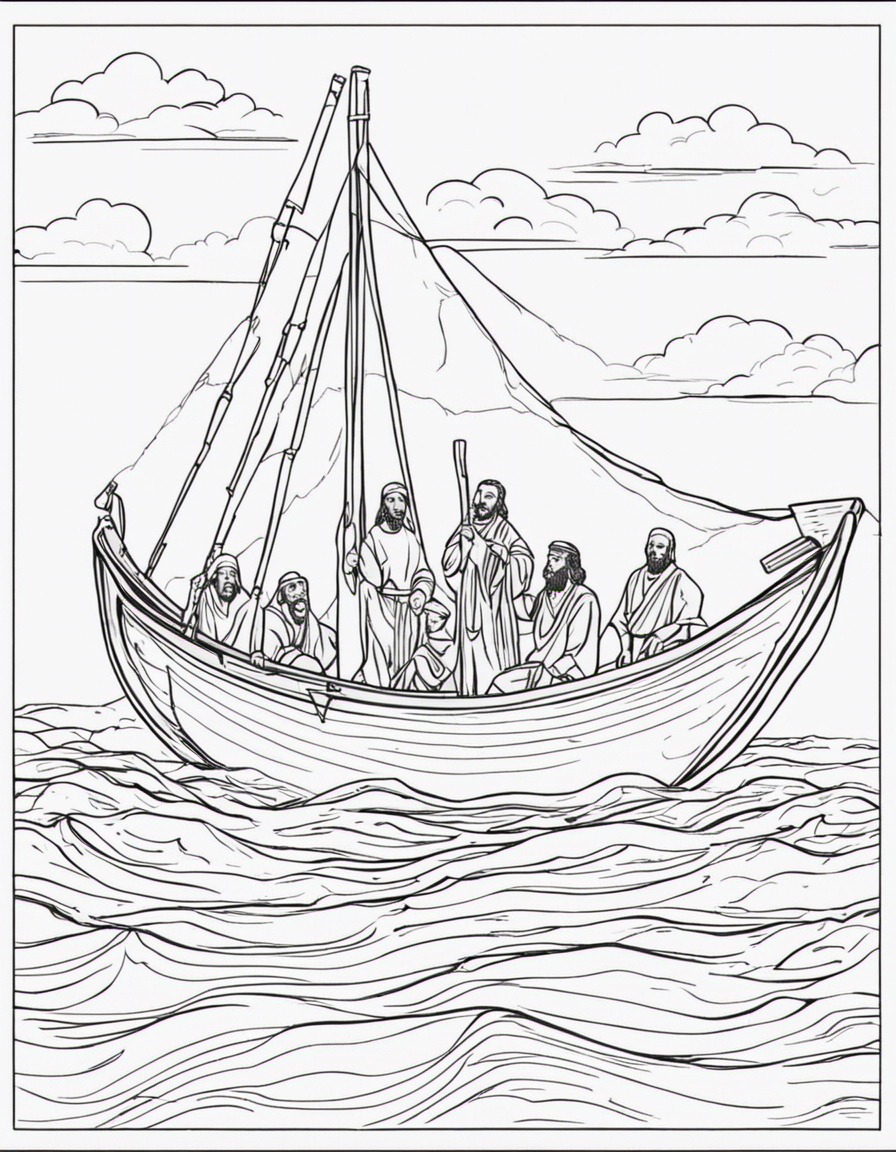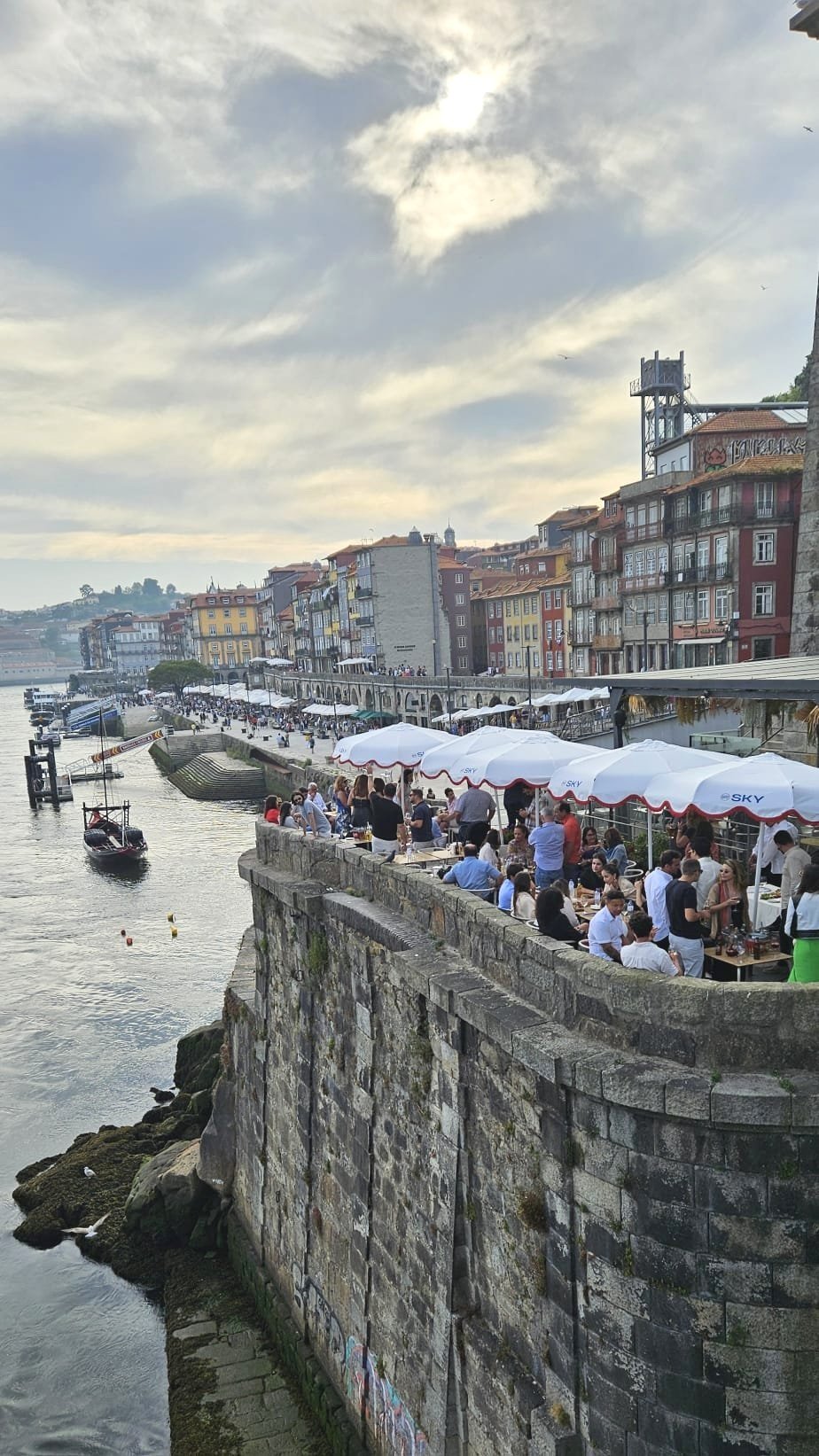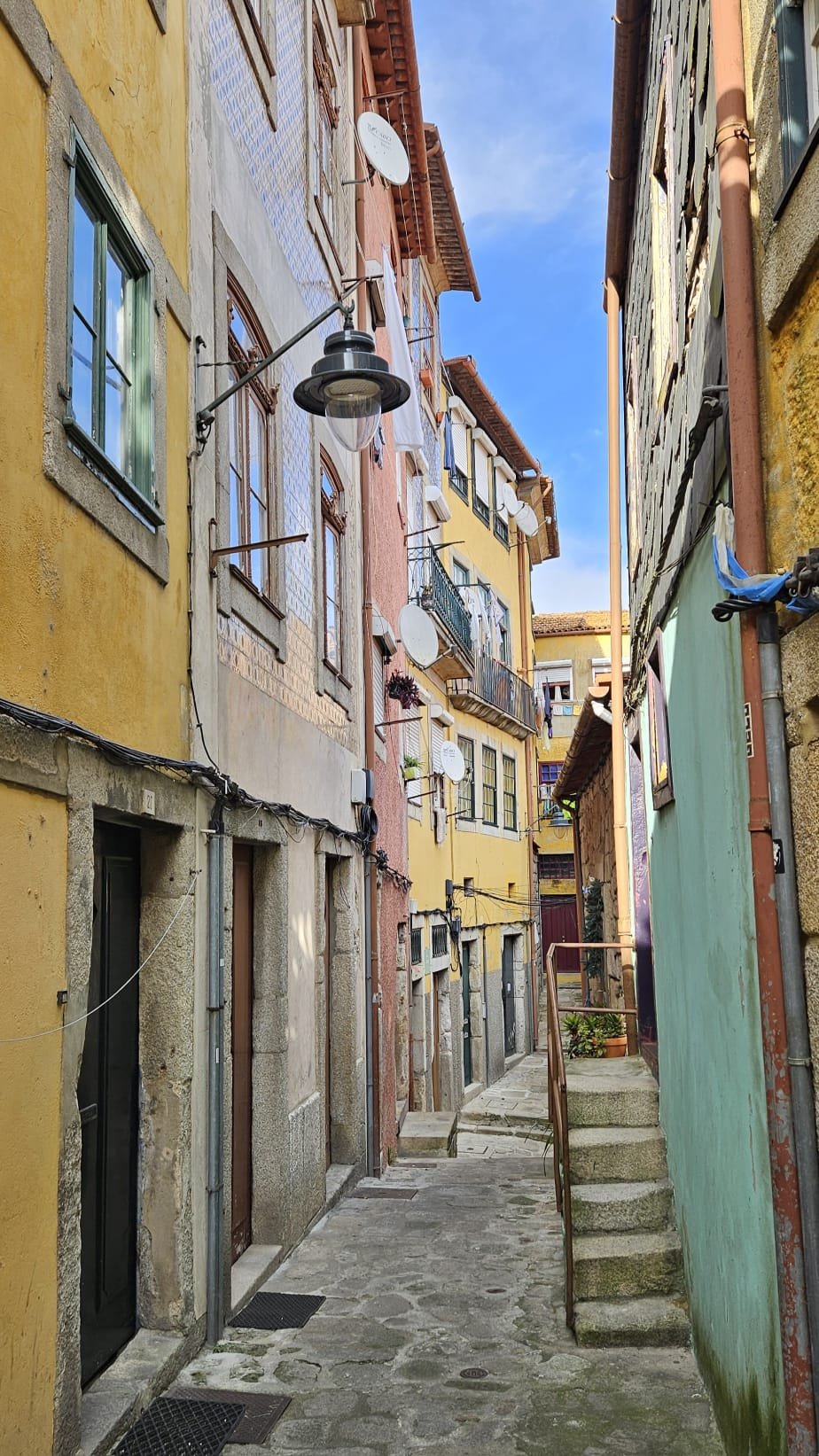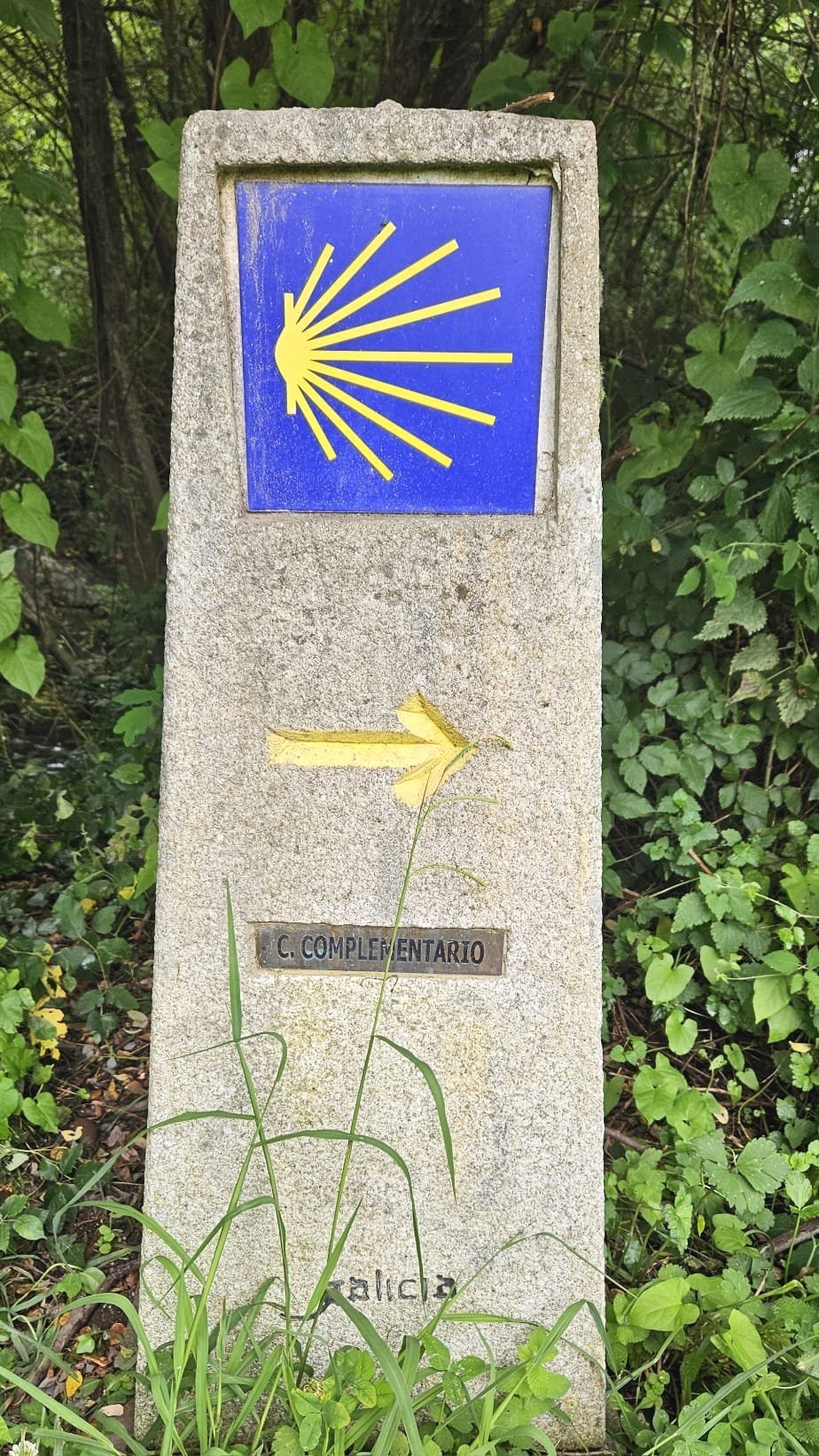The Jesus Team
Spiritual Leadership Team Series
Jesus came to change the world. He didn’t try to do it alone.
He had more power, more wisdom, more talent, more ability than any before or since he walked the earth. And yet, as magnificently capable as he was, he knew he needed others to join him. His first act of mission? He built a team.
As Jesus walked beside the Sea of Galilee, he saw Simon and his brother Andrew casting a net into the lake, for they were fishermen. “Come, follow me,” Jesus said, “and I will send you out to fish for people.” At once they left their nets and followed him. When he had gone a little farther, he saw James son of Zebedee and his brother John in a boat, preparing their nets. Without delay he called them, and they left their father Zebedee in the boat with the hired men and followed him. Mark 1:16-18
Yes, he called people to follow him, to become “fishers of men.” Not as individuals, however, but as a team. Over the next three years this group of future leaders would walk, learn, witness, eat, drink, suffer, sing, laugh, cry, serve, sin, repent and grow together.
These were not the “Ivy League” hires, either. A most unlikely lot to go on a world-changing mission. This is how the religious elite viewed them:
When they saw the courage of Peter and John and realized that they were unschooled, ordinary men, they were astonished and they took note that these men had been with Jesus. Acts 4:13
That tells me it’s less about individual talent and more about the desire to follow Jesus and the collective will to invest in relationships and partner on mission. That means it can be any of us, all of us, if we choose the same path as they did.
There are over two-hundred references to “the disciples” in the four gospels, far exceeding references to any one of them by name. Jesus was close to all of them, but closest to Peter, James and John. From the Mount of Transfiguration to the Garden of Gethsemane, Jesus spent his most vulnerable, most transformative moments with this close circle.
Women played a central role as well. “The twelve were with him, and also some women…” And not just a few; v3 cites “many others,” including some who were helping to support his ministry. (Luke 8:1-3) The first to encounter the risen Jesus, Mary Magdalene, Mary the mother of James, and Salome, were also the first to share the good news of his resurrection.
Jesus once again shows us the way. How did he lead? He built a team—a deeply connected, relational, diverse, collaborative, at times messy, but ultimately impactful, spiritual leadership team. If we want to have a Jesus-like impact on the world today, we too must be effective team-builders and good team-players.
Look around. Who are you walking with? If you cannot name your team, you do not have a team. Find one, or build one. Nothing changes the world like a Jesus team.
Leading Starts with Modeling
Spiritual Leadership Team Series
The first principle of leadership is example. A leadership team is a model of the church to the church. Jesus taught through modeling—a living example of faith, hope and love. He didn’t spend a lot of time teaching in the synagogue. Instead, he went into the wilderness, built a team, and showed the world what a redemption community looks like. Paul understood the power of modeling. He called out the Thessalonian church for its sacrifice and love, “And so you became a model to all the believers in Macedonia and Achaia.” (1 Thess. 1:7)
The truth is every leadership team is modeling something to the church and to the community. The only question is—what kind of model do they see? Is it a model of faith, hope and love? Is it a model of humility, deep connection and spiritual partnership? Or is it a model of conflict and division?
Scripture
Whatever you have learned or received or heard from ME, or seen in ME—put it into practice. And the God of peace will be with you. Philippians 4:9
Follow MY example, as I follow the example of Christ. 1 Corinthians 11:1
Leadership Team Application:
Whatever you have learned or received or heard from US, or seen in US—put it into practice. And the God of peace will be with you. Philippians 4:9
Follow OUR example, as WE follow the example of Christ. 1 Corinthians 11:1
The New Testament writers give us powerful and practical images of the church as connected and unified. Ephesians 2 offer three metaphors—(1) a nation, (2) a family, and (3) a household.
Consequently, you are no longer foreigners and strangers, but fellow citizens with God’s people and also members of his household, built on the foundation of the apostles and prophets, with Christ Jesus himself as the chief cornerstone. In him the whole building is joined together and rises to become a holy temple in the Lord. And in him you too are being built together to become a dwelling in which God lives by his Spirit. Ephesians 2:19-22
What an amazing vision for the church! But is it what we see when we look at the leadership team? Jesus knew that, for the gospel to spread and for churches to grow, the leaders would need to be unified. This was so important to Jesus that he spent his last night washing their feet and praying for their relationships.
Now that I, your Lord and Teacher, have washed your feet, you also should wash one another’s feet. John 13:1
Leaders and leadership teams too must “wash one another’s feet” to create the connection and unity needed to serve the church. We cannot lead together in Christ if we do not live together in Christ. The church will imitate not only the faith but also the sense of family of its leaders. May we build leadership teams that are “joined together” in a way that inspires the church with a vison of “being built together to become a dwelling in which God lives by his Spirit.”
Leadership Team = Leader + Team
Spiritual Leadership Team Series
Church leadership teams are not committees, advisory groups, or management teams. These are all important functions that have a time and place in healthy spiritual organizations. Especially as churches get larger, there is a need for good management of programs, finances, policies, budgets, events, communications, etc.
Too often churches settle for management, however, when leadership is needed. Management is easier, it’s safer, and it’s fine as long as we’re perfectly happy with where things are and just want that to continue. If we seek change and growth, however, leadership is needed.
Jesus was a leader. Stirred by the darkness and lostness of the world, he left the security of heaven and set out on a rescue mission. He came to start a movement, to build a Kingdom. To do that, he needed men and women willing to follow at any cost. Only the most devoted would stay with him.
Church leadership teams must be willing and able to lead. There are many ways to do this. The best way is to have a trained leader with the faith, vision, gifts and courage to lead. A good leader can transform a good team into a great one. If a team is unable or unwilling to bring in a trained leader, the team itself must find ways to cultivate the leadership capacity within it. Outside support and training for members of the group is a vital to building leadership team skills.
Great leaders are good team builders. Jesus led in a way that drew men and women to him. They felt safe. Just look at how real the disciples were in his presence. Jesus sent out the twelve in small teams of two. These partnerships would help these young leaders develop deeper connections and serve as the DNA for leading in teams in the years to come. Leaders who were more attracted to power and position, who were unwilling to work in teams, would ultimately falter (Judas, Simon the Sorcerer, Diotrephes, “who loves to be first,” etc.). Servant leaders who matched faith and courage with humility, who were connectors and team builders, built teams that built the church.
Great teams value and support good leaders. Barnabas rallied others around Paul even as many questioned him. If a leader, leadership team and Board do not come together in heart, spirit, vision and relationship, trouble follows. Integrating new leaders, especially younger leaders, into existing teams can be particularly challenging. It takes time, attention and support to navigate through the “Forming” and “Storming” phases of group development. Leaders and teams that grow together, however, grow churches.
Into the Wild
In the summer of 1987, I spent three weeks in the Bighorn mountains in Wyoming as part of a wilderness expedition training program with the National Outdoor Leadership School (NOLS). We were there to learn how to prepare, navigate and ultimately lead others in backcountry travel. I arrived with a new set of hiking boots and an adventurous spirit. We were supplied with equipment and provisions for an off-trail, unsupported (other than one resupply) trek into the mountains.
We walked, climbed and hiked for days upon days, all the while learning about nutrition, mountain medicine, setting up tarps (no tents) below and above tree line, weather patterns, edible plants, cooking (even baking in an open fire), and many other useful skills. The most important lessons, however, were orienteering and group dynamics. We were taught how to read a topographical map and use a compass to navigate the terrain, and to work together to plan and solve problems.
After breakfast each morning the group came together to decide where to set up camp later that day, being careful to select a spot that covered the miles needed, had access to fresh water, and was protected, if possible, from the elements. Then came the most challenging but also the most energizing part. Once we were packed up for the day, we were divided into teams of three or four, then separated from the other groups and tasked with selecting a route (remember, no paths), navigating the terrain, supporting each other, watching for hazards, locating water, and basically working together to get safely to the next location. Each day new groups were formed, which meant learning how to work with different people with a wide range of personalities, talents and abilities. Our guides provided just enough coaching to help us learn how to plan, problem-solve, and ultimately succeed as working teams. They stayed close enough to help as needed, but otherwise left us to go and grow on our own.
I loved that experience. It has had a profound influence on how I think about leadership, coaching, capacity building and team development ever since. There is nothing like coming together as a group, developing deep connections, tapping everyone’s gifts and resources, taking ownership of the task, facing challenges, brainstorming solutions, and working together to accomplish things we couldn’t achieve on our own. Building confidence and capacity in others, and developing productive teams, is the very essence of good leadership.
The Power and Peril of Church Leadership Teams
Leadership teams have more ways to succeed (than individuals) through the power of combining spiritual gifts, the creative force of diverse perspectives, the collective energy and thought power, and the larger capacity to carry the load. On the other hand, because they have many parts with complex organizational and relational dynamics, teams also have more ways to break and fail. Here are some common scenarios that can lead to stuck teams and stuck churches.
1. Unfit or Unwell Members
Spirituality is a must for anyone serving in a decision-making role in the church. Anyone serving in a Board or Administration role should also be spiritually strong, a member in good standing, and well connected relationally. Too often roles of leadership are given to those who may be gifted but are not spiritually or relationally fit. Even one spiritually unfit or unwell member can derail a leadership team, and a church.
2. Role and Goal Confusion (Who, What & How)
Leading with a team requires a clear definition of WHO (roles & responsibilities), WHAT (goals) and HOW (processes). When roles & responsibilities are not well defined, teams tend to spend too much time in long meetings and never-ending conversations trying to solve even simple questions. When goals are not set, teams tend to become managers of the status quo and lack the vision and capacity needed to move the church forward. When processes and procedures are not clear, even teams with great faith can fail because they simply do not know how to function.
3. Relationship Issues
Strong teams are built on strong relationships. If there are unresolved issues between team members, it can make it difficult if not impossible to work together in a productive way. Teams can spend weeks, months and even years debating issues related to church matters and not realize the real issues are relational.
4. Unresolved History
When we don’t process and resolve difficult experiences (whether inside or outside the church), they tend to stick to us and create a fear/reaction response when facing issues. We may resist leadership because of a bad experience with a leader in the past. We may resist an idea because it feels like something that failed in the past. We avoid certain people because they remind us of people who hurt us. Unresolved history can prevent leadership teams from being faithful, forward-looking and effective.
5. Negativity or Just Familiarity
Jesus could not do miracles in his hometown. To the people there he was just too familiar. Leaders and teams also can become too familiar—with each other, with the church, with situations. Stagnation and negativity can set it and slowly dull the spirit of the team as it loses faith and vision in what God can do. Without someone inside or outside to call it out, these churches become a smaller version of what God created them to be. “Where there is no vision, the people perish.” (Proverbs 29:18).
Combining gifted, diverse people into a coherent, high-functioning leadership team is hard. Like any system, the team relies on the good work of each part, a strong connection among the parts, and a coherent operating system. A breakdown in any of these, left unchecked, can stall the whole thing. The payoff of getting it right, however—the elevated leadership that a good team can provide—makes is worth the effort.
A Systems Approach to Leadership: A Car Story
Spiritual Leadership Team Series
This is first in a series on spiritual leadership teams. Although the specific context is church leadership, many of the principles apply to leadership and teaming generally.
I bought my first car when I was a second year university student. It was a very small older car with a soft covered sunroof. I loved driving that little car, especially with the windows and sunroof open to the fresh Virginia air. It ran pretty well. The only issue was a small oil leak. I didn’t want to spend the money to repair that. Instead, I kept a jug of engine oil in the trunk and just added some every time it was running low. That worked fine, until it didn’t.
At the end of the school year, I was driving home to Maryland when the oil light came on. I had used all the spare oil so I had none to add. I was only about 20 minutes from home, however, so I made the decision to just keep driving. A few minutes later, the engine shut down. I pulled off the road and called a mechanic, who towed the car to his repair shop. The news was not good. The engine had completely seized up—the pistons were fused to the engine block. It was beyond repair. The car had to be scrapped. And so ends the short life story of my first car.
Why do I share this story? There are lessons to be learned.
1. An engine is a system that relies on many parts operating together. Each part has a purpose, but that purpose is only realized when it is properly designed, fitted and calibrated to work with all the other parts. If one part suffers, every part suffers. Wait, where have we heard that before? Church leadership teams are also systems that must be designed and built well to work effectively. Too often, however, they are pieced together without understanding what parts are needed, how they should work together, and what performance looks like.
2. An engine needs regular preventative maintenance. A small problem can grow into a big problem if it is not addressed quickly. If we wait for something to break down, it can create much more damage. It is the same with church leaderships. We have seen a lot of breakdown in leadership teams, some with issues that have festered for years. Too often we find out too late, only after it has become an emergency and much damage has been caused. We need to find ways to build stronger connections, have better insight, get earlier feedback, do preventive maintenance, and provide support sooner, before small issues become larger.
3. Relationships and trust are the oil of teams. Oil keeps the moving parts from damaging each other while the engine is powering the car. If the oil leaks out, the engine will fail. It’s one thing to lose a car that way. It’s another thing to lose a church.
Jesus taught these same concepts using different metaphors—bodies (Romans 12, 1 Corinthians 12), fields (Mathew 13), households and homes (Ephesians 2). We need to see church leadership in a more holistic sense, as parts working (or not) together, as a system designed by God to power and support the church. This will require a shift in how we support churches and church leadership teams.
Write On!
Last year I went on a 100-mile bicycle ride (a century, as they call it in the biz) and wrote up a blog piece on the experience, 100 Miles of Solitude. I was so energized by the experience, and I mean the writing, that I published a second blog the following week. That was it, the beginning of my weekly writing practice. Or at least I thought. Turns out that lasted, well, those two weeks.
Months passed with nary a word from me. Then I had the extraordinary adventure of walking the Camino with my daughter—300 miles of exploration and adventure from Porto, Portugal to Santiago de Compostela, Spain. During the trek, I shared experiences, reflections, photos, etc. with my family via WhatsApp daily messages. While I did this to share the journey with them, I found the process of daily blogging added depth, texture and meaning to the experience for me. I turned that into a blog series, which I published this summer.
Then radio silence. Again.
What gets in the way?
Waiting for perfection, for one. The perfect idea. The perfect words, phrasing, mood, flow, style, everything. After all, once the written word goes out into the world, it lives in that form forever. So, I better get it just right. The quest for perfection is suffocating.
Then there’s the search for subject. What should I write about? I’ve wasted way too many opportunities to create by waiting for perfect (there it is again) clarity on topic. How about just write and see what comes?
I recently rewatched the “Get Back” Beatles documentary series. With excerpts stitched together from over 60 hours of raw film, director Peter Jackson offers us a unique window into the creative space that is songwriting. What amazes me is to see the approach. Someone comes in with an idea, maybe a musical phrase, a lyric, sometimes more, sometimes less, and then they just start creating and re-creating together. It’s a messy process. Just get started and work it work it.
So here it is October of 2024, one year after my first burst of inspiration to begin writing again. This time I hope to employ a more disciplined approach, a daily practice to get the engine re-started and running. It’s time to get something down, and work it work it. Write on!
Walking the Camino
Hello Family and Friends!
Here's a little travel log of my walk on the Camino Portugues with my daughter, Jessica. We left Porto, Portugal on June 5th and arrived in Santiago de Compostela, Spain on June 19. What happened in the between was just oh so special. It was joy to have done it, and to capture the moments, the ups and downs, the chance encounters, the exquisite beauty, the stories, and the spiritual journey to share and to remember.
This was initially “published” as a series of daily WhatsApp messages to my family. They were all good sports and signed up to share the adventure with us. Since then, others have asked to see the pictures and hear the stories. So here we are.
Interested in learning in little about the Camino walk, what it is, and why people do it? There are many websites, often the work of “pilgrims” inspired to share good information about routes, gear, history, etc. with fellow travelers. Here’s a good one: https://www.trafalgar.com/real-word/need-to-know-camino-de-santiago-pilgrimage-route-spain/
I’m going to try and post these as separate articles, one for each day, just as I shared them originally. I think that will make it more accessible. Just know that each day connects to another day and to the journey overall. Let’s see how it plays out :)
Day 0: Lisbon
Walking the Camino
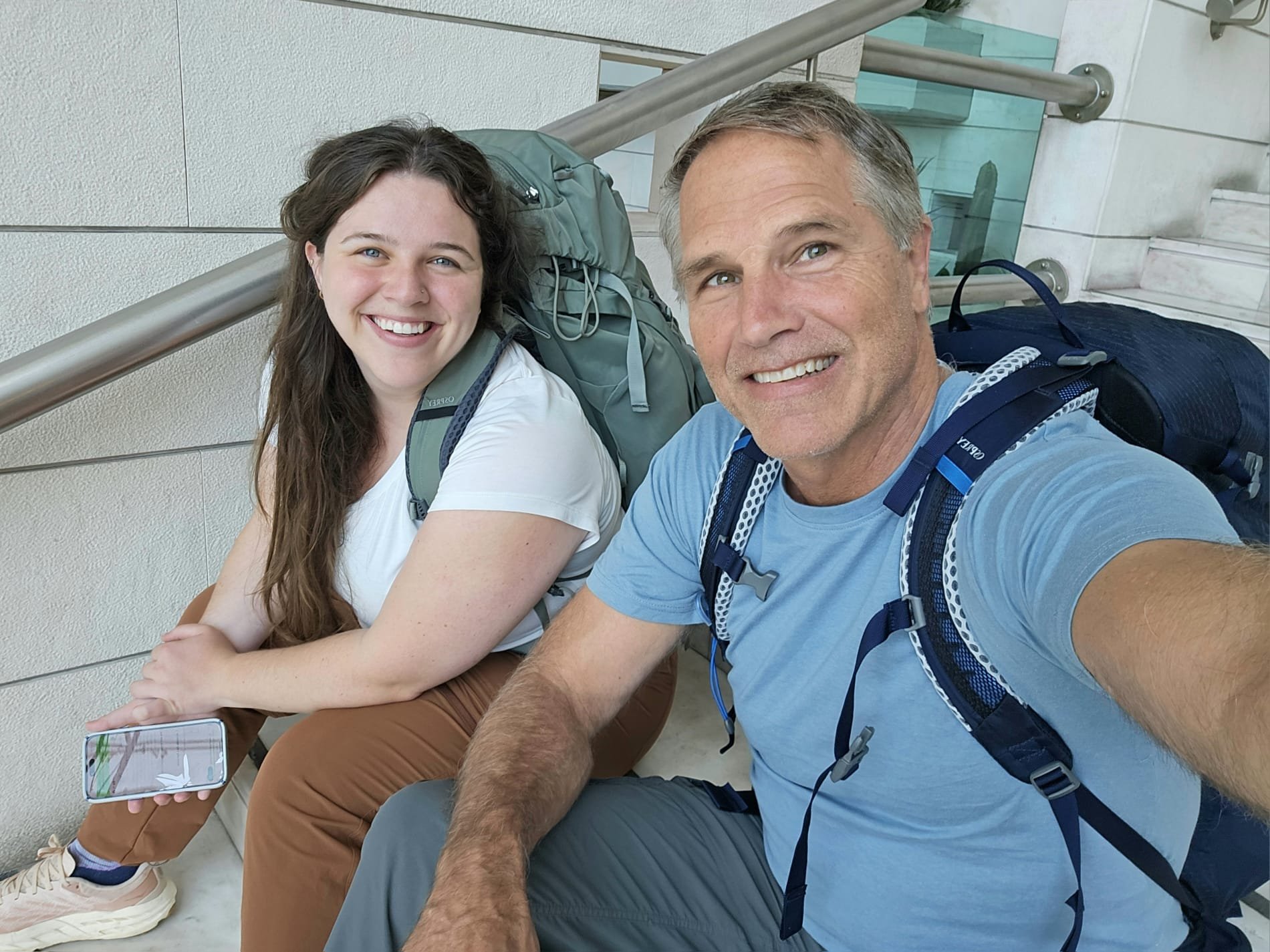
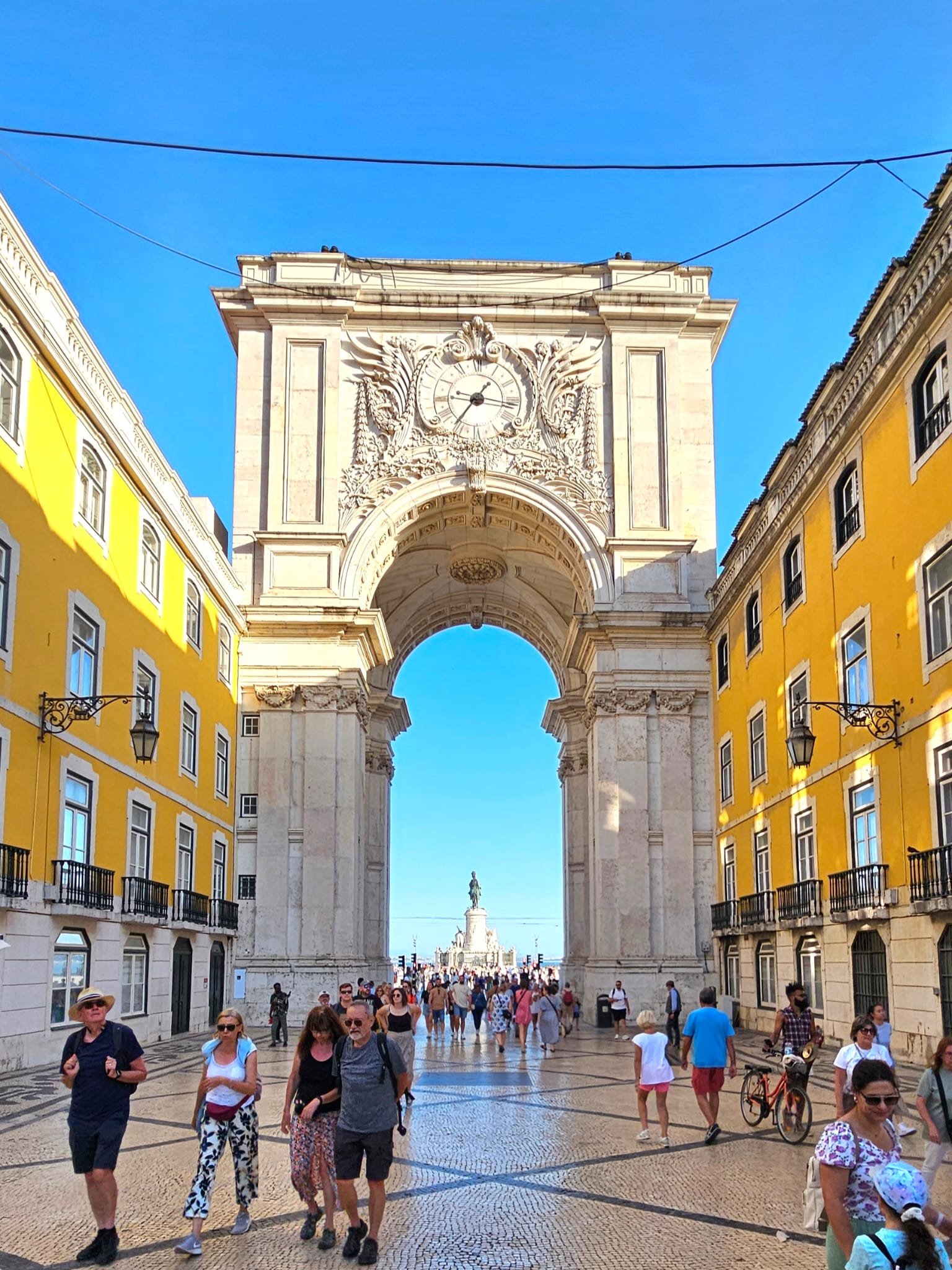
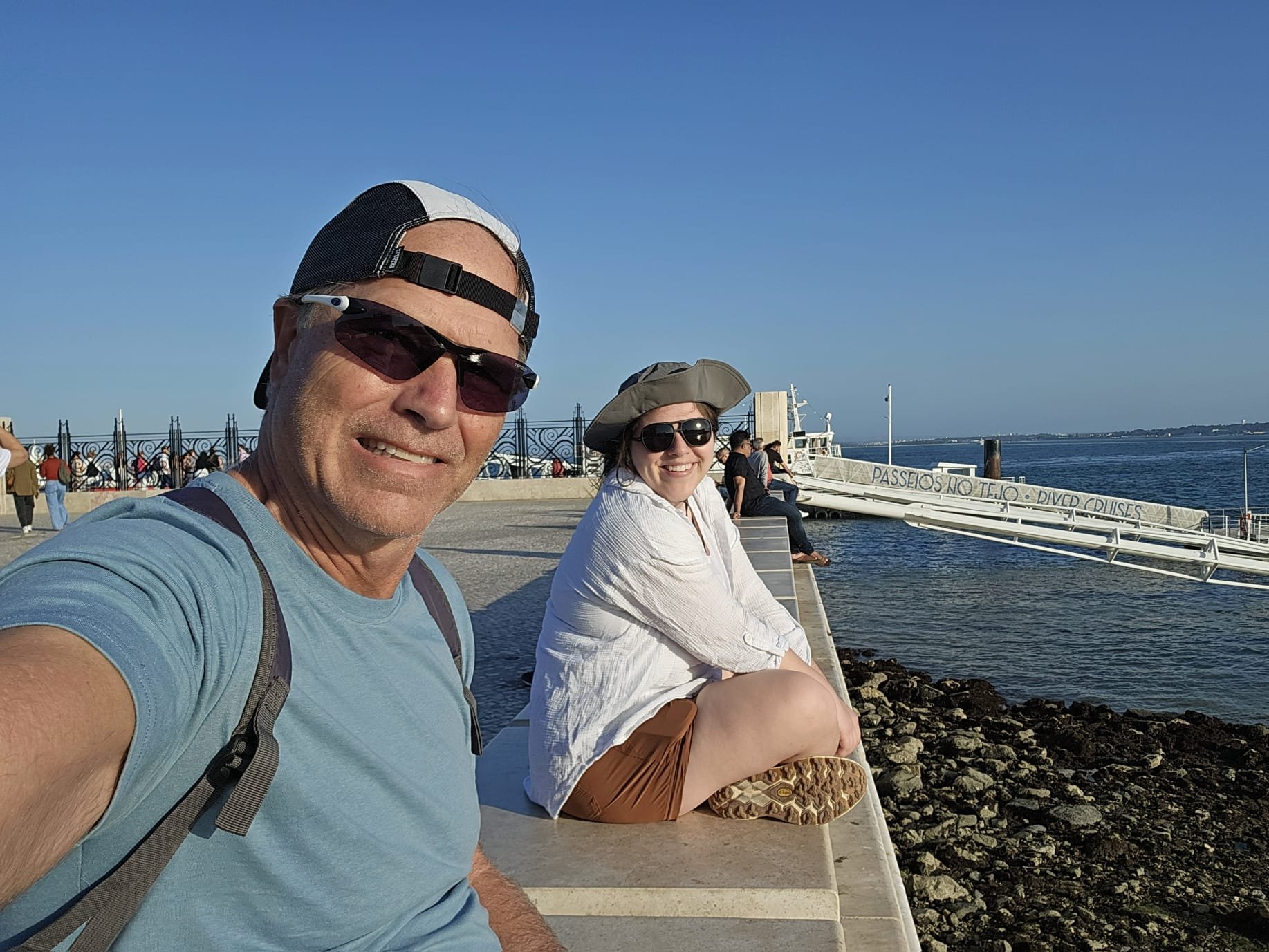

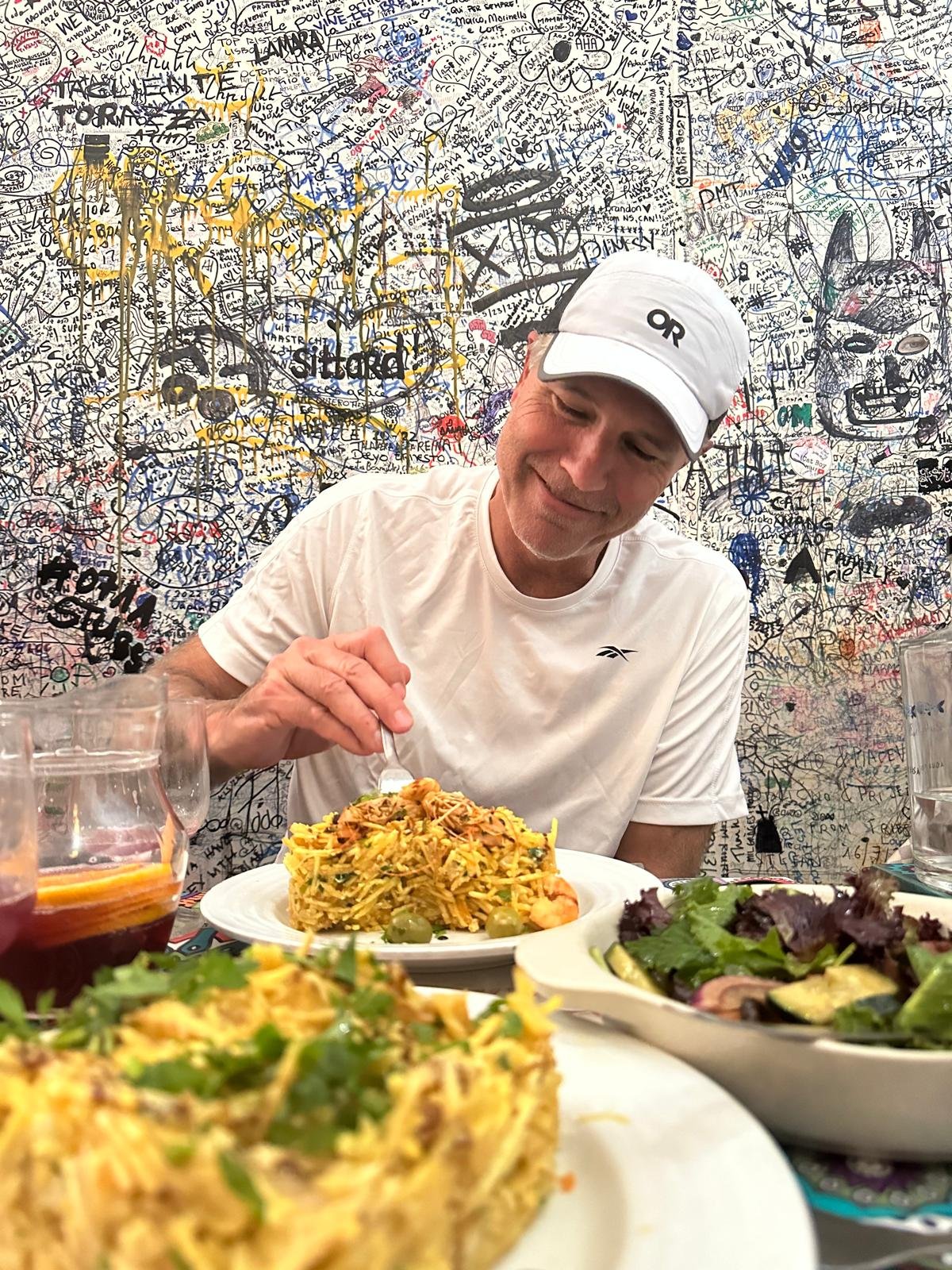
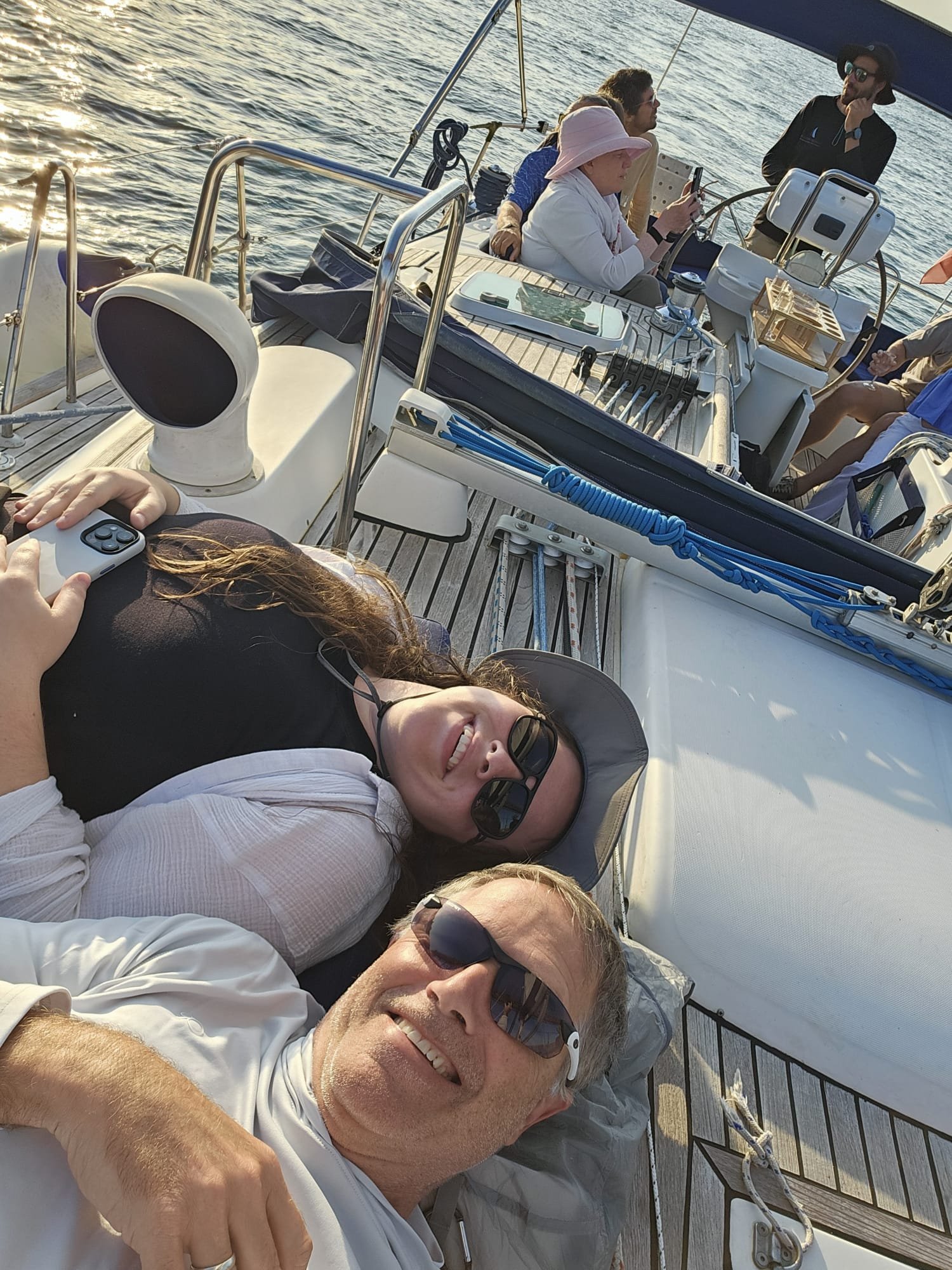
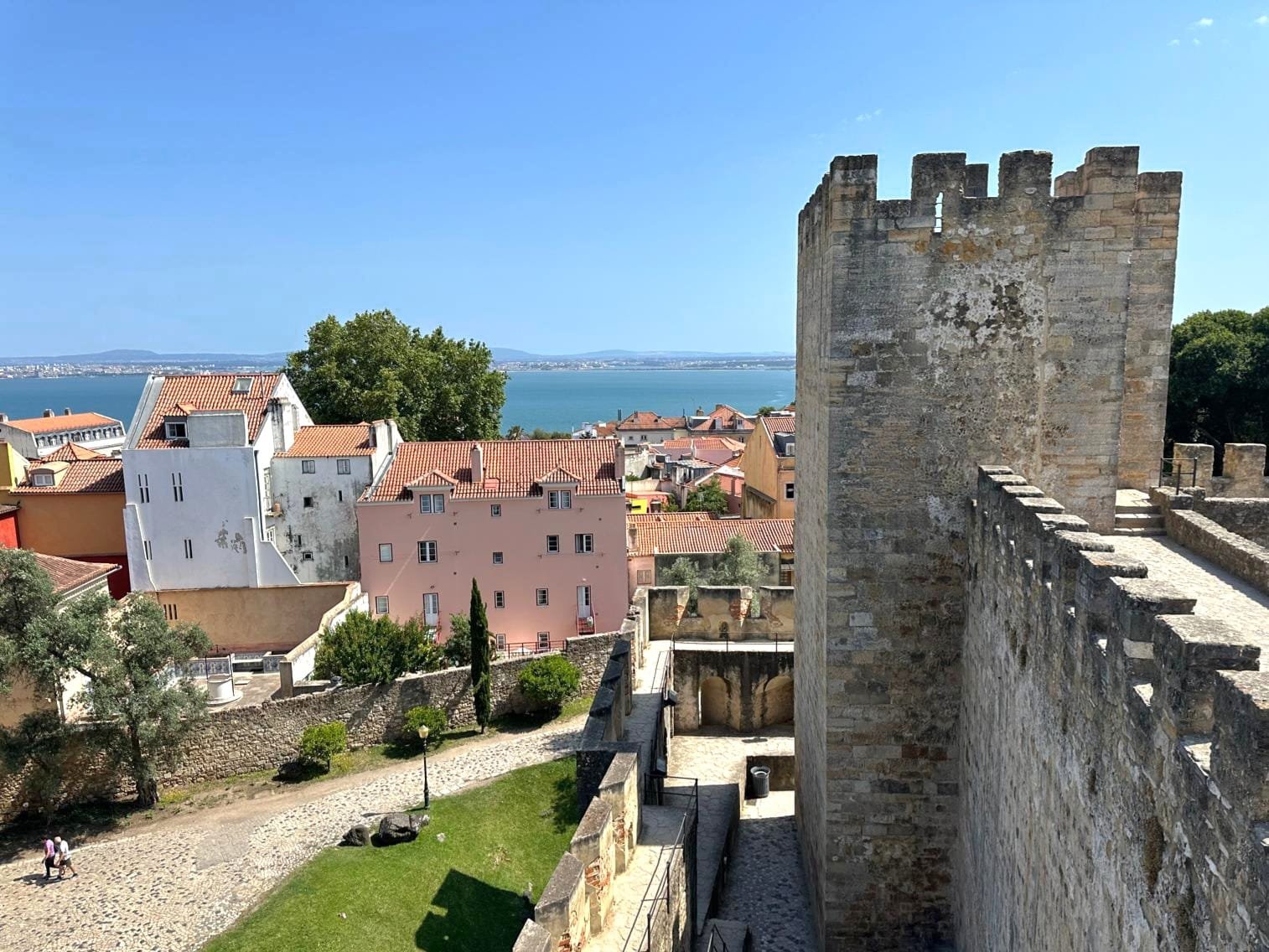
Jessica and I arrived in Lisbon from DC (me) and Amsterdam (Jessica) on Sunday. We walked the city, including a cute old neighborhood on one hill and the castle on another hill. And had our first pasteis de nata, the traditional Portuguese pastry. Yum 😋
Lisbon is beautiful in an old Europe, colorful, weathered, wonderful kinda way. These were supposed to be rest days before the big walking, but we still did 23k+ steps a day. So much to see and do! Lots of hills, lots of stairs. Turns out that was good training for Porto (foreshadowing alert).
We took a sunset sail on the river, where we took in the sights and the stories as told by our eager young boathand, Miguel. We also had our first taste of Portuguese green wine. It's light and sparkly, and just right for a summer sunset sail, it turns out.
Portugal is sun, good vibes, good food (especially seafood), friendly people, and, at least for us, adventure, reflection and connection. So grateful to be here, to do this.
Btw "Day 0" represents the two days we spent in Lisbon.
Day 1: Porto
Walking the Camino
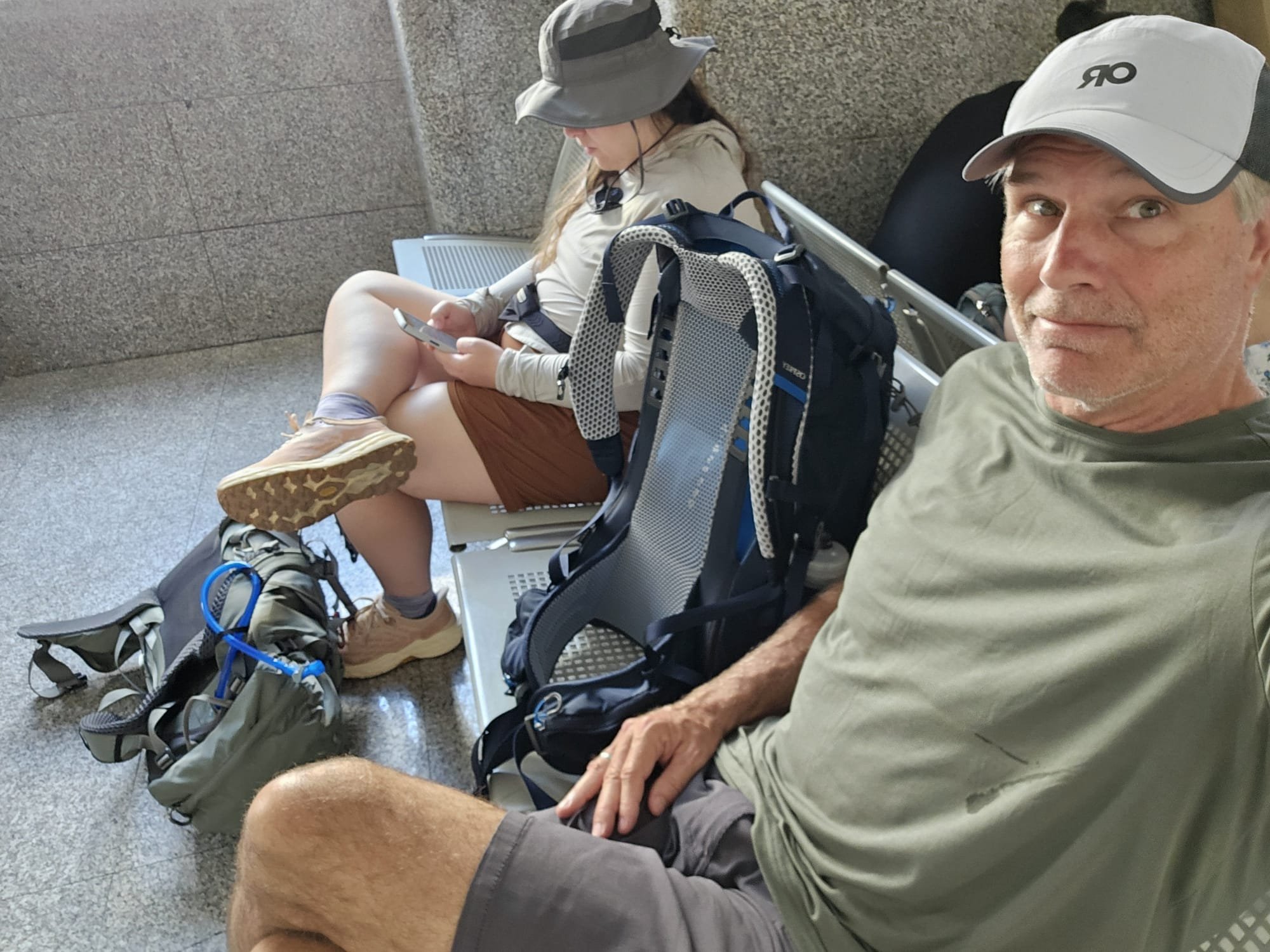

We took the high speed rail to Porto on Tuesday. Porto is more elegant than Lisbon (much of Lisbon was flattened in a devastating earthquake in 1755) and, somehow, even more hilly. It sits in a river gorge, with houses and buildings built up and all around the slopes. Very pretty.
We walked the city, ate some bifanas (juicy little pork sandwiches, sooo good!), and toured the local cathedral that represents the starting point of our journey. We picked up our Camino passports there and our first stamp. (The idea is to get the passport stamped along the way to document and in a way, prove we made the journey. Only then can we get our certificate in Santiago de Compostela, the end point of the walk.)
We stayed in a hostel in a shared room. This was us trying the true hostel approach to walking the Camino, which is its purest form. Sorry, too old for that. We'll be booking a private room in hostels or guesthouses from now on. Sleep matters.
We managed to escape the crowds up an old alley, where we found a lovely little restaurant to end our lovely little day. Tomorrow we start the walk.
Day 2: Porto to Matosinhos
Walking the Camino

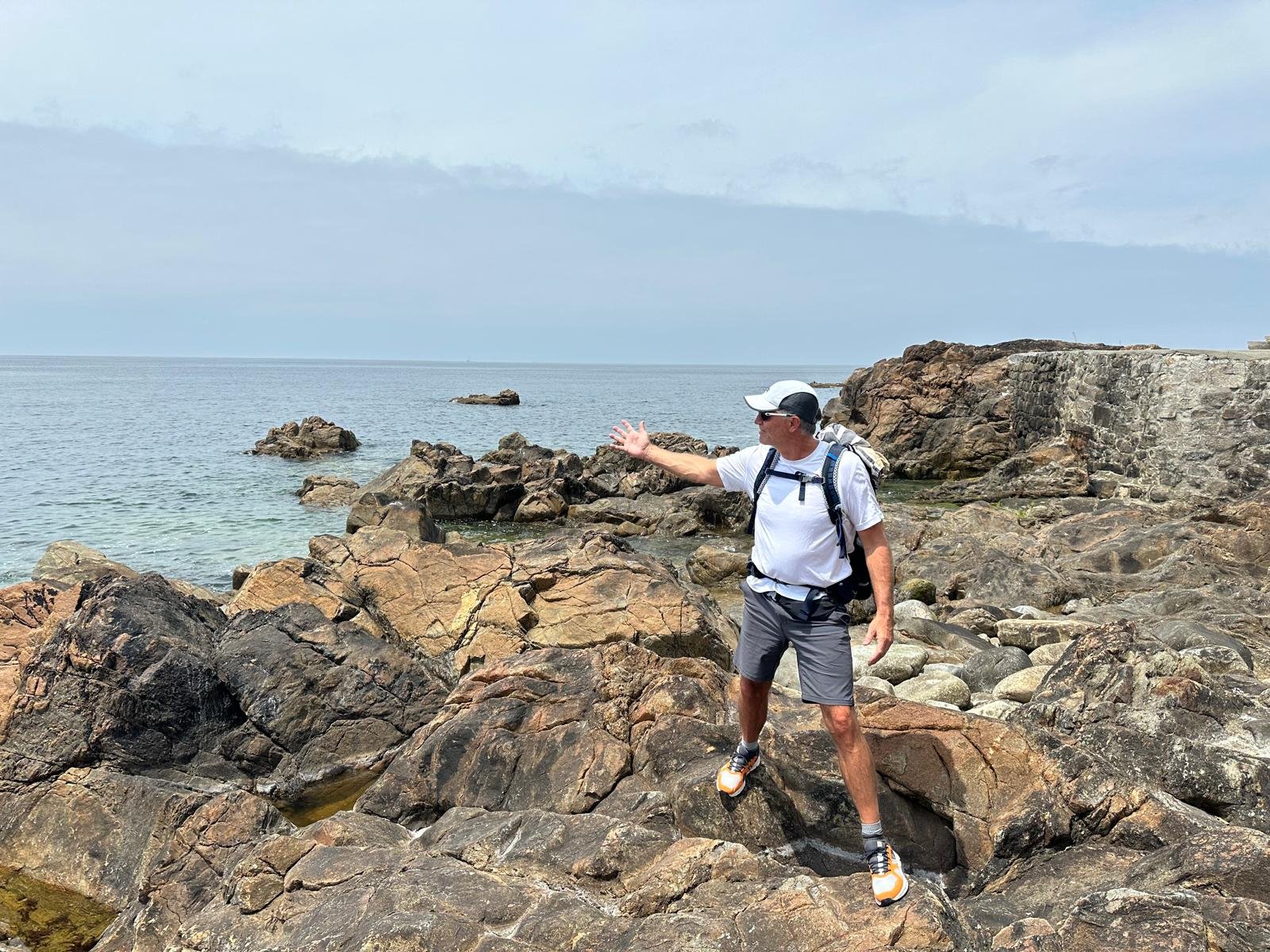
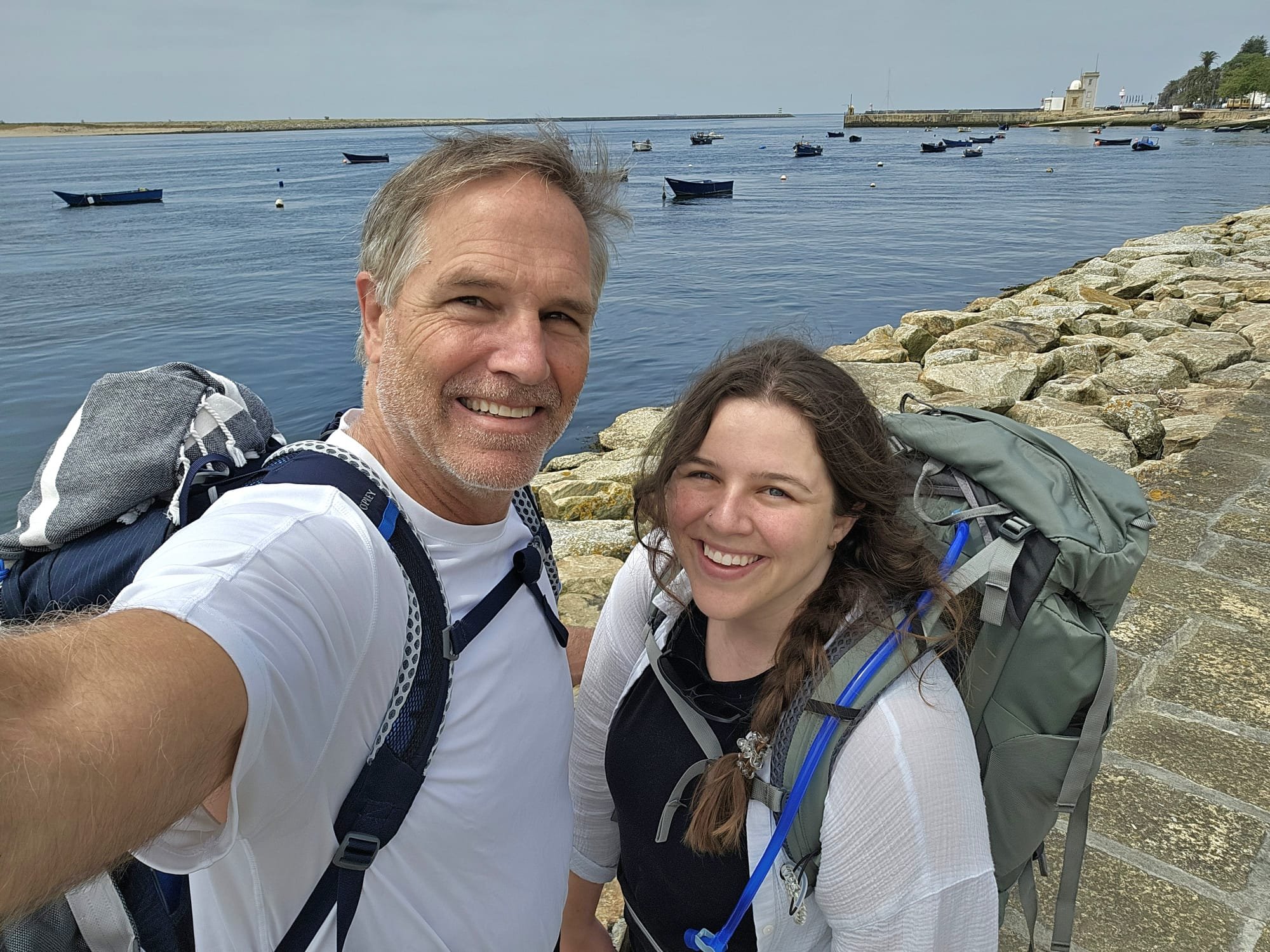
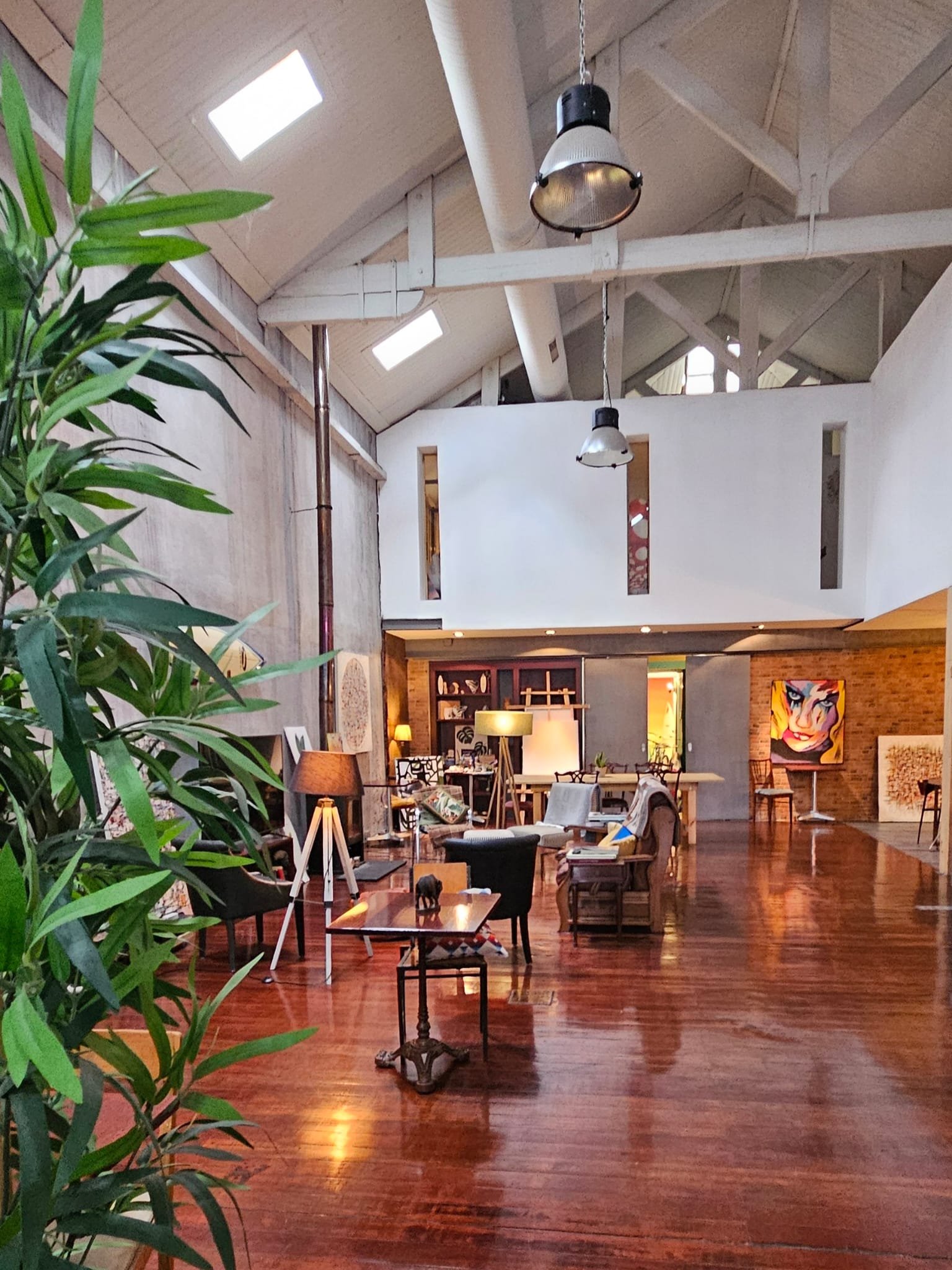
This was a short walk of just 6 miles, our Camino starter kit. We met our first fellow pilgrims on the way down to the river... a mother and her teenage son from Atlanta. She's connecting with him. He's trying to figure out next steps in life. Each person has their own reasons to walk the Camino. I'll explore that more later.
We followed the flow of the river out of the city towards the coast, then banked right where the met the sea. We are walking the Coastal Route, with parts of the Litoral Route. The other main pathway is the Central Route, which is, well, more central. See how it works?
We stayed in a private room at the Caruma Surf Hostel. Great place, super spacious. There’s big time surfing in Portugal. Check out "The 100 Foot Wave" on Netflix for more on that.
Day 3: Matisinhos to Azurara
Walking the Camino
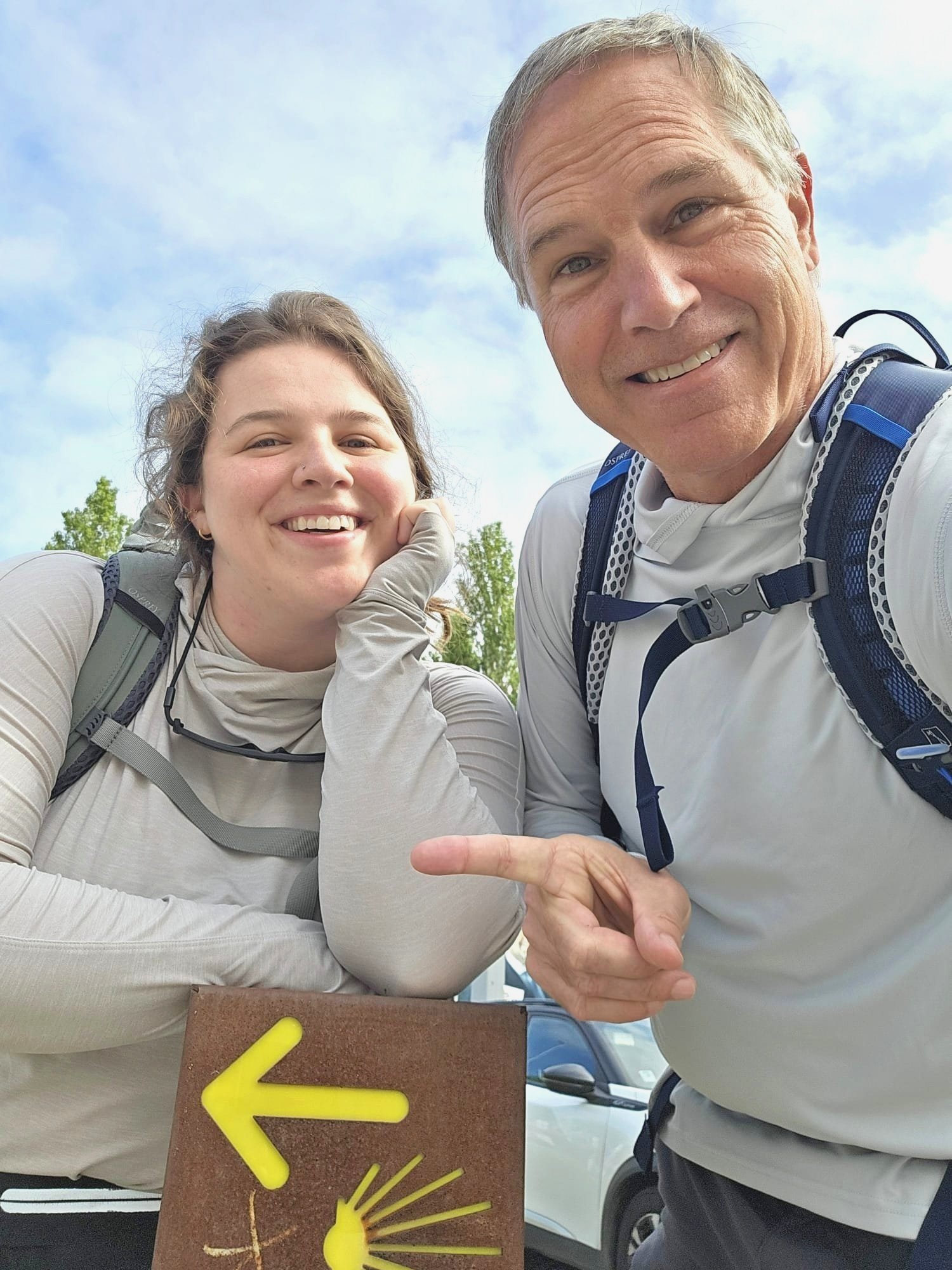
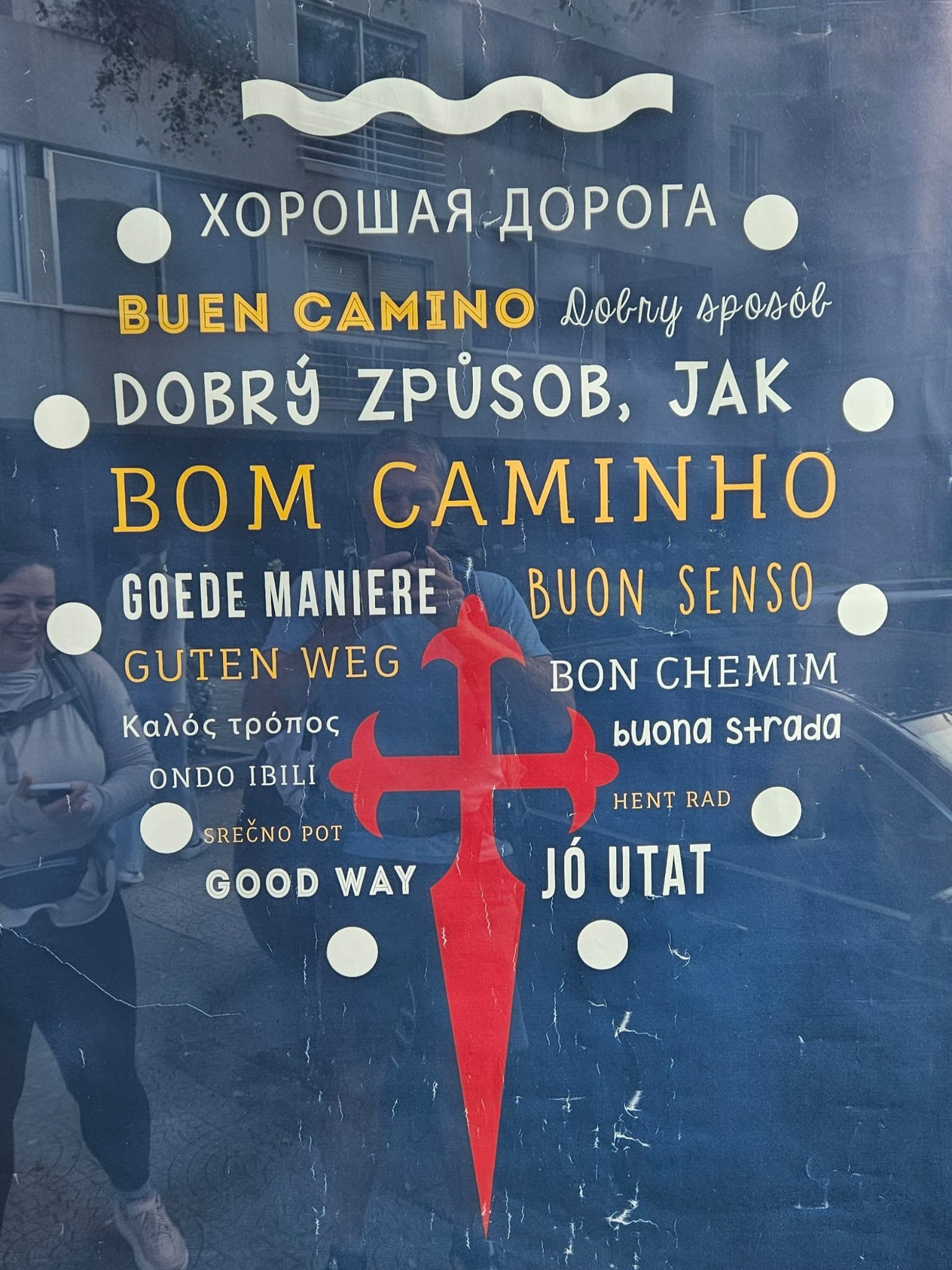
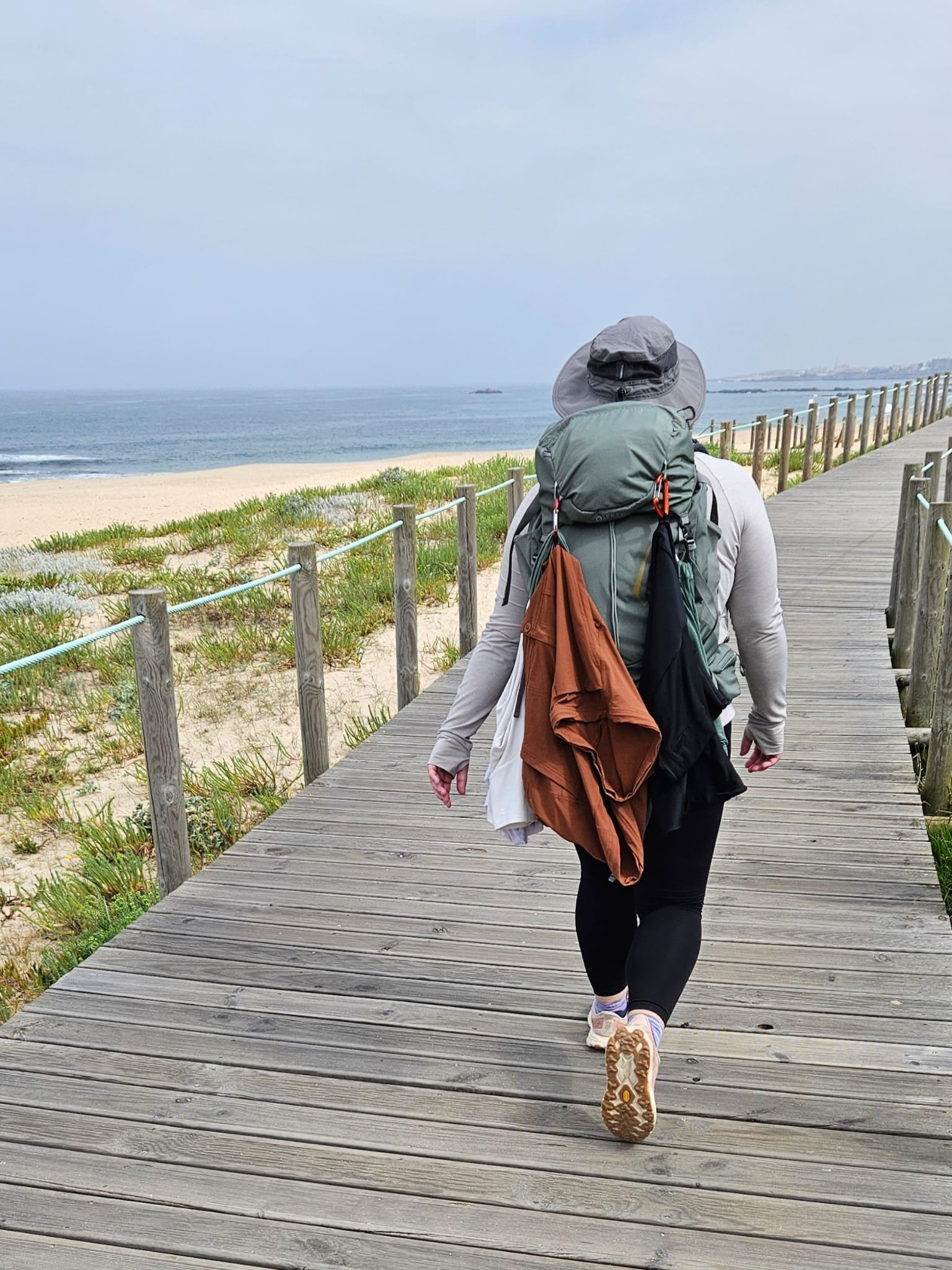
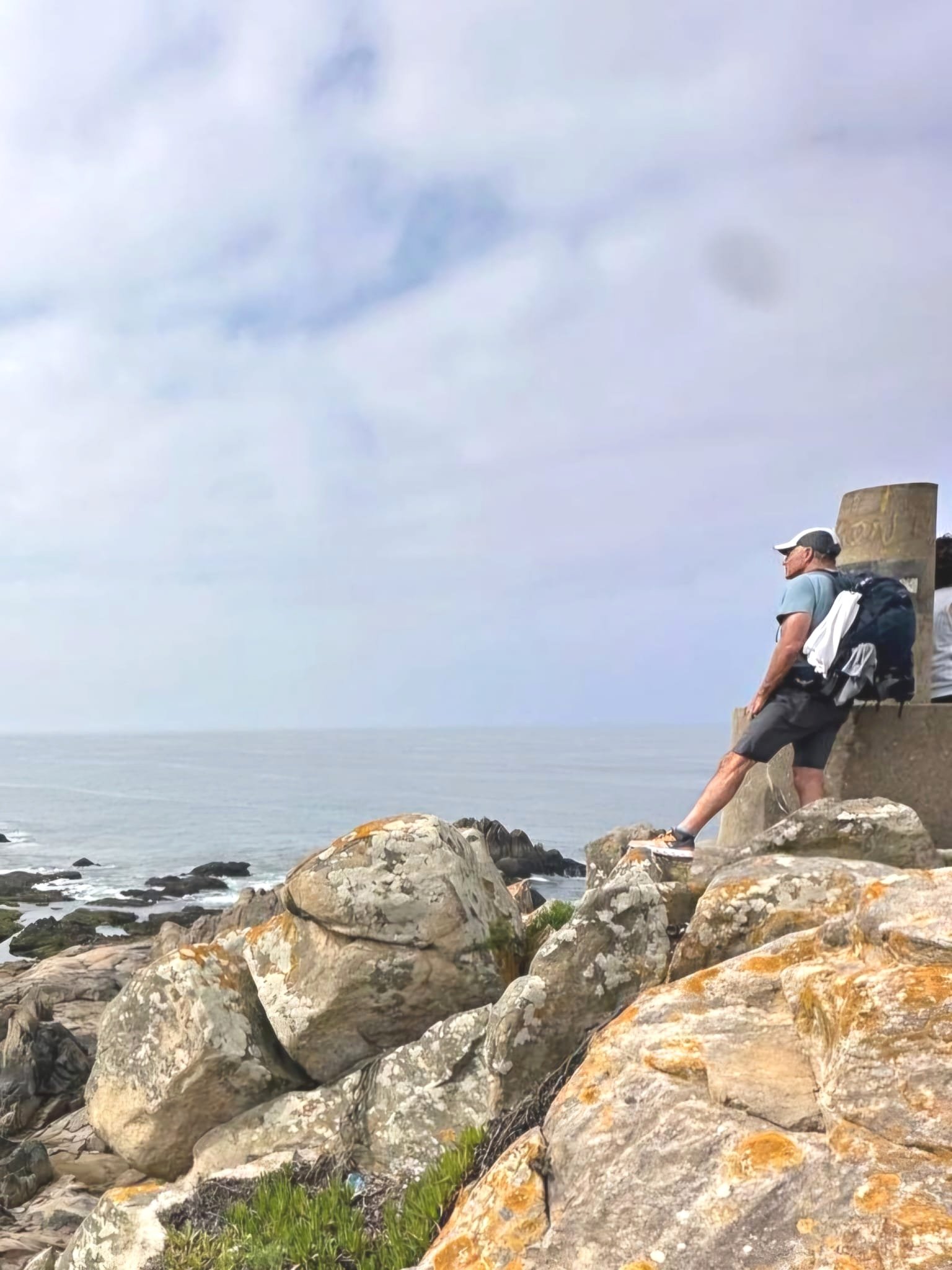

This was our first real walking day... 12.5 miles along a coastal boardwalk... low 70s, light onshore breeze, spectacular views... just really special. Here's where it really started to feel like the Camino. We saw our first sign, the iconic yellow sun/shell and arrow that points the way. We saw many more travelers, our fellow pilgrims. And we got more stamps in our passports.
We arrived at our guesthouse at the same time as a father-son biking the Camino. The host was a bit frantic as her phone had broken earlier in the day. But she led us into the house with a warm greeting, "Come in, this house is your house. I made cake for you. Welcome!" The spirit of the Camino.
We're starting to feel a little hitch here and there. Jessica is having an issue on one of her feet, and my hips, back and knee are complaining just a little bit. We've decided to take more breaks going forward.
Day 4: Azurara to Esposende (16 miles)
Walking the Camino
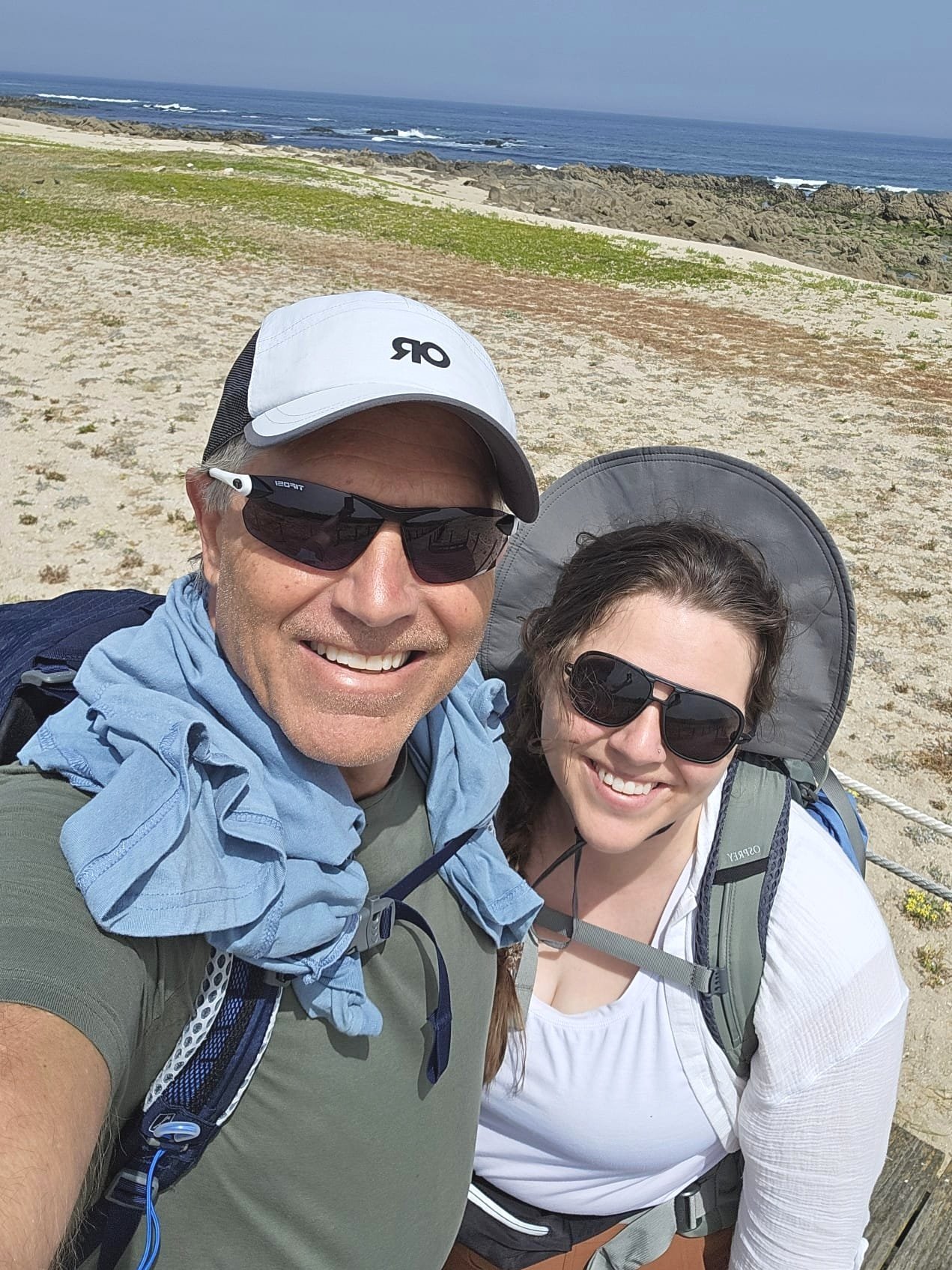
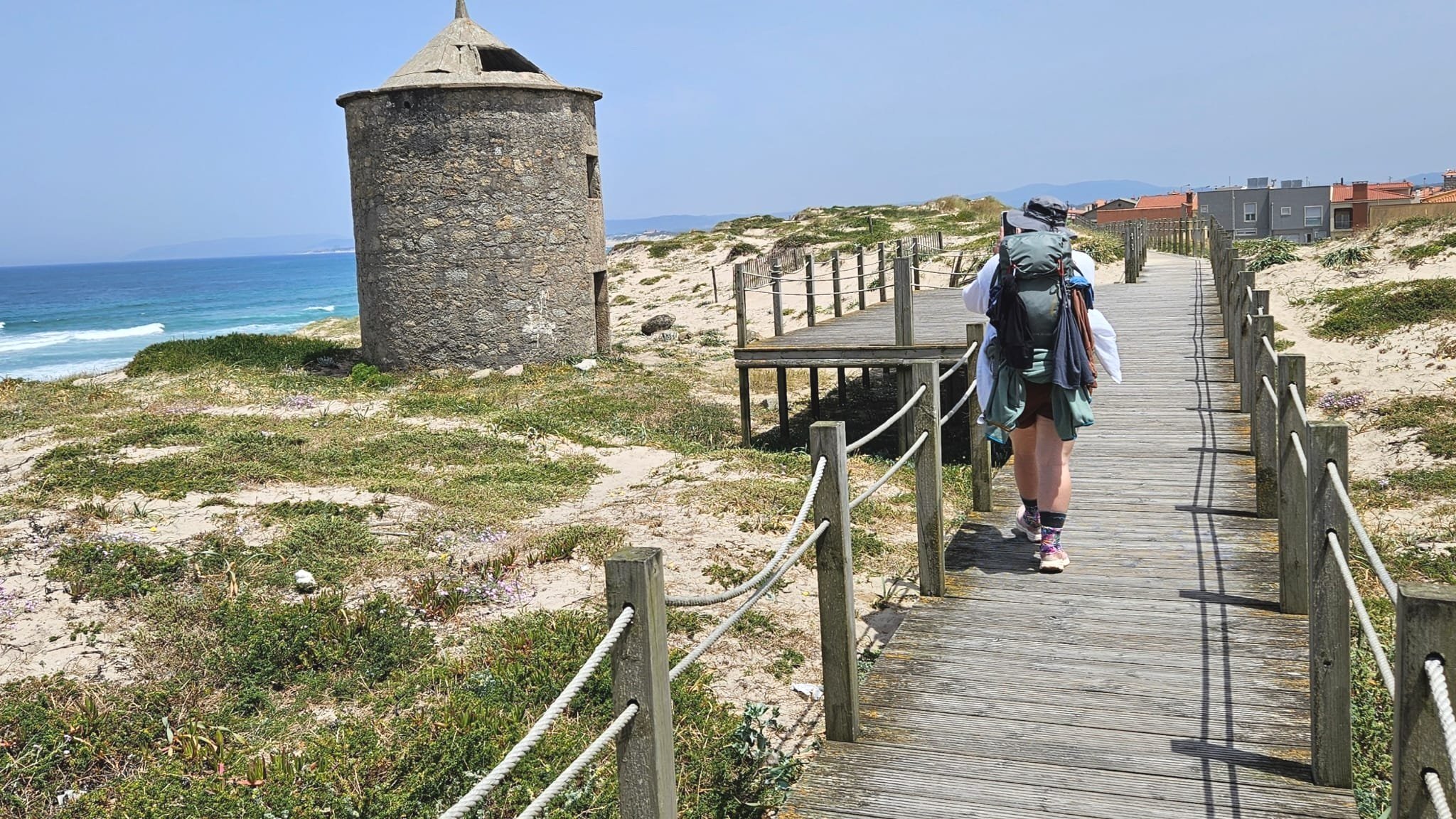
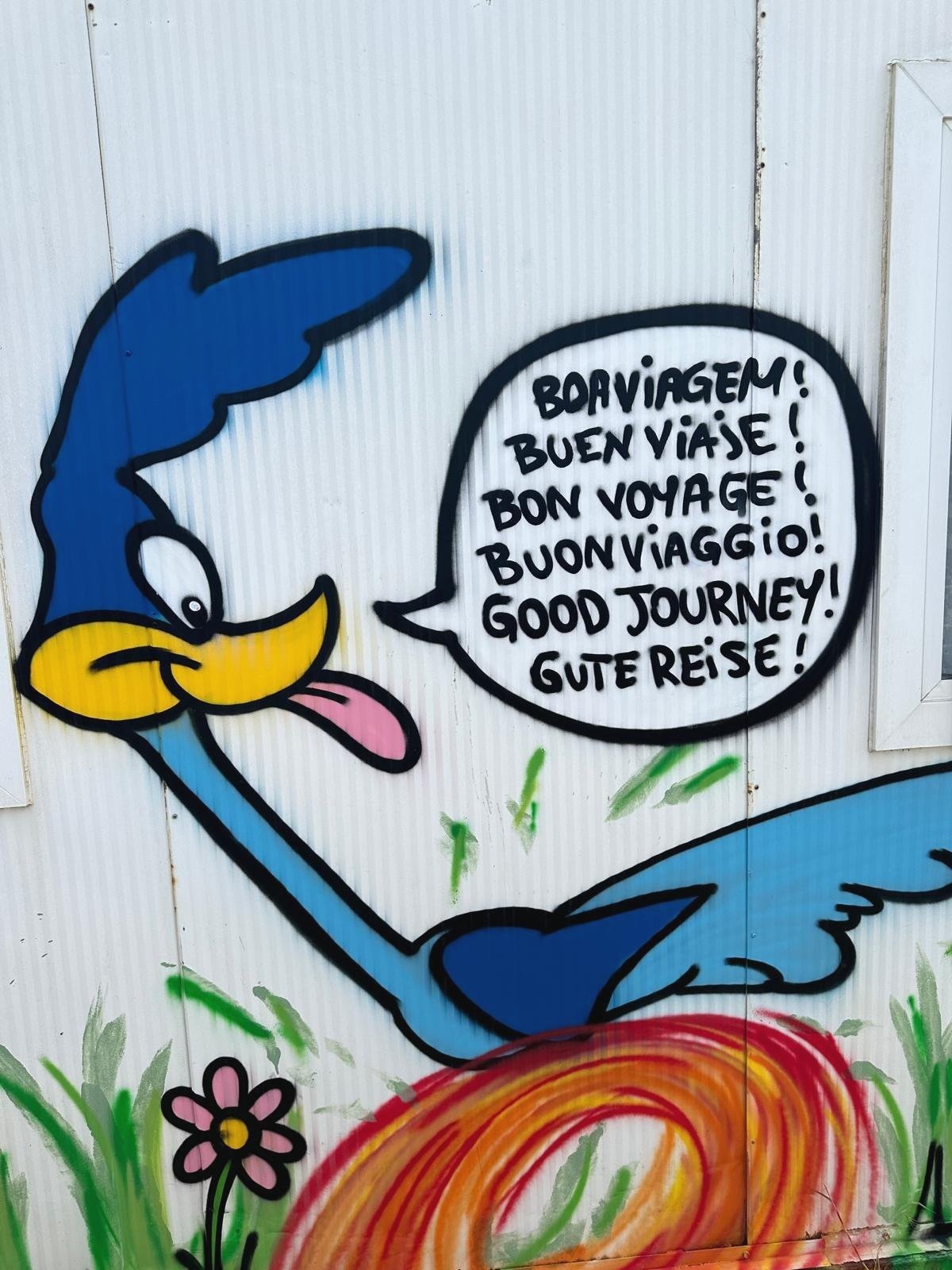
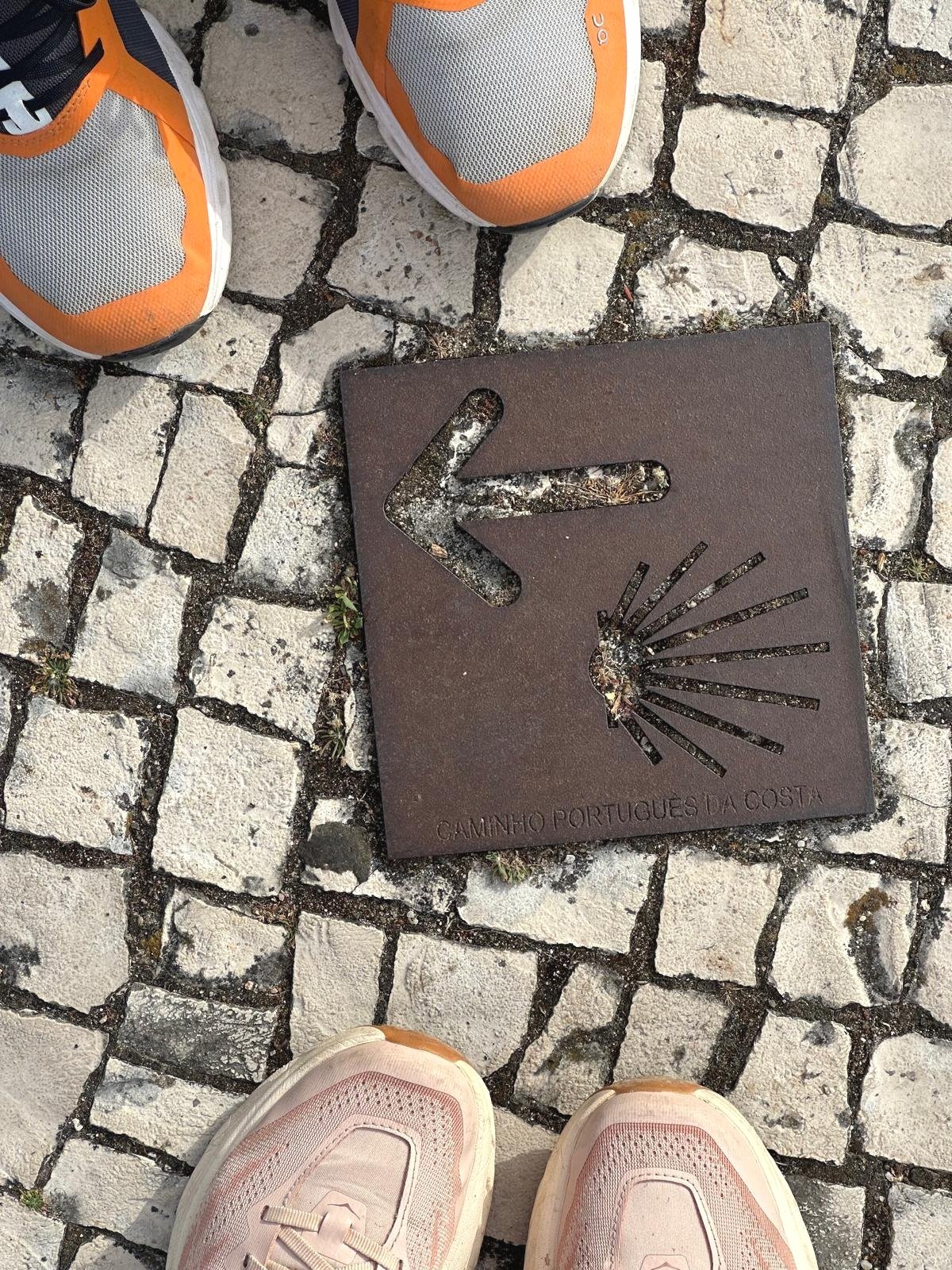
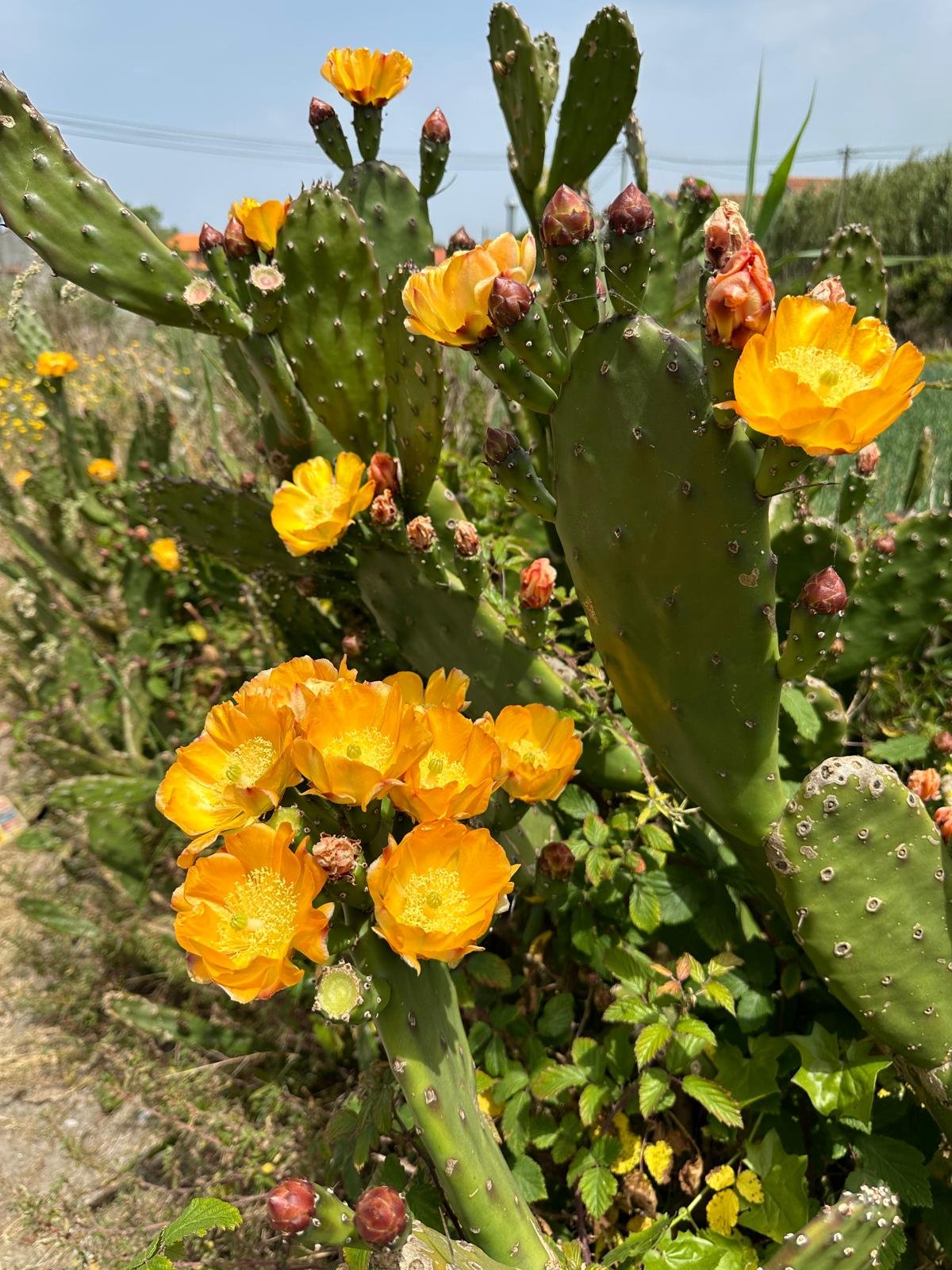
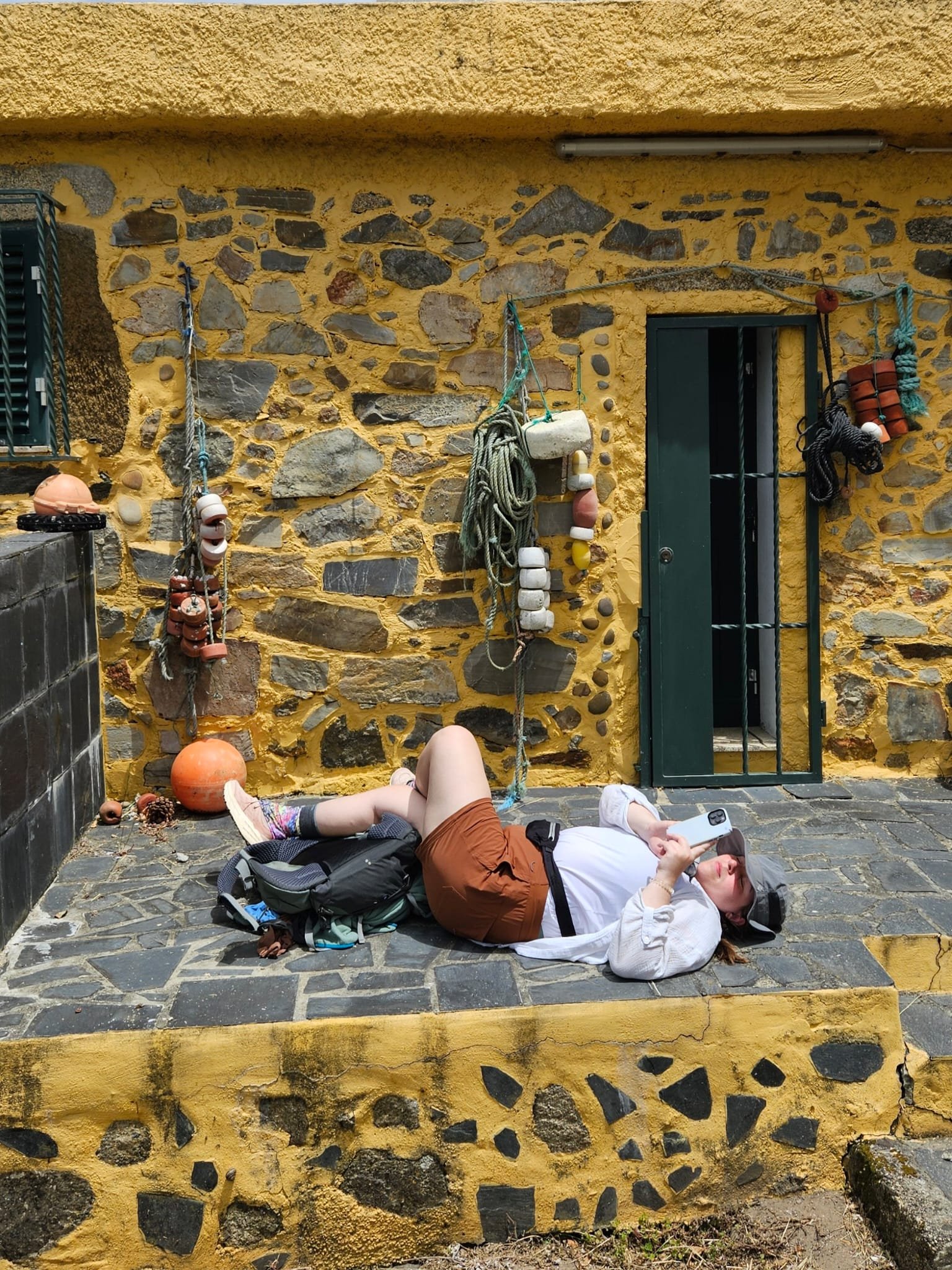
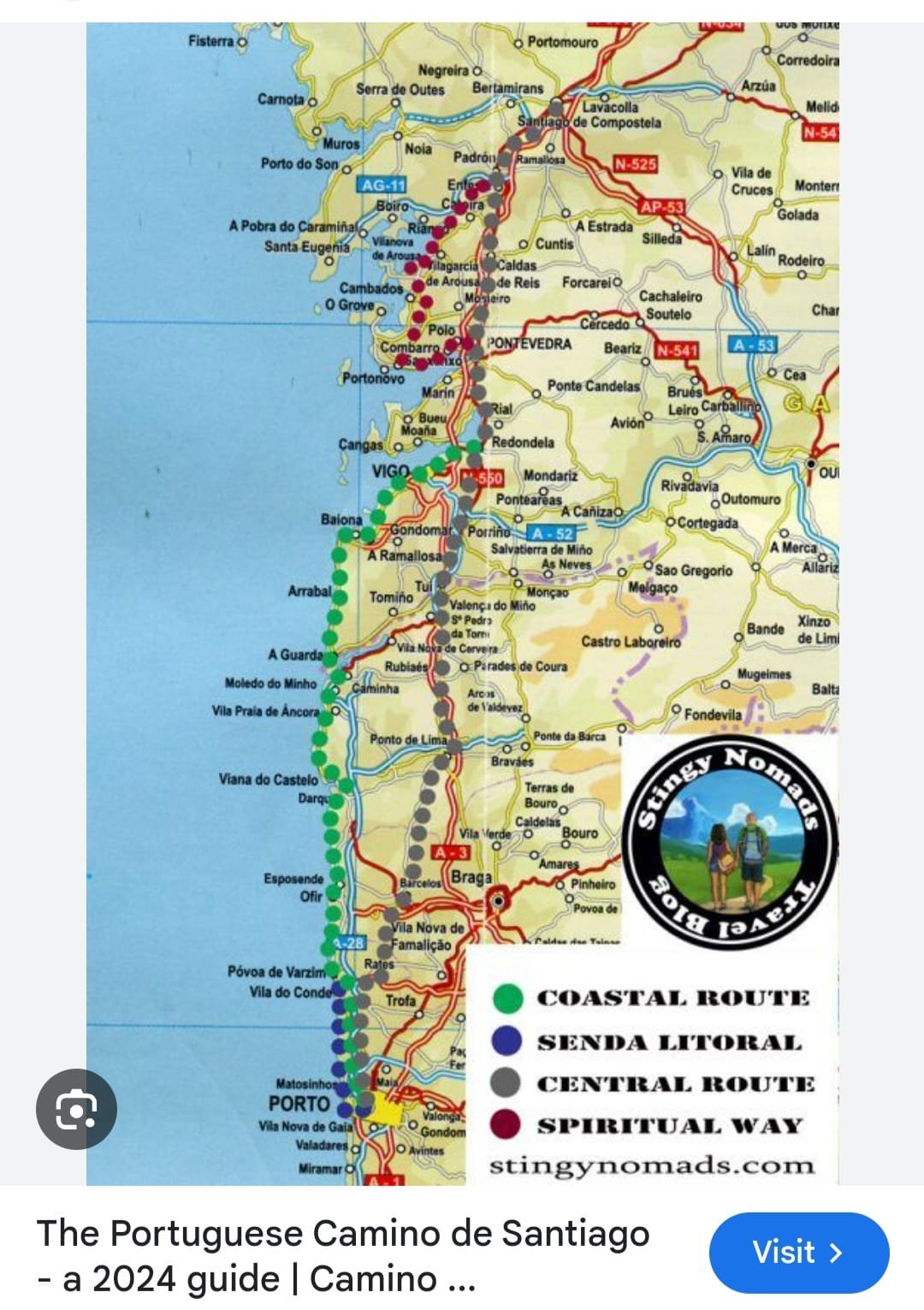
We upped the mileage today, almost changed our route on a whim, bravely battled some foot and calf issues (Jess), and deepened our Camino experience.
Early in the day, before we even reached our breakfast spot, a fellow pilgrim flagged us down. "Speak English?" When we said yes, that we're American, she said she hasn't met many Americans on the Camino. "You'd basically have to quit your job to have the time for something like this."
She and her husband are from South Africa. They talked about an option to head inland to walk through a section of the Central Route. They were planning to take an Uber to cross over to it and invited us to join them. "We love the coast but also the villages and vineyards inland."
We considered it. Jessica ran some calculations on time and distance. We determined it was too much extra walking for what was already going to be a long day. I was proud of us for being open to rerouting. It would have been fun to walk with them for a day.
But we stayed on our Coastal Route and were rewarded with another day of spectacular scenery, lovely towns, windswept beaches, and coastal flora in shades of green, yellow, purple and white. We have been on narrow boardwalks for much of the last two days, offering easy passage through beaches, streams, dunes, tidal flats, fields and forest.
Just beautiful.
We came across many friendly faces today and exchanged many a "Bom Caminho" (Portuguese) or "Buen Camino" (Spanish) with both pilgrims and locals. The feeling of being a part of something bigger is growing.
Another big walking day tomorrow. Our spirits are ready. Our bodies... let's see.
Day 5: Esposende to Viana do Costelo (18.2 miles)
Walking the Camino
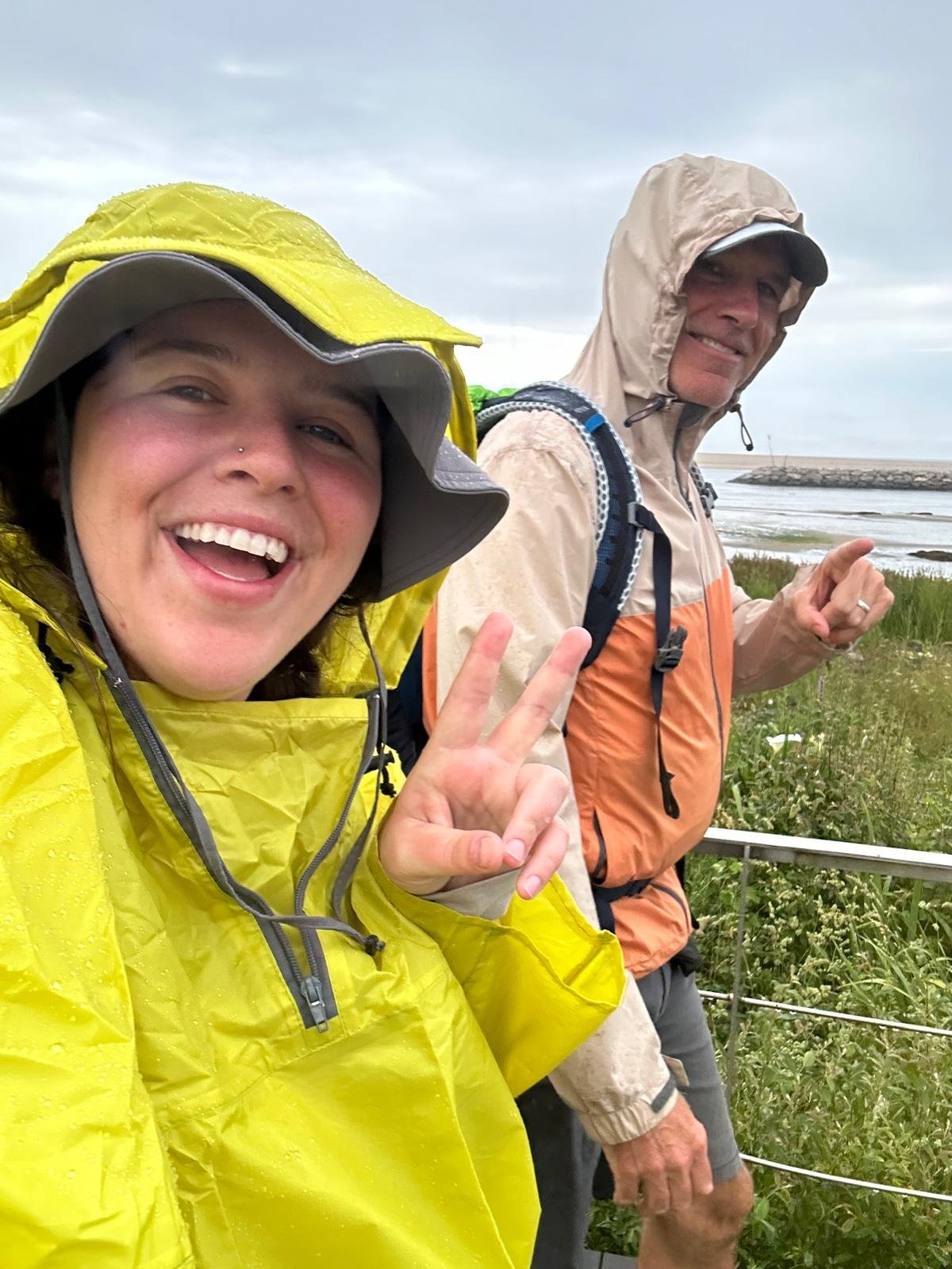
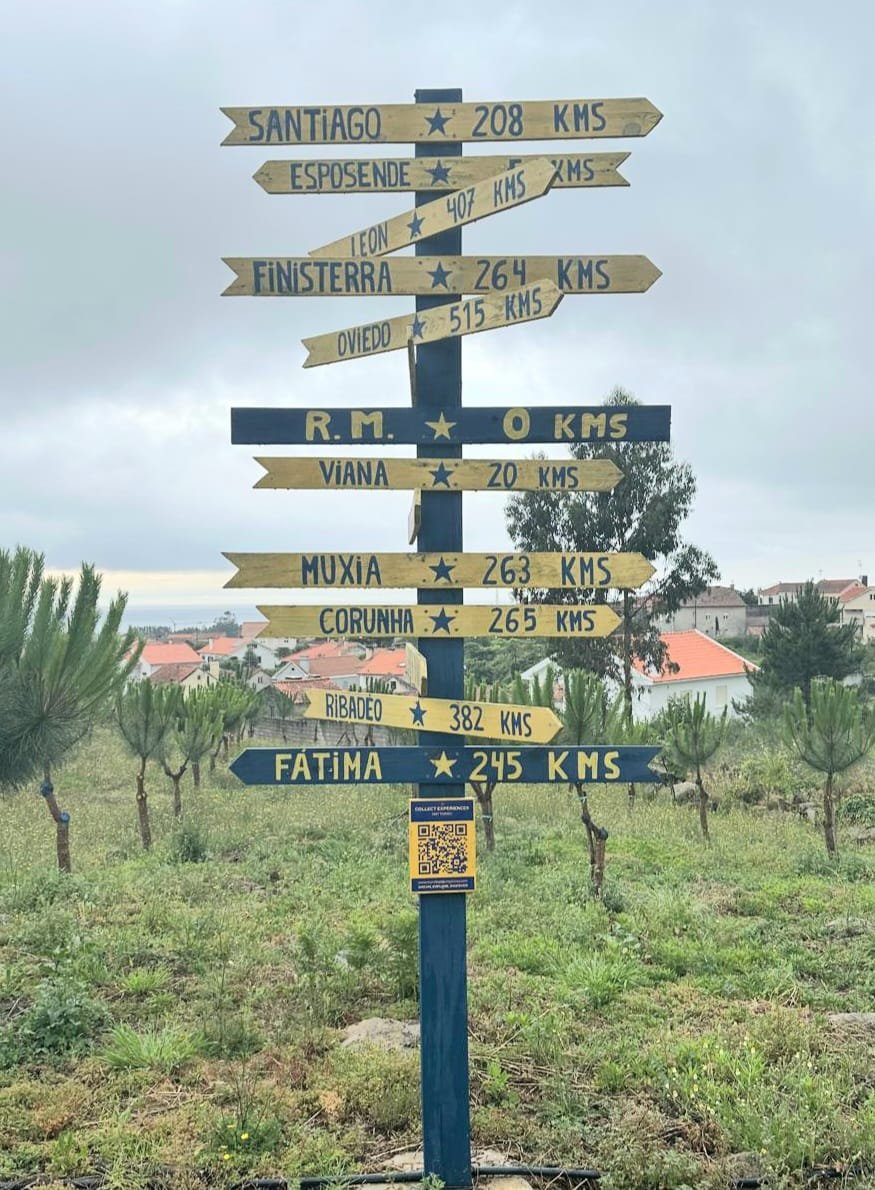

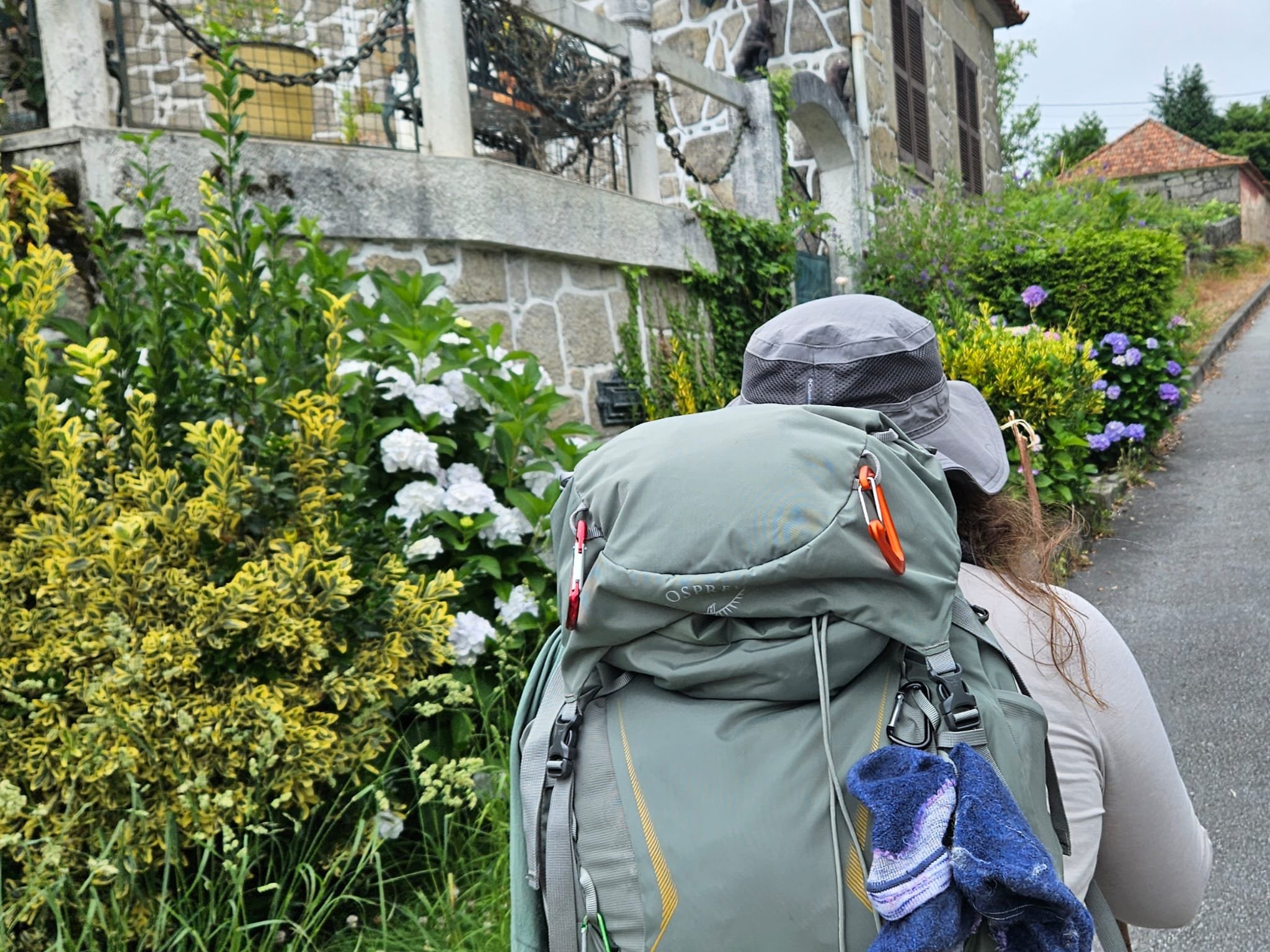
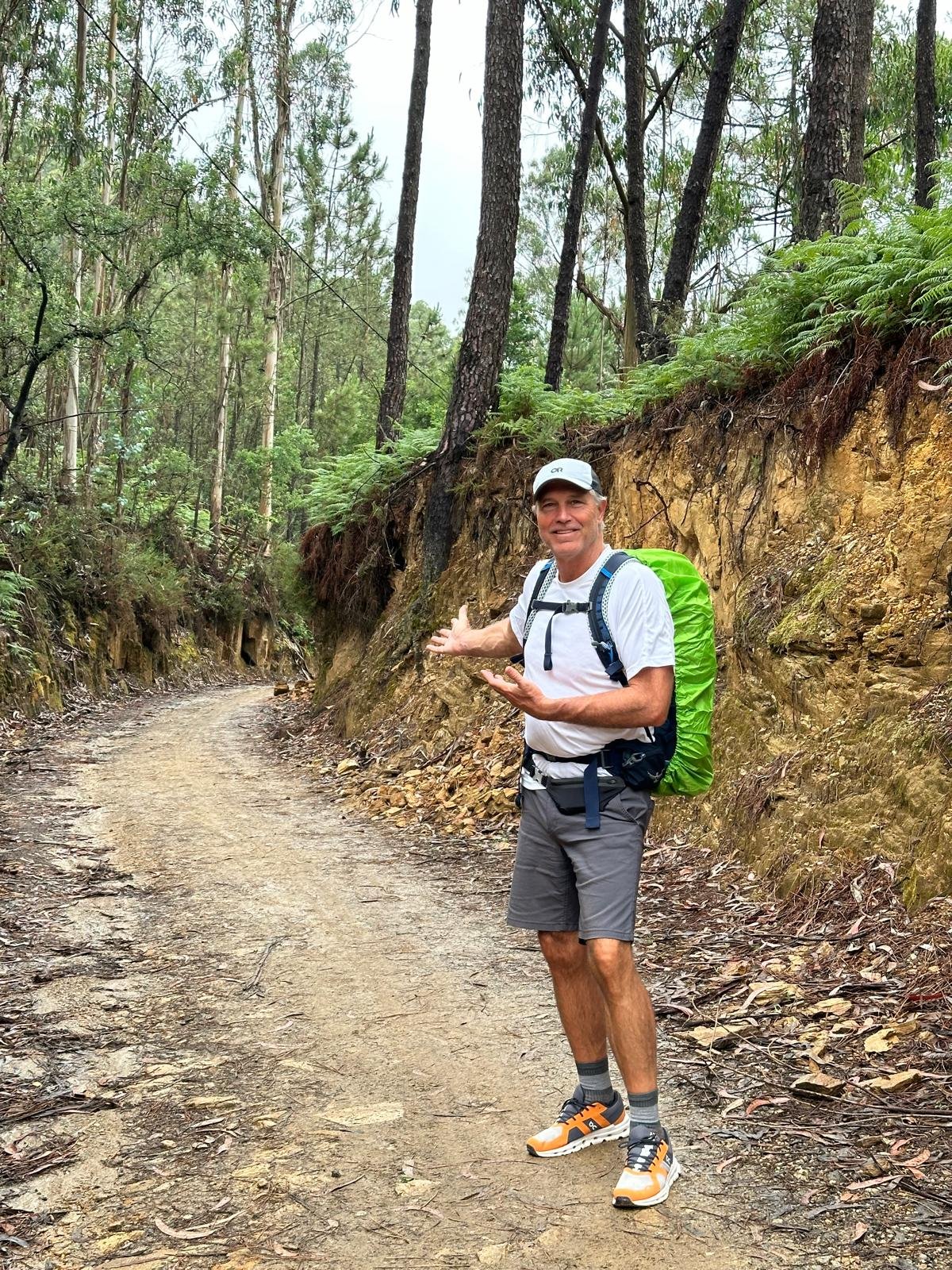
Today we discovered new layers of Portugal, heard stories from fellow pilgrims, tested out our rain gear (because, well, it rained), and found joy in small moments.
First, the trek. We moved ever so slightly off the coast as we continued our way north. There we found old world towns, miles of the most beautiful walls adorned with moss, lichen, flowers and plants, small farm gardens, and oh so cute sheep.
Next thing we knew we were walking a forest trail along rivers, boulders, and waterfalls. It felt like we were on a Pacific northwest hike, except with a mix of tropical and temperate flora. So interesting.
As for people moments, we met "Houston" (my name for the man from Houston). Let's just say he was very Texan. He and his wife stopped at many of the cathedrals. As Catholics, this was central to their walk experience.
It occurred to us that the path marked out passes by many chapels and cathedrals. Some went it. Others like us appreciated the beauty (many are set in a square or themselves create a nice open space) and walked on.
Houston's lovely wife loved to stop, take pictures, and smell the roses. He was always 10 feet in front of her. He confessed to us, "We're so different. I'm a Porsche, I want to go go." He even noted after I checked on Jessica about our pace, 'I'd never ask that!"
As we walked and talked more he seemed to soften. Soon we found them walking together, hand in hand. Jess and I did a fist bump. It felt like just maybe we had spread a little Camino spirit :)
We arrived in Viana around 4:00pm sore (Jess) and hungry (me). We hadn't eaten since a small breakfast at 7:30 and hadn't rested for awhile. We were both out of juice. Most restaurants are closed 4-7 it turns out. We found something eventually... after more time and more walking around. We'll need to pay more attention to mapping our food going forward, and keep taking breaks.
At day's end we found a sporting supply store. Jessica bought walking poles and we both got insoles for more support. We agreed that any investment in foot care is a good one. We also agreed that we deserved an ice cream.
Adding one more quick story that speaks to Camino people and purpose.
We came by a friendly lady from Wisconsin about mid-day. She was alone and walking at a brisk pace. After some chitchat she asked us the why question,
"What brings you to the Camino?"
I shared something like... it's been on the radar for years... we watched a documentary together a couple years back and talked about doing it... I'm in semi-retirement and exploring what this next chapter means...
When I asked her the same question, she said, "Forgiveness."
Pause
"But I won't go into that now. And retirement."
She then said she shares something with everyone she has a conversation with, and gave us each two of these momentos. Then she was off again as quickly as she came. Such a lovely moment.
There is a deeper meaning to this journey for many who take it.
Day 6: Viana do Costelo to Caminha (19.5 miles)
Walking the Camino
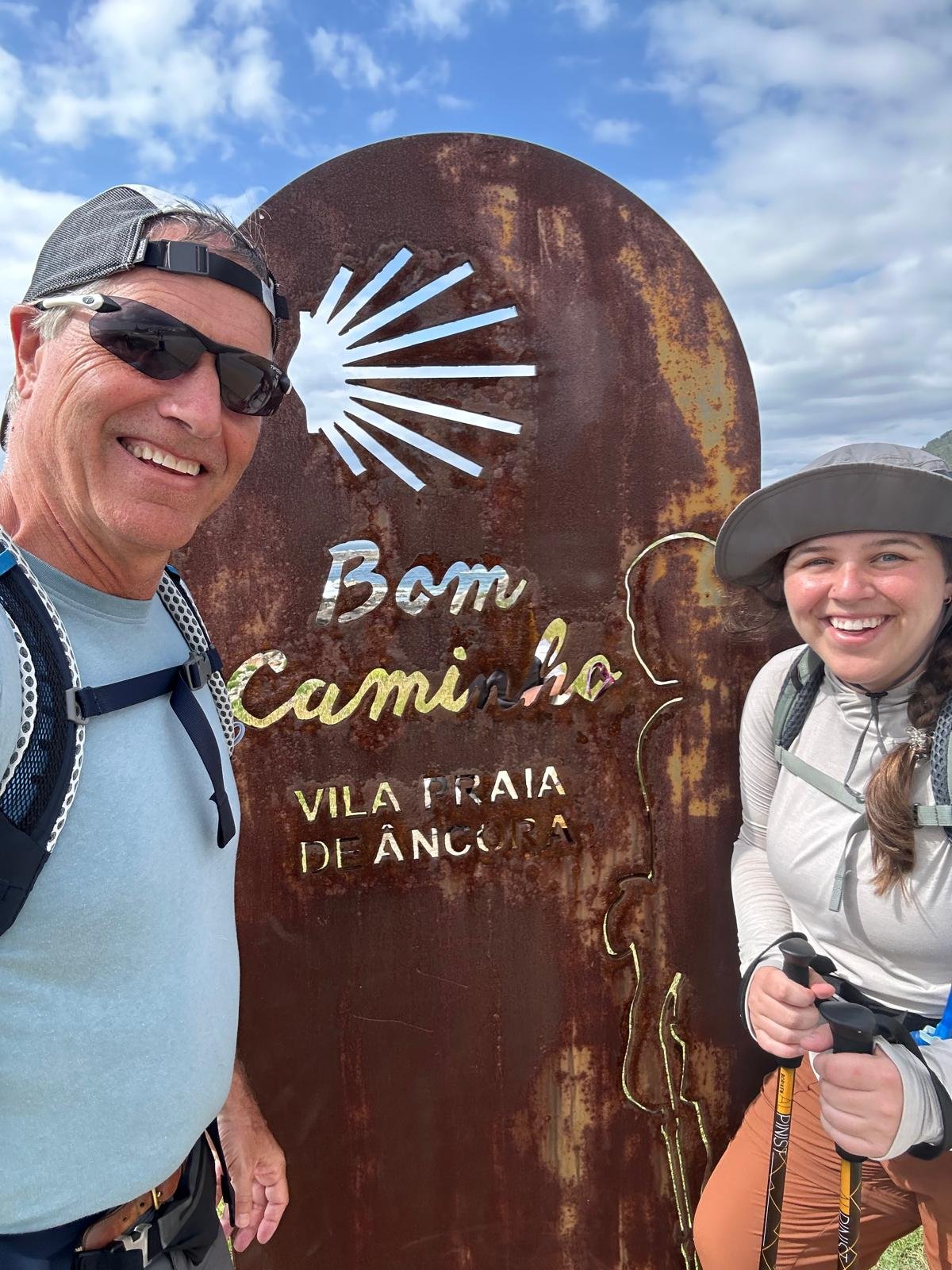

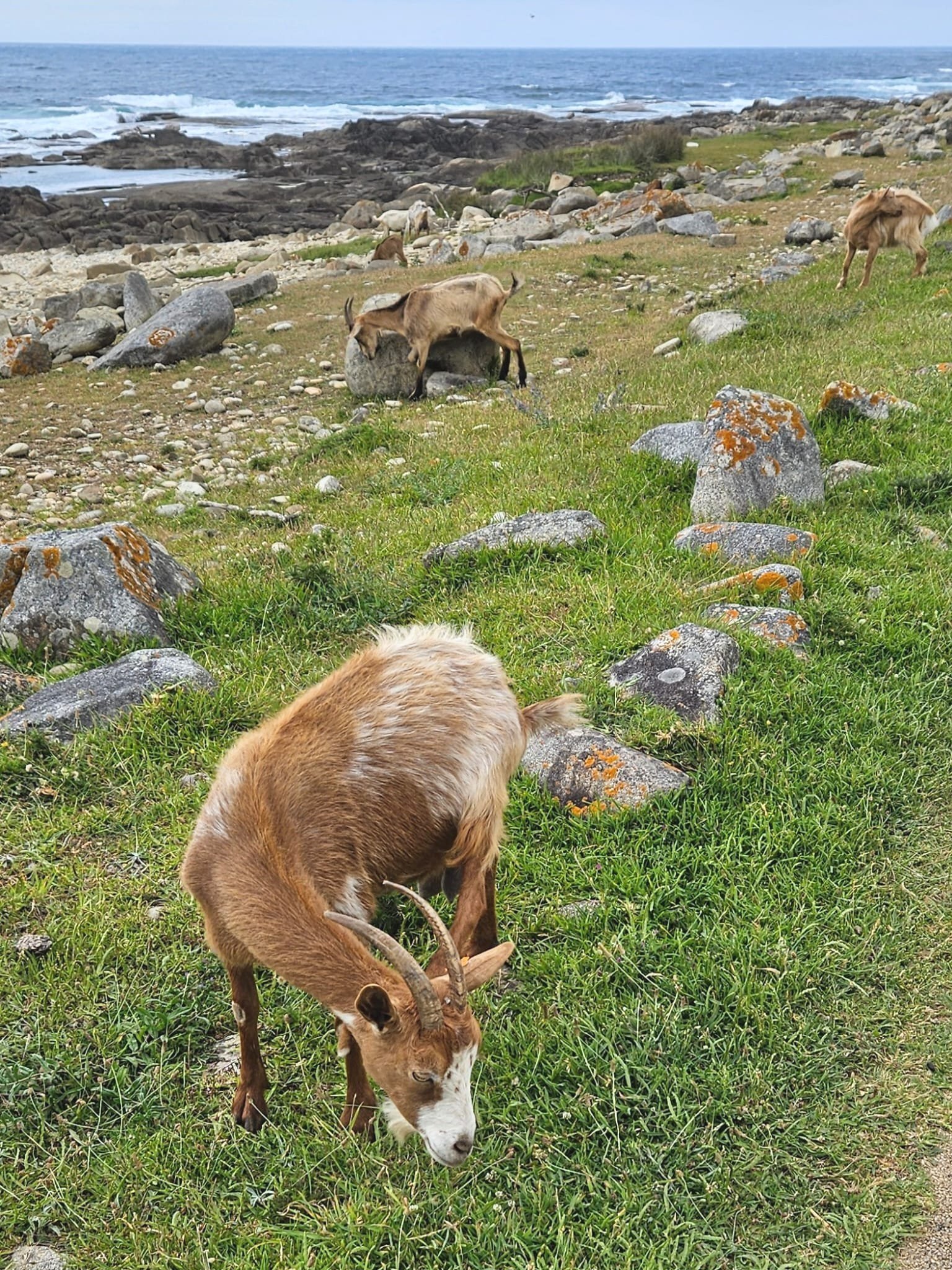
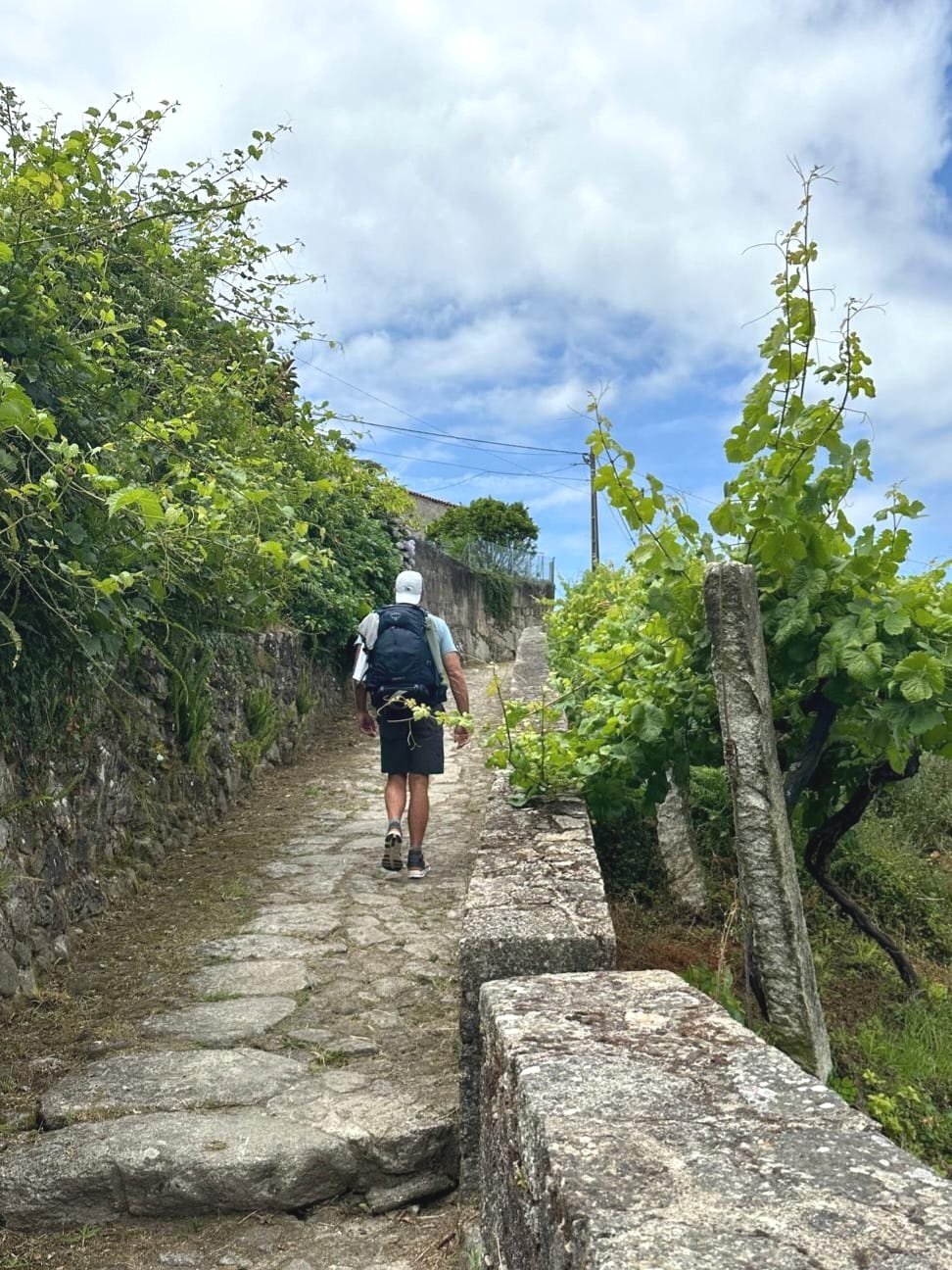
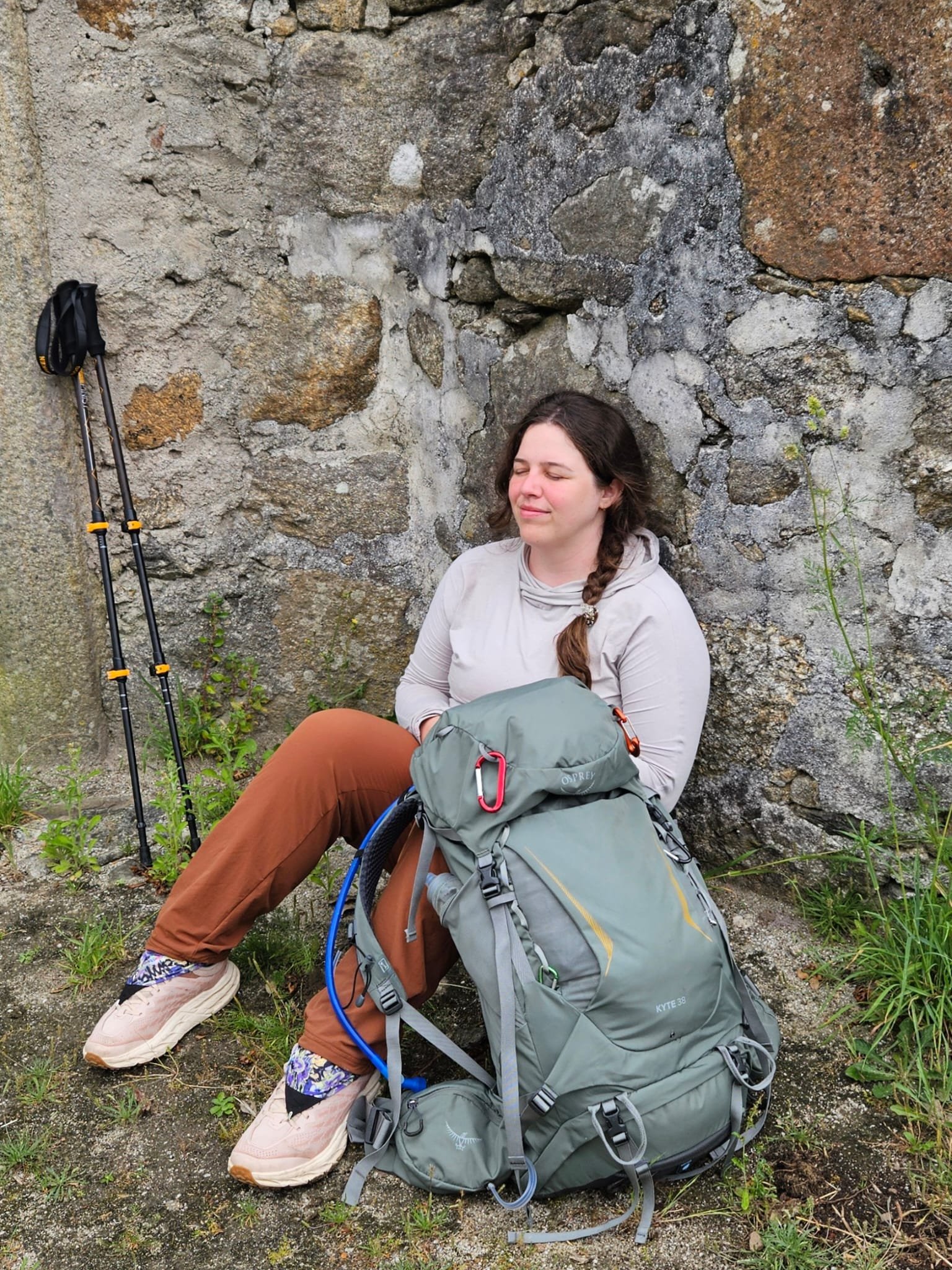
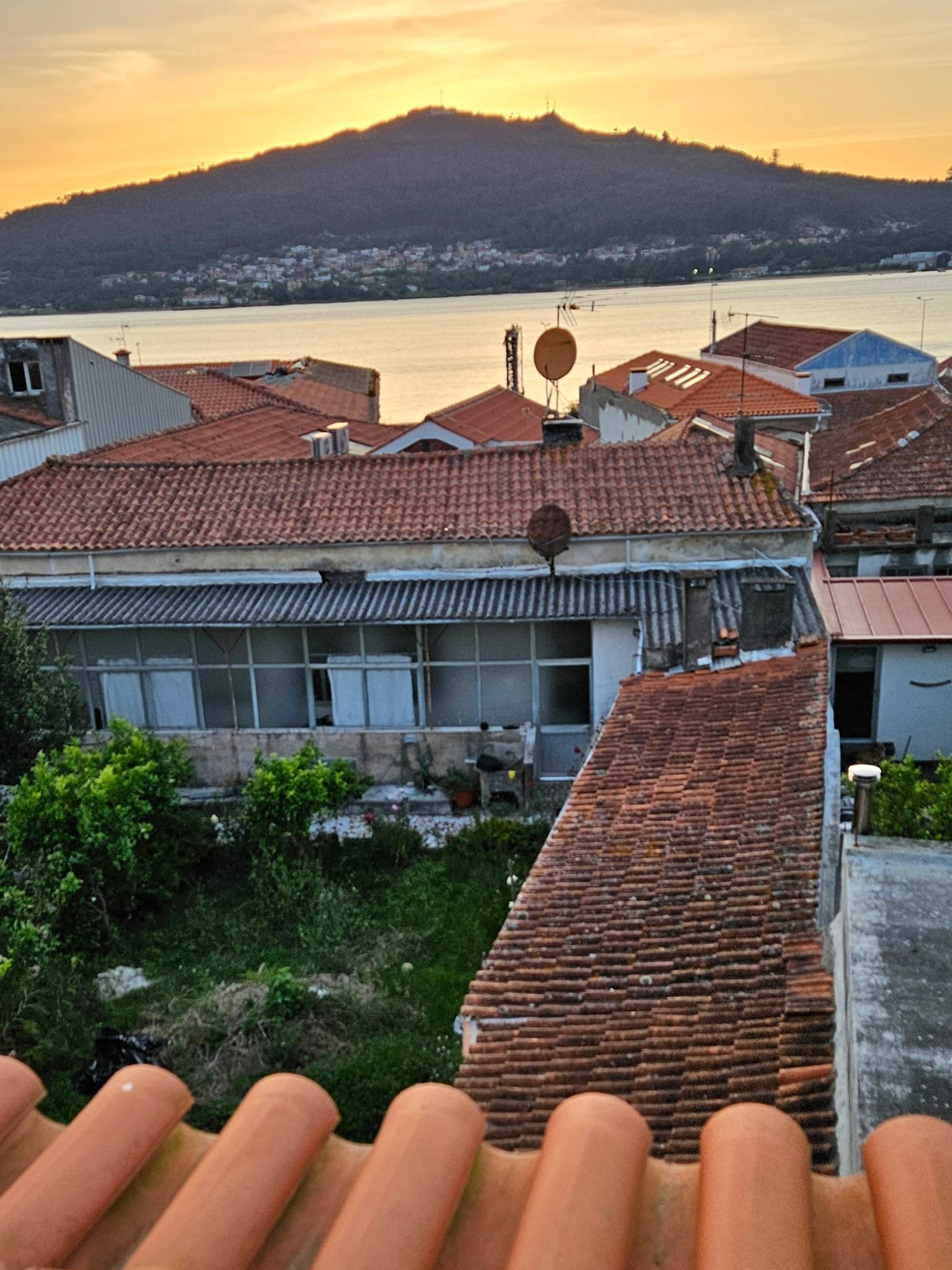
Big day, long day with somehow even the most spectacular scenery yet, fewer encounters, but a day full of charm.
We left our hostel this morning at 7am and arrived at our destination at 7pm. That's a full day on the road! Our pace was slow due to Jess's foot/calf issues and her feeling a bit off this morning.
We ran into three ladies early on--I will call them collectively "Lu Lu Lemon" (you'll see why)--that we encountered at the end of the walk yesterday. I recognized the voices. The volume, the pitch, the pulsing energy.
Last night, their voices were in my ear for nearly a mile on a single-track bridge walkway as we crossed the river into town. They were right on our heels, with Jess at the head of our little pack almost in tears due to the end of day foot pain. On a bridge a mile long they couldn't leave a few feet of space. It seemed to me like they were approaching the Camino like a big aerobics class. Just not the right energy. They passed us quickly today, however, and we bid them a fond farewell.
We walked on cobblestone and pavement most of today, after enjoying more give on the boardwalks and forest paths of the last several days. We really felt the difference of the harder surfaces on our feet and joints. The poles and insoles were a big help, however, and we were able to pick up the pace through the day.
It's hard to describe just how magical the views were as we walked along a long ridge dotted with villages, vineyards and farms, with the rocky coast down to our left and a forested mesa to our right. No picture could come close to capturing what we were experiencing. Which is one reason why we do this.
We made friends along the way with horses, cows, sheep, chickens, a frog, goats, and cats. So many cats. And a little snake (but not a friend).
Our town tonight, Caminha, is the end point of our journey in Portugal. We can see Spain from our room window, across the river. We closed the evening with tapas at a local restaurant and a quiet walk through this very lovely town.
We have fewer miles to travel tomorrow. We are giving ourselves the gift of a slow morning before taking the 10:30 ferry, then walking the way. On to Spain!
Day 7: Caminha to Oia (12 miles)
Walking the Camino
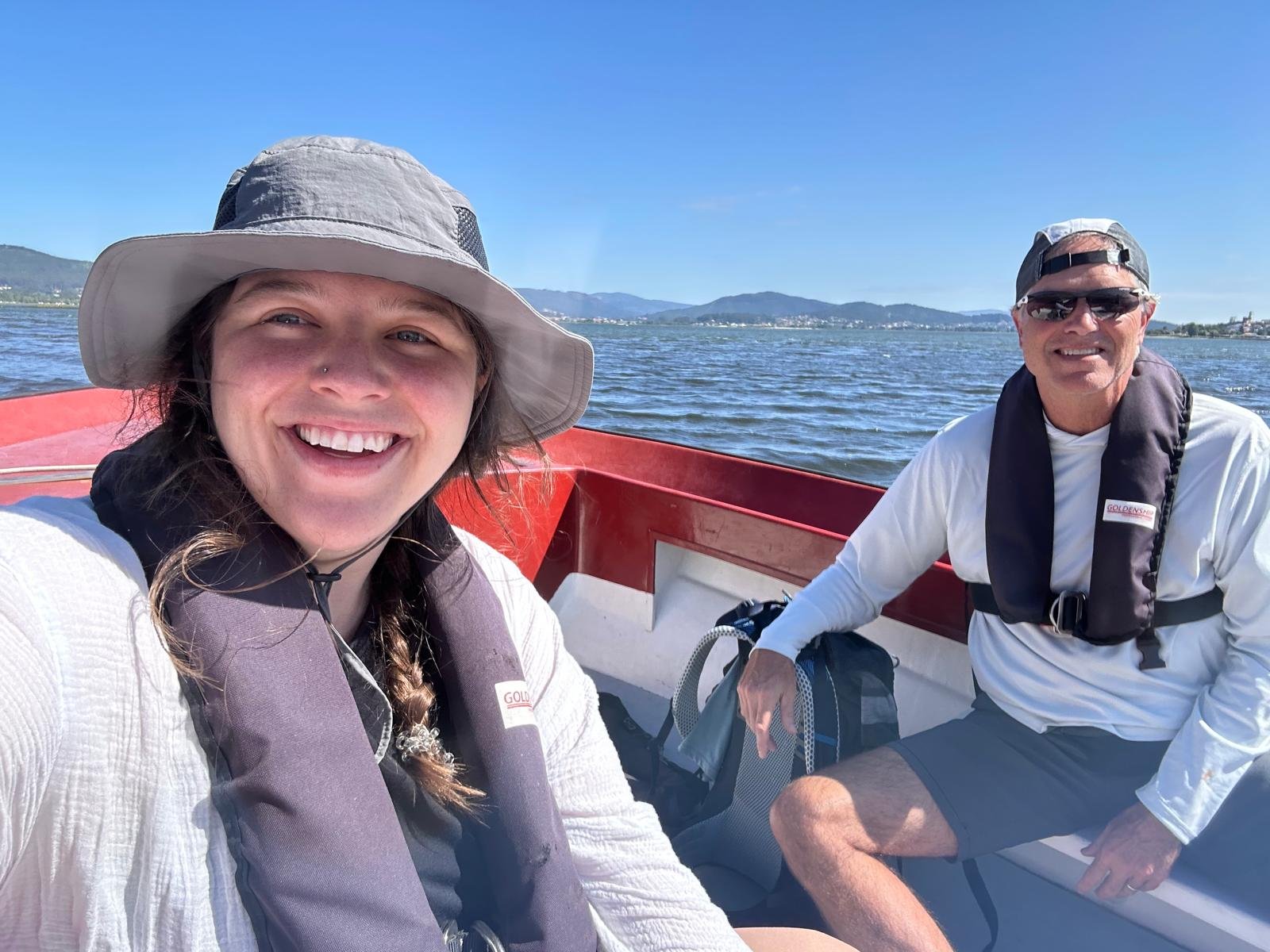
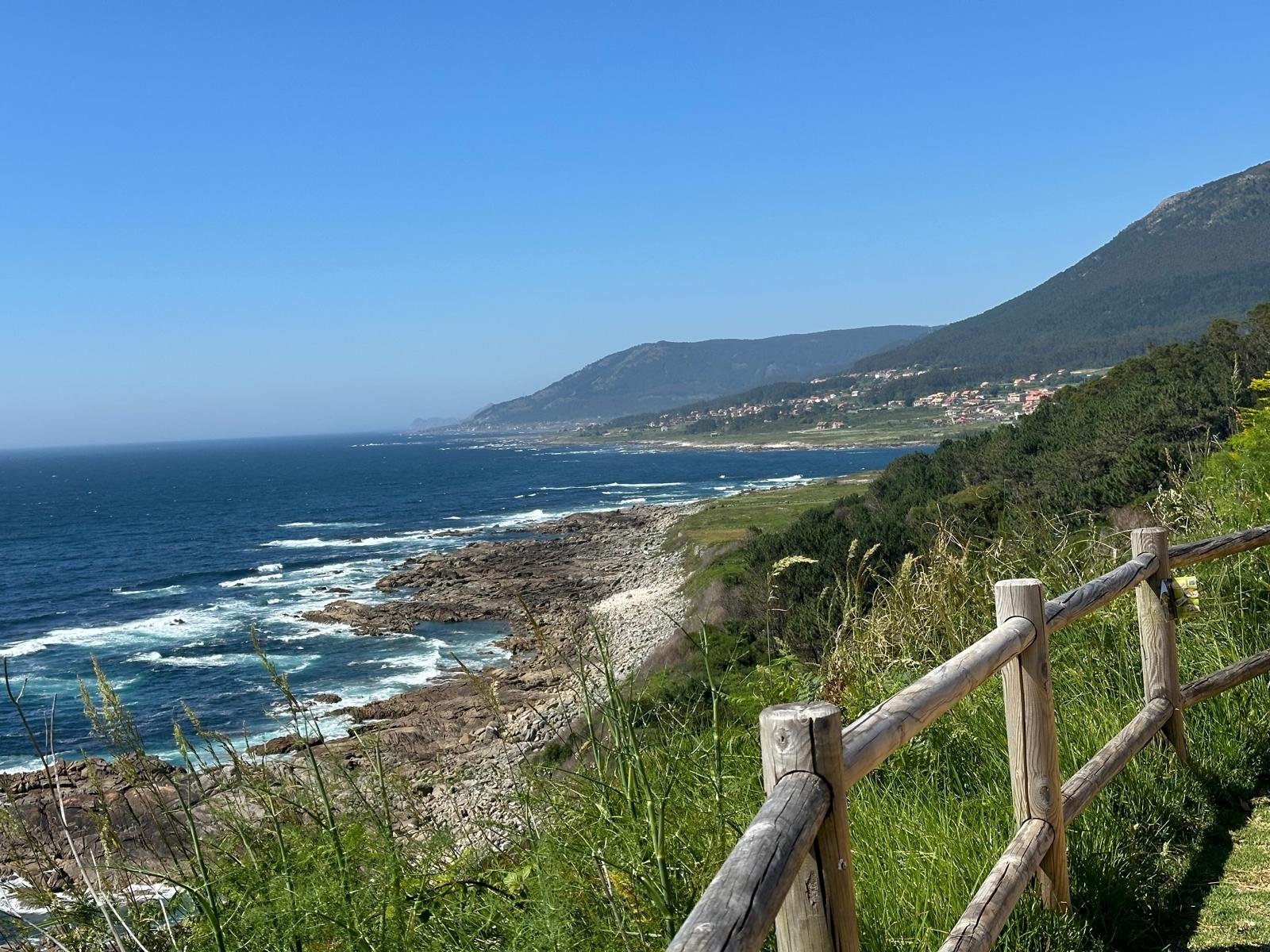
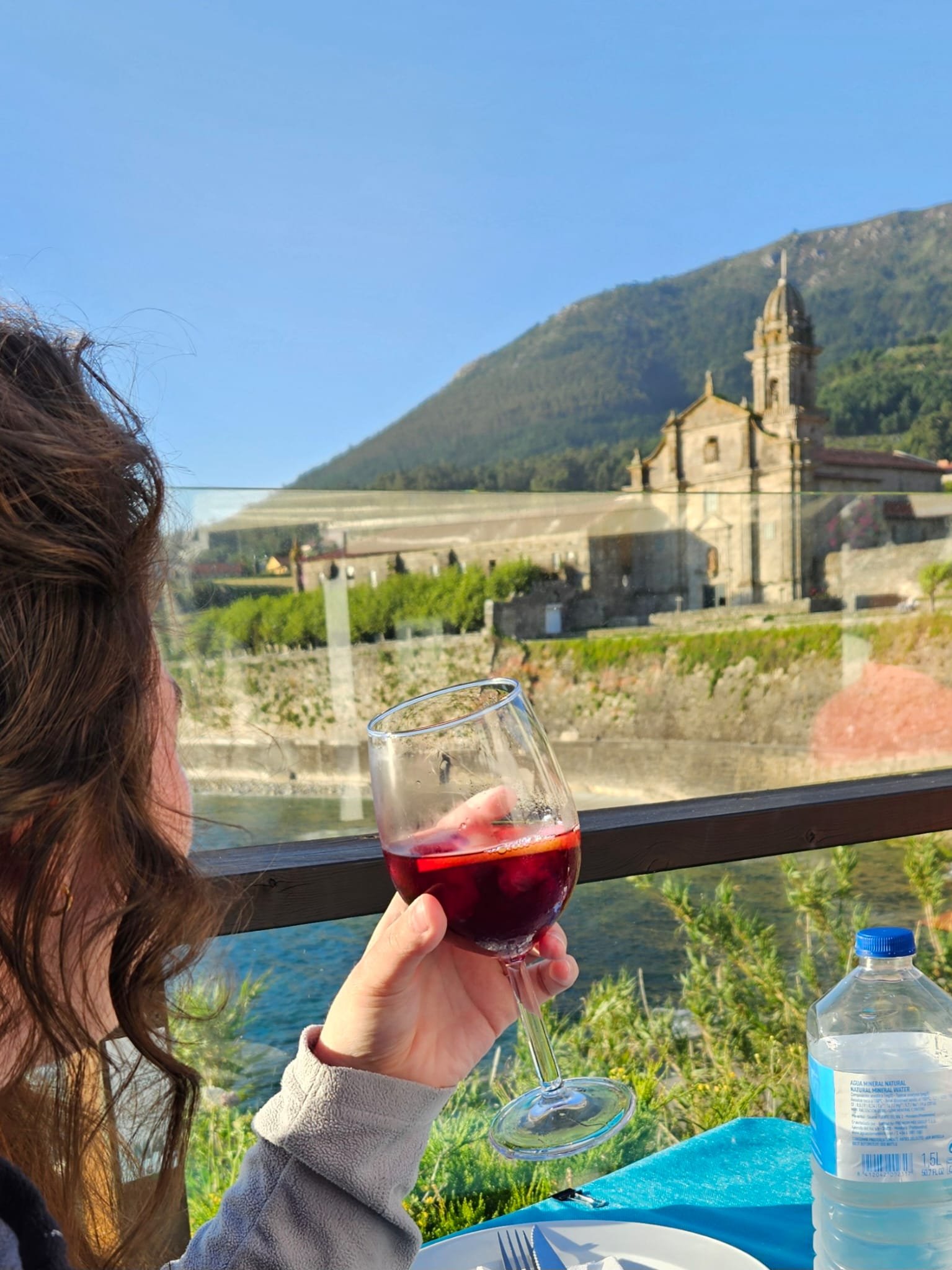
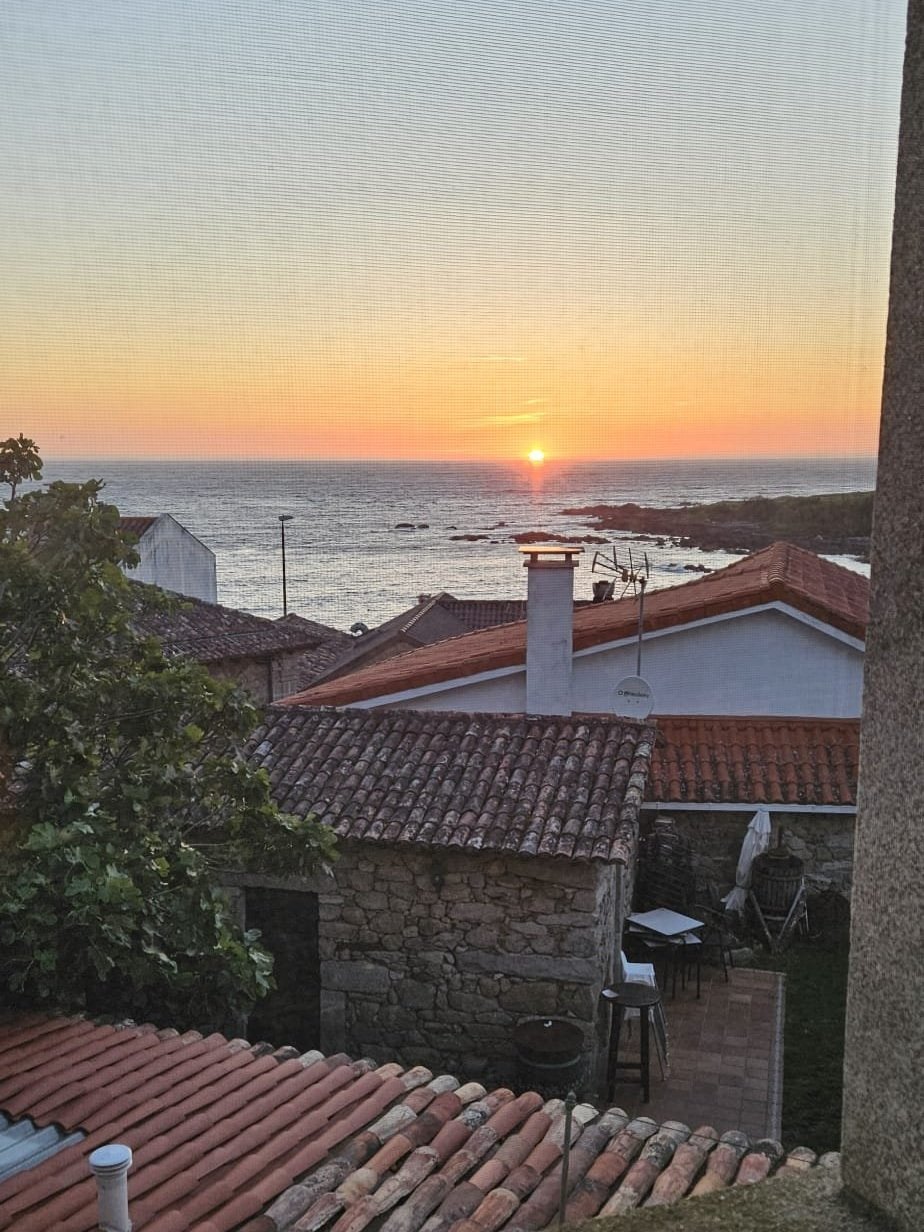
We had our easy morning, meandering down to a cafe for breakfast around 9am. That gave us some time to walk around beautiful Caminha before catching a boat to cross the river. When we got to Spain, we discovered we lost an hour (time change). So our late start got even later. No worries.
Still more coastal beauty, with more of the rugged, rocky shoreline we've seen as we've travelled north. There's just nothing like the feeling of the soaking sun and fresh sea breeze, infused by the sound of breaking waves. So peaceful and invigorating at the same time.
We met Christina from Germany along the way. She climbed out of a wooded slope while we were walking along a road. She had decided to ignore the sign to go up a street from the shoreline at an earlier point, something we too had been tempted to do.
When that trail ended abruptly, she found herself scrambling over boulders to climb her way back up several hundred yards. "I thought it would be nicer to stay along the water. Be careful with your thoughts, Christina," she reflected out loud.
This is her second Camino. She did her first, a 3-week 500-kilometer section of the Camino Frances, 15 years ago. That's considered to be the original Camino route and we've encountered several who've done it. When I asked Christina how she decides when to do it, she said, "Whenever there's a need for a change."
That seems to be the answer for many of the pilgrims we've come across. It's something people talk about coming out of them rather than something that is searched and found.
I like that. It's about stepping outside of normal, quieting all the noise, taking a long, deep breath. It's discovering something in there rather than something out there. I've seen God work in that way in my life. And I pray for this now.
It’s now almost 10pm. We're almost an hour into a lingering sunset over the Atlantic that we are witnessing from our west and north facing windows. The warm colors turn the gentle sea a silver blue, and bathe a 12th C monastery standing guard over the sea in a soft glow.
The end of another remarkable day.
Day 8: Oia to Baioni (14 miles)
Walking the Camino
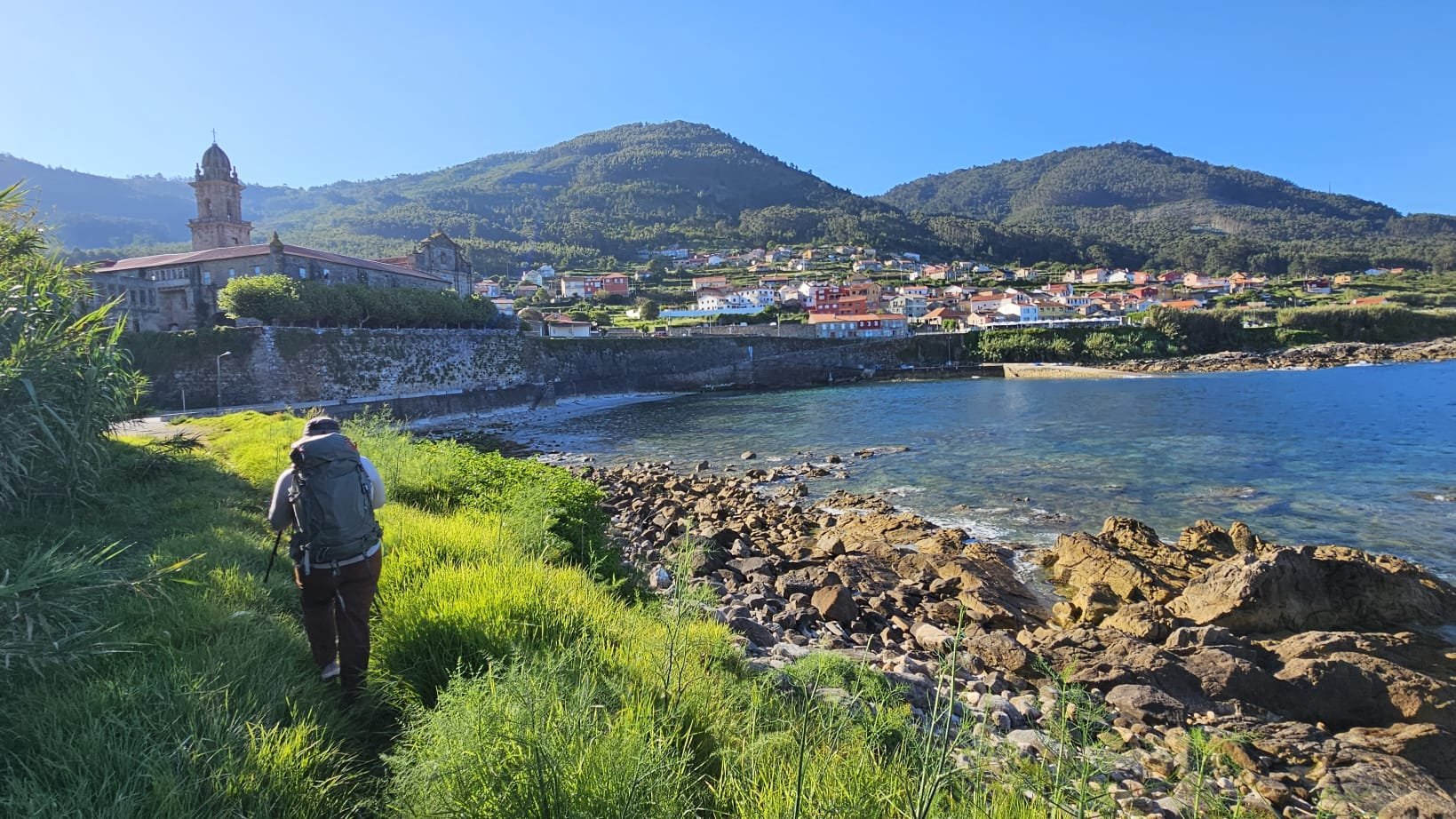


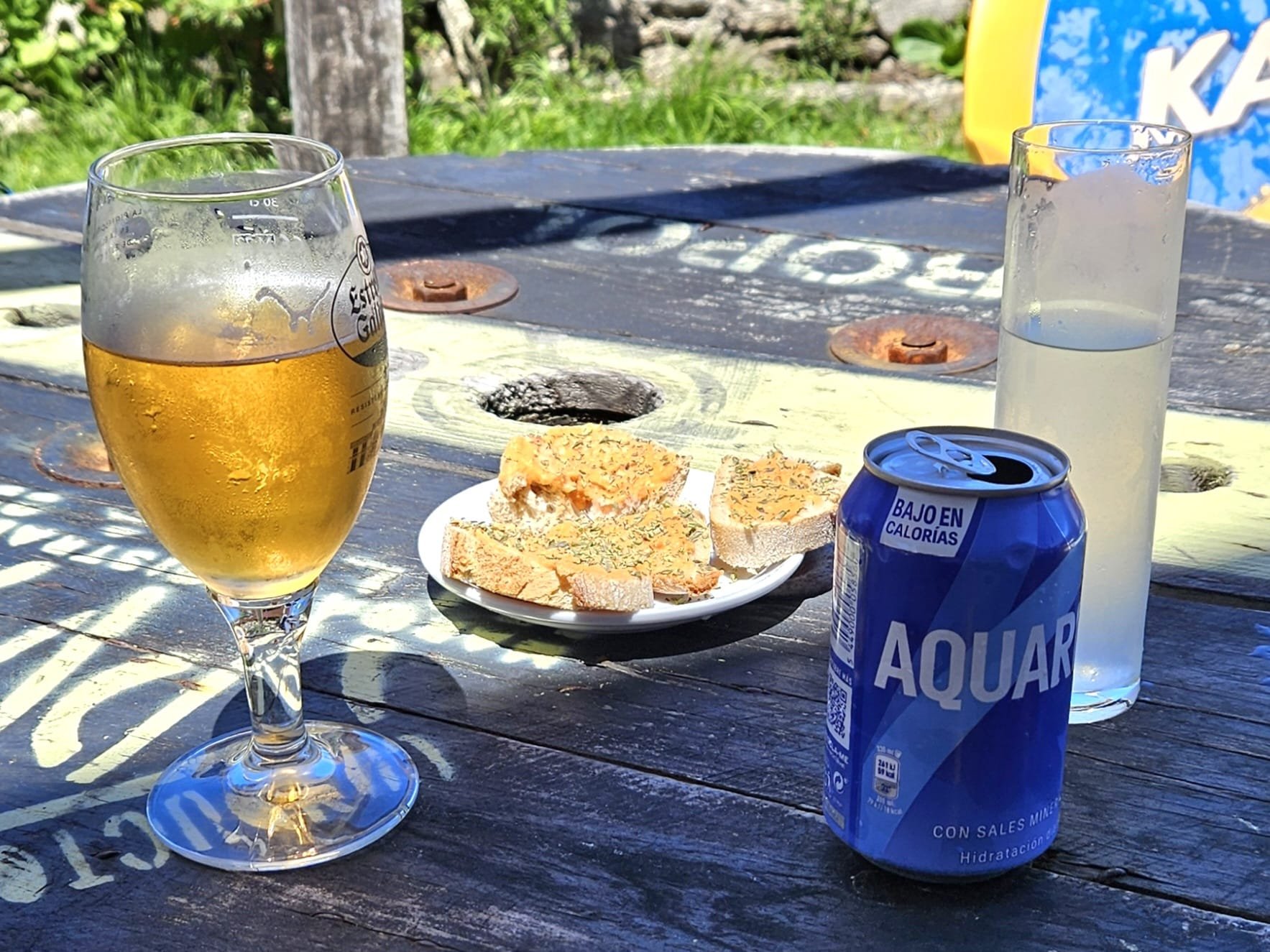
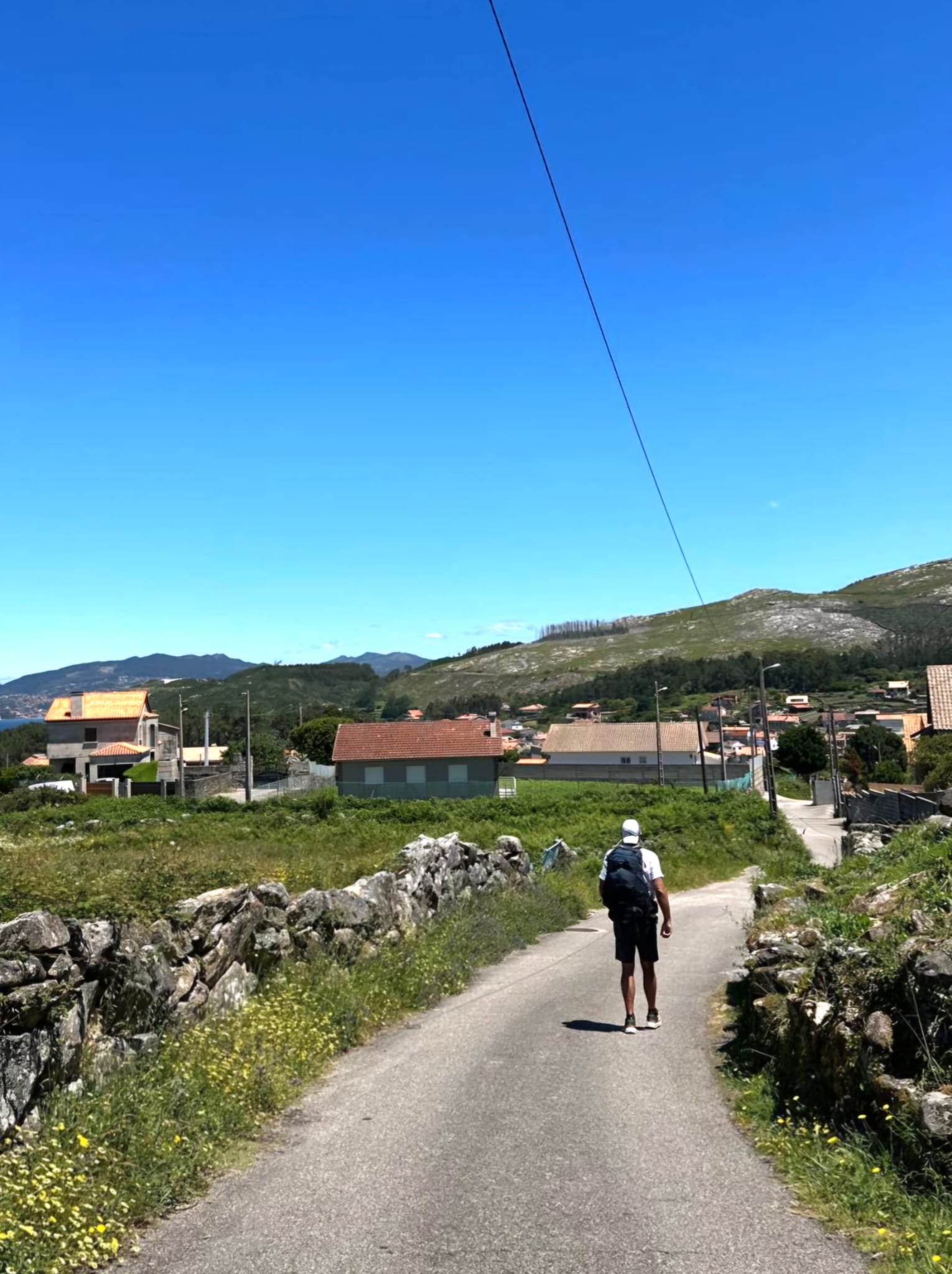
Another shorter mileage day along yet another spectacular coastal route.
After coffee and fresh croissants with Natalie and her mom (more on them later), we said goodbye to the most lovely little town of Oia. We walked by fields of high grass bordered by stone walls all along the shore. We felt we had time travelled into Ireland.
Further up the way we came across Natalie and her mom. They had left before us. At 9 years old, Natalie is the youngest walker we've encountered (that's her in the photo feeding the pony). Her mom had planned to do the walk with her sister in connection to a family wedding here in Spain, but she had to back out. She took Natalie instead.
They had had a very difficult time of it yesterday... taking a longer route that turned out to be too much longer, having a choking incident, and experiencing other challenges that made for a tough day. But you wouldn't know it looking at little Natalie. She was the picture of fresh energy, ready to go for it with her little backpack, headband, walking pole, and "a good smoked cheese" in her pack.
She had a lollypop in as we approached them on the road. At one point her mom said that it (the lollypop) made for some moments of peace. Natalie piped in, "My mom says silence is golden. But if I'm not talking, she's not getting the gold." Love that girl!
Later in the day, just after a big climb up some steep terrain under the hot Spanish sun, we came across A Casa De Peixa. This little cafe off the beaten path provided a refreshing pit stop on our final leg of the day. The owner brought out bread slices with a tomato, garlic and fresh herb spread to go with our cold drinks. Just perfect for that time and moment.
I’m feeling a little extra sore, likely due to the steep climbs today. We self-medicated with a summer salad, grilled sea bass and entrecote steak at a waterside restaurant. It worked well! Need get good sleep ahead of a big walk day tomorrow.
Bonus pic
Camino passport with stamps from all our stopping points
Day 9: Baioni to Vigo (18 miles)
Walking the Camino

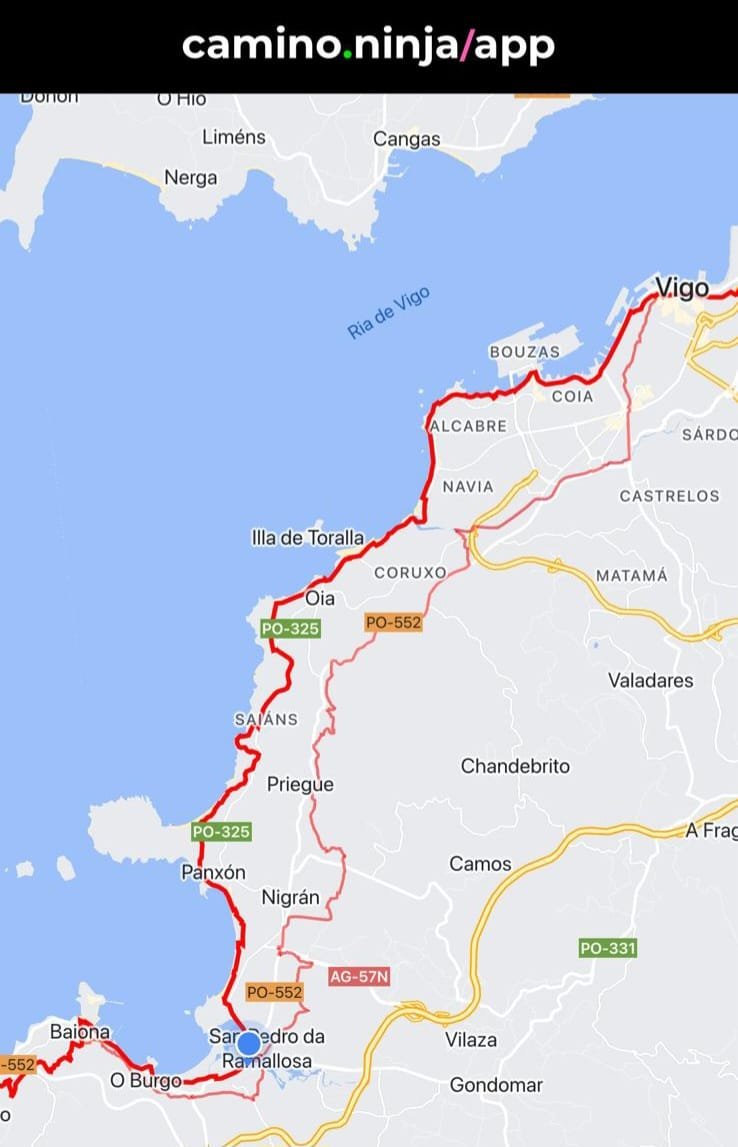
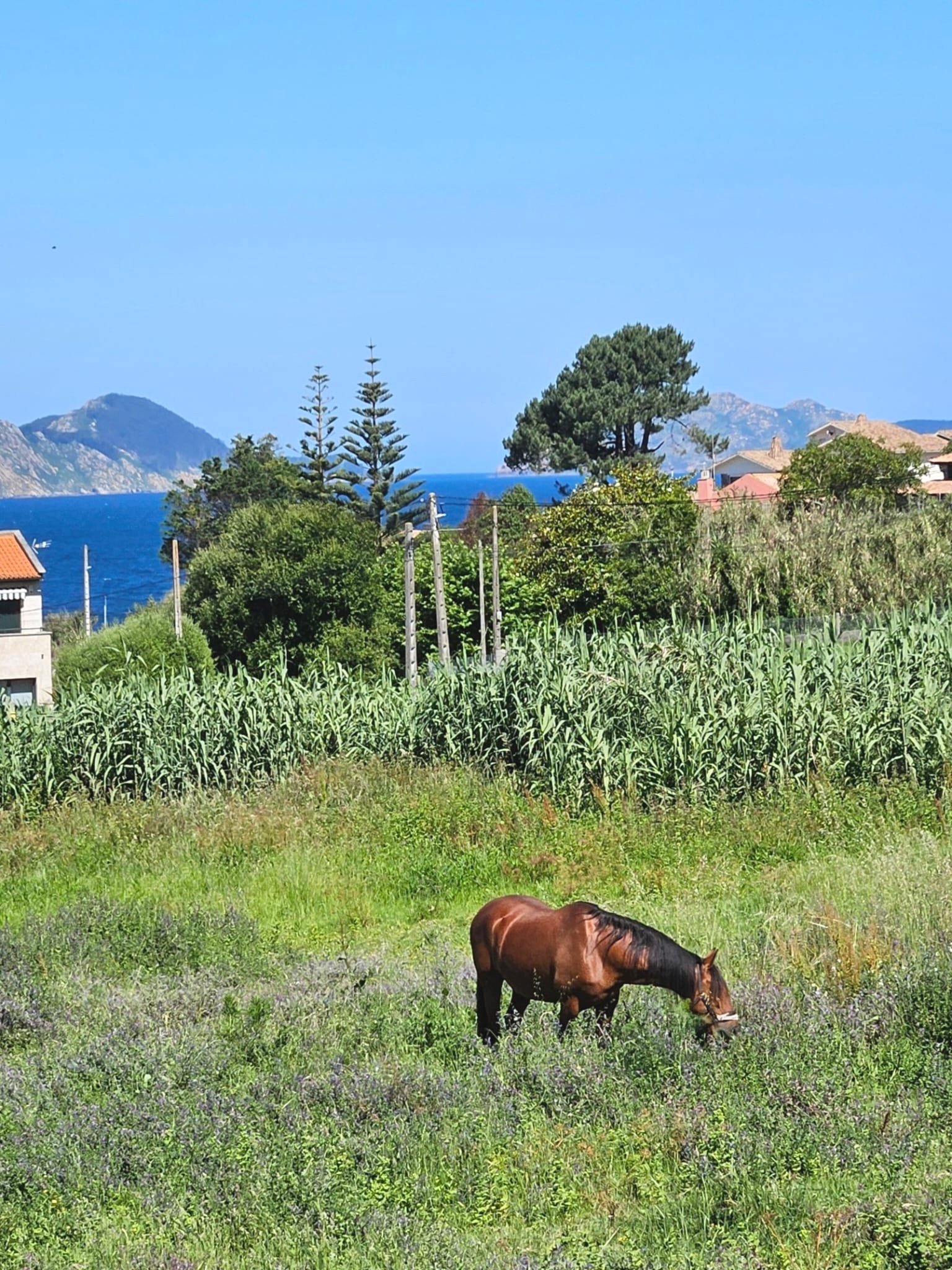
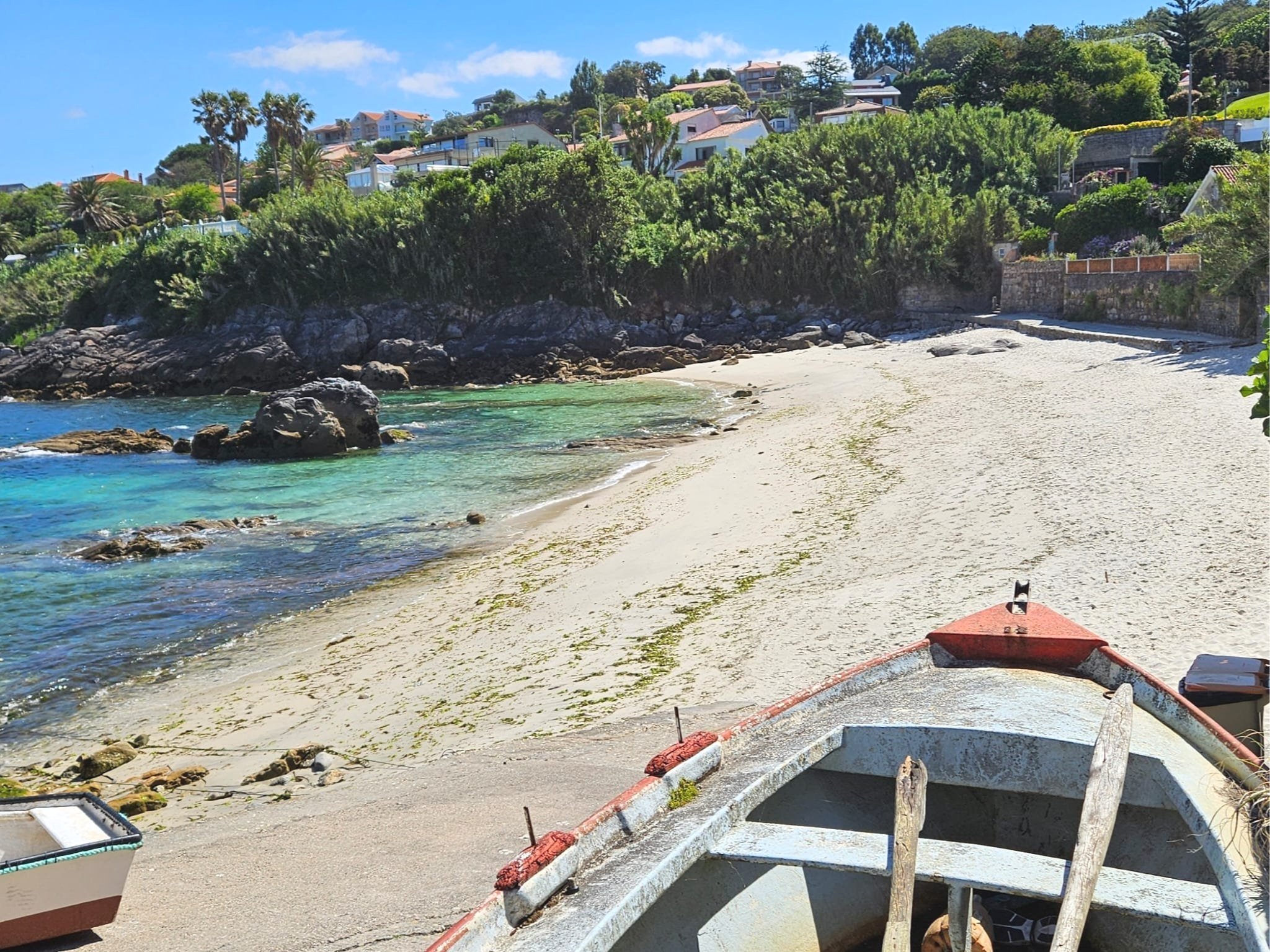
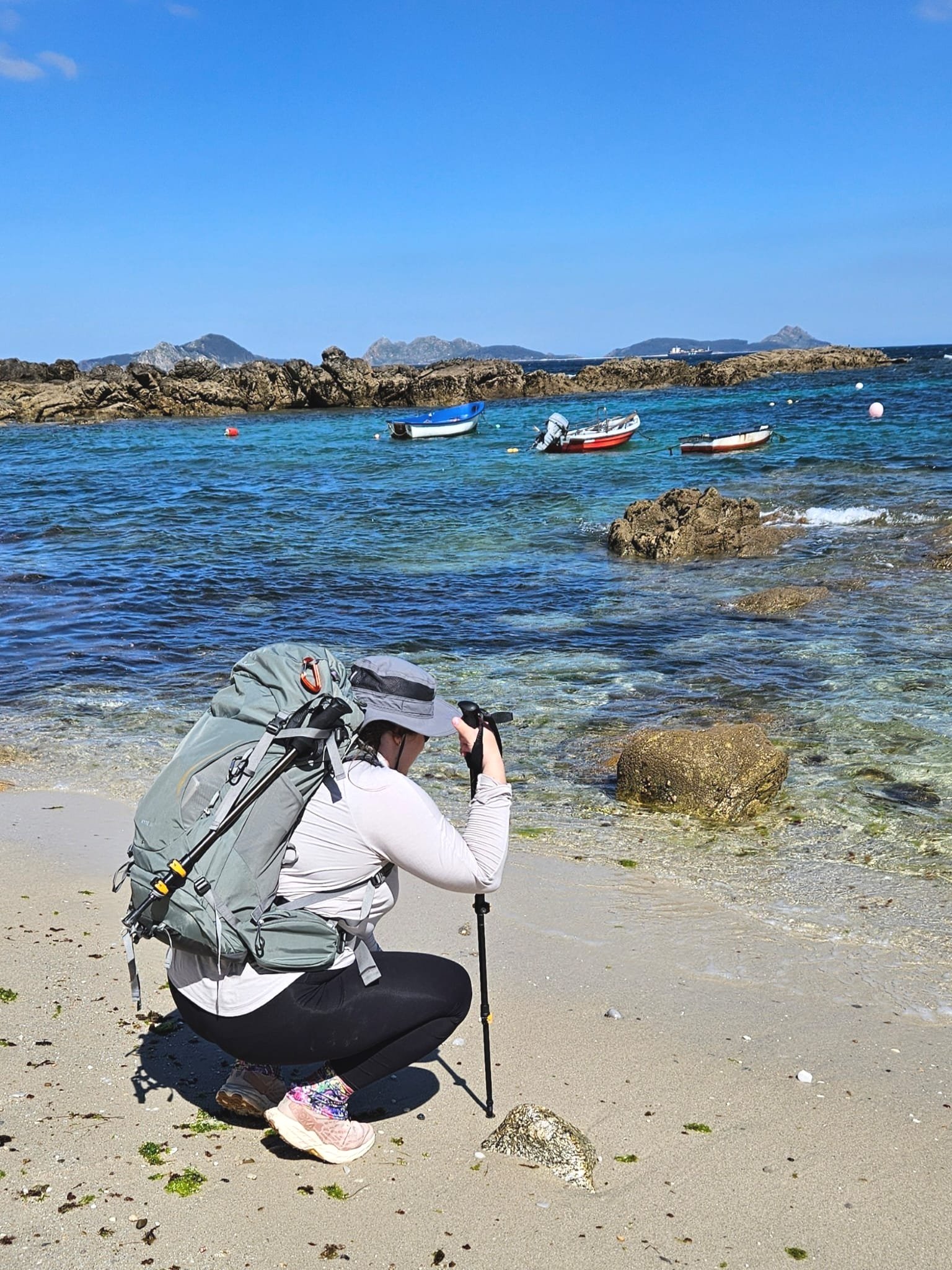

Well, we had an interesting beginning of the day. Blame the 7am sunrise start. We realized about 10 mins out that we had left protein yogurt shakes in the fridge at the hostel. That was supposed to be our power up for a big walk day. We were bummed.
Then, about an hour and a half out, Jessica wondered if she had left a piece of clothing hanging in the bathroom. The good news is we figured out she hadn't done that. The bad news is we realized we both had, in fact, left several pieces of clothes hanging on an outdoor rack. After some quick calculations we concluded we still had what we needed, barely. So we pressed on.
The Coastal Route went a bit inland today, with 600 meters of elevation. We chose instead to take the Litoral Route, which hugs the coastline. Litoral means coastal in Spanish and Portuguese. Go figure. This was about knee joint preservation.
We've developed a couple of maxims over the past few days, life lessons from experiences on the trail.
One is Christina's Paradox. Do you remember Christina? She's the woman from Germany who decided to keep walking along a coastal road even though the Camino arrows pointed up to join the main road above. She made a choice based on what looked like a better alternative, but turned out to be a dead end.
We fell into a Christina's Paradox situation today, in fact. We decided to try a very inviting path down to the shore to walk along this amazing beach, parallel to the Camino path. But we ran into a waterway that cut across the beach and had to turn around. That, my friends, is a classic Christina's Paradox.
Then there's Natalie's Folly. Natalie, you may remember, is the sweet and spunky 9-year old walking with her mom. She's all full of energy, can be easily distracted, and is ready to do anything. Lauren, Natalie's mom, was all too happy to indulge Natalie’s desire to explore every path and curiosity along the way. I’m sure that led to some wonderful moments. But on this day, they took so many side trips that they ran out of water, food, and energy. They had to take an Uber to make it to the hostel. The very long and difficult day left Lauren wondering if they were able to do this at all.
Natalie's Folly is just over the horizon of curiosity and ability. We too wanted to be playful and flexible, to explore the hidden paths. And we did. But there’s also the need to keep a pulse on the day, the mileage, the feet, food, and other pragmatic considerations that need to be satisfied in order to keep the adventure going.
We spent the last hour and a half of today's journey walking with Mike and Kelly, another father-daughter combo. He recently retired from his career in banking and now he and his wife are gleefully lining up travels and adventures, starting with this one.
Their family lived and London around the same time we lived in Amsterdam. Kelly loved it so much she stayed behind to complete her high school senior year when the family moved back to California, and now works there. She and Jessica have a lot in common and seemed to really enjoy connecting.
One ironic moment. Jessica and Kelly were sharing about different people each had met along the way. Kelly mentioned Lauren and Natalie. Jessica said we met them too, then went on to share about their crazy day (the one that inspired Natalie's Folly). Turns out Kelly is the one who suggested the "fun detour" to them. Whoops!
This is the first time we exchanged contact info with others on the walk. Kelly and Jessica watched in wonder as it took several minutes for the old guys to share our info.
We're more than halfway there in terms of days and miles. It feels like it's going so quicky... even as we're moving so slowly.
One day at a time.
Day 10: Vigo to Redondela (10.6 miles)
Walking the Camino

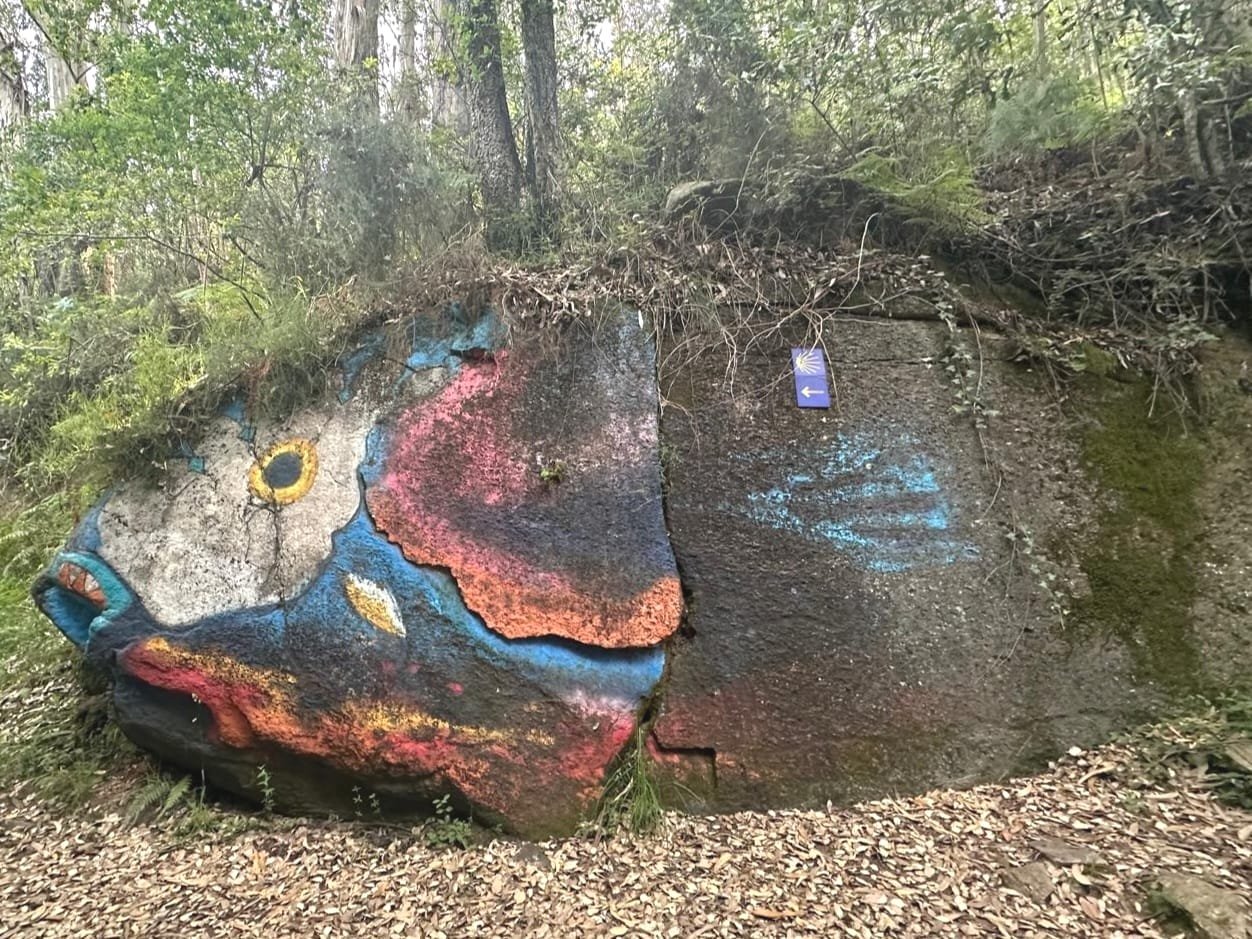
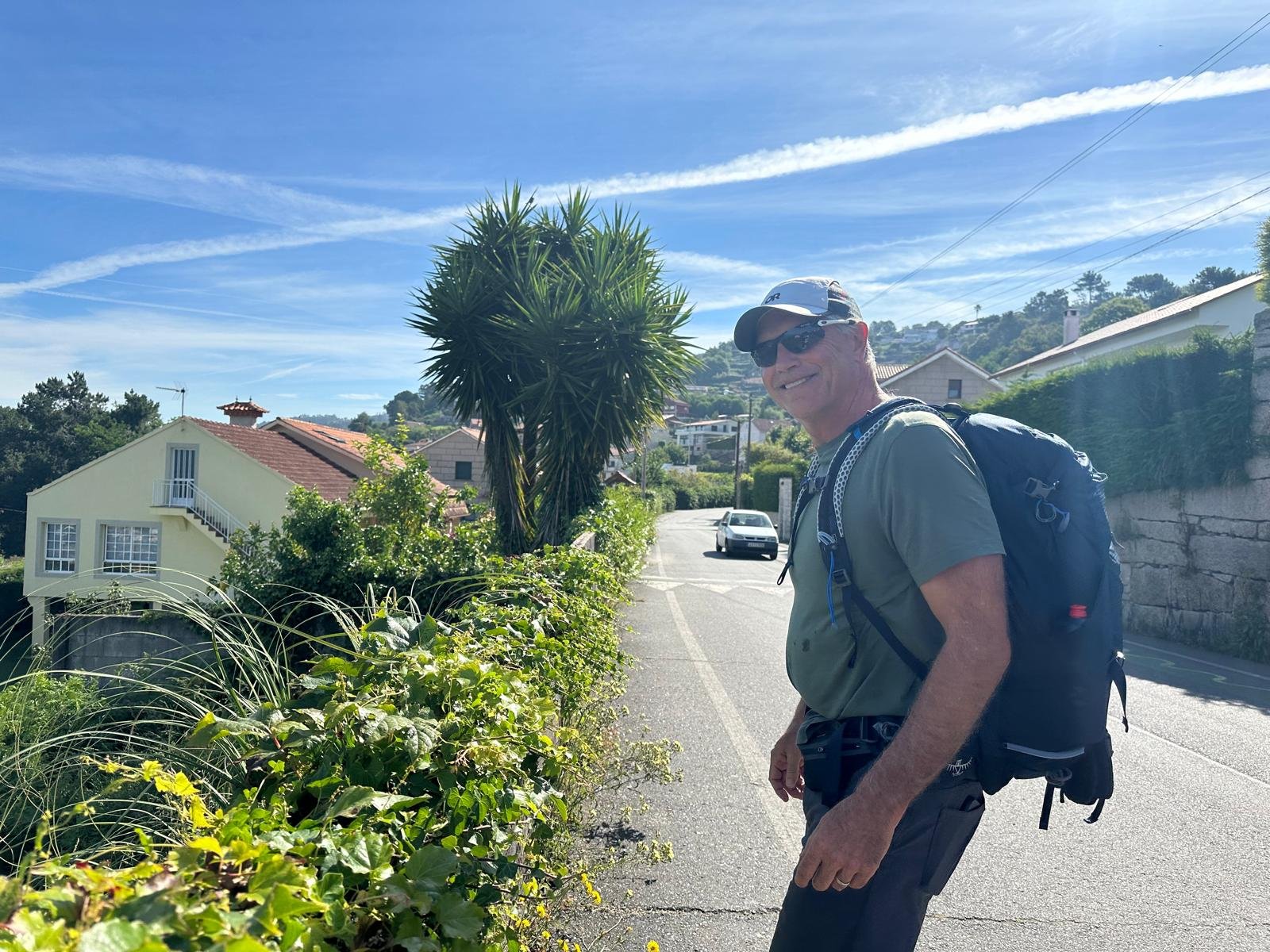


We had our unanimous pick best breakfast this morning--sharing a yogurt with fresh fruit, honey granola, with a delicious pistachio sauce, and a toasted avocado, turkey and goat cheese sandwich. Great start to the day!
We went from there right into a 1,000 foot climb out of Vigo to a mesa that served as our route to Redondela. We were propelled forward by sweeping vistas of the Ria de Vigo below and a refreshing sea breeze from the North.
Not much more to add for this shorter walk day other than having great conversations with Jessica. She's the best.
I will say it's been good having a couple of shorter mileage days like today mixed in with the longer days. We can leave a little later those mornings and get more time to rest and explore the area those afternoons.
We went to dinner at an eclectic gastro bar with a Korean, Spanish and English menu with notes of Japanese decor listening to a playlist of American rock, hip hop and pop songs played in a rockabilly 50s style by a German band. Like I said, eclectic. A fun way to close out the day.
Buenas noches familia!
PS Observation of the day... I've been struck by how many solo pilgrim walkers we've encountered, most of them women. Good on them.
Day 11: Redondela to Pontevedra (13 miles, 1600 feet elevation gain)
Walking the Camino
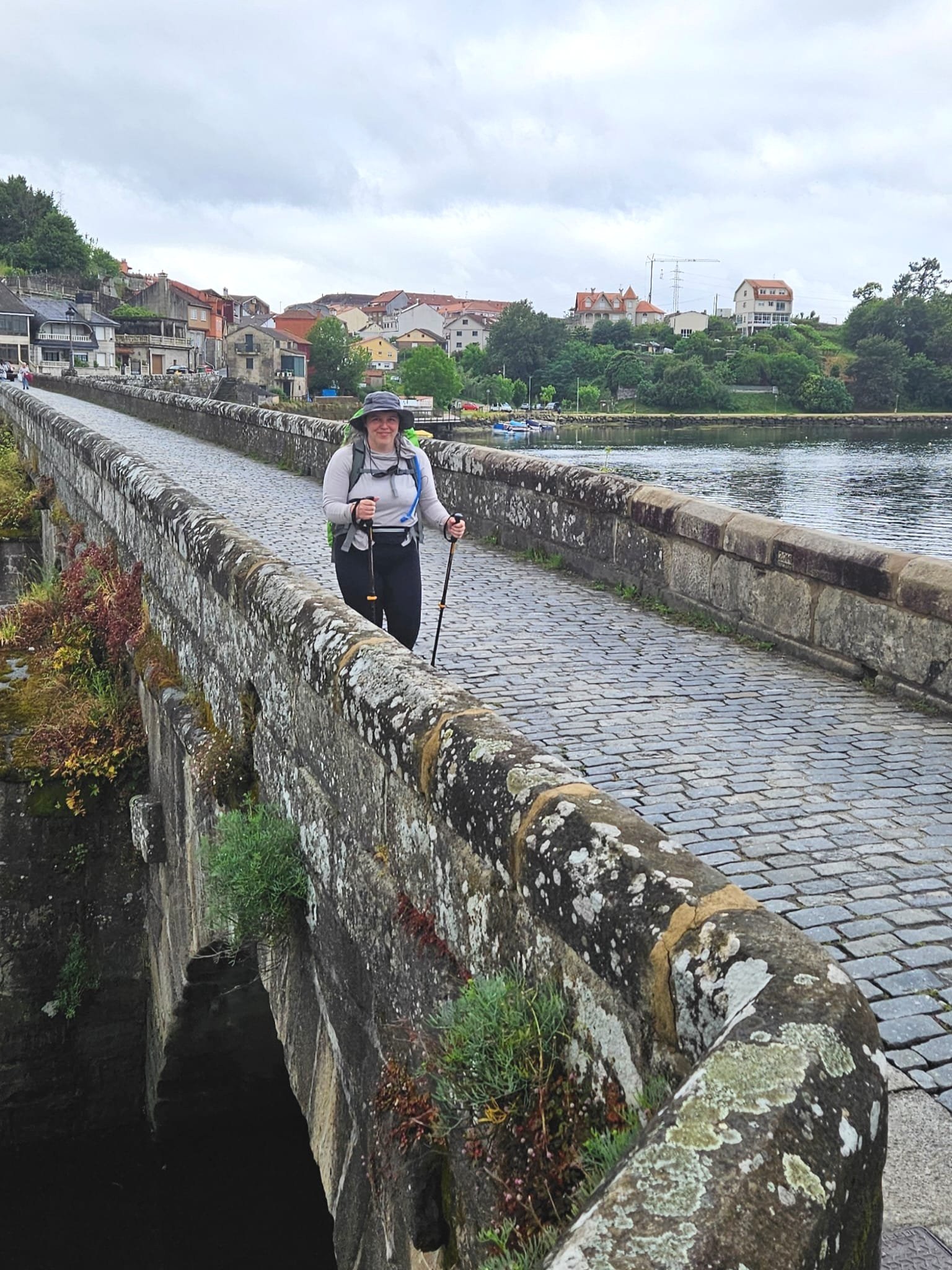
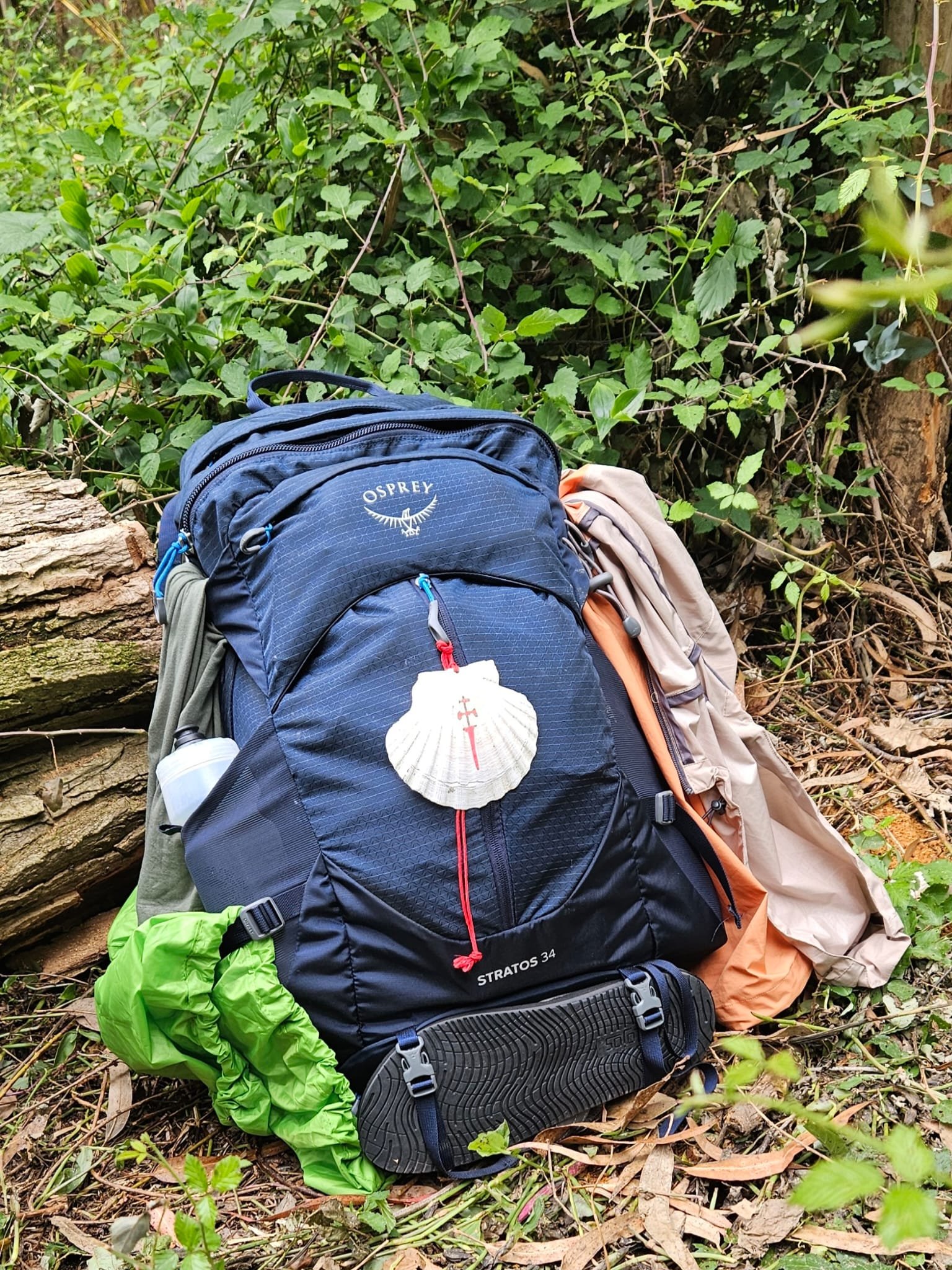
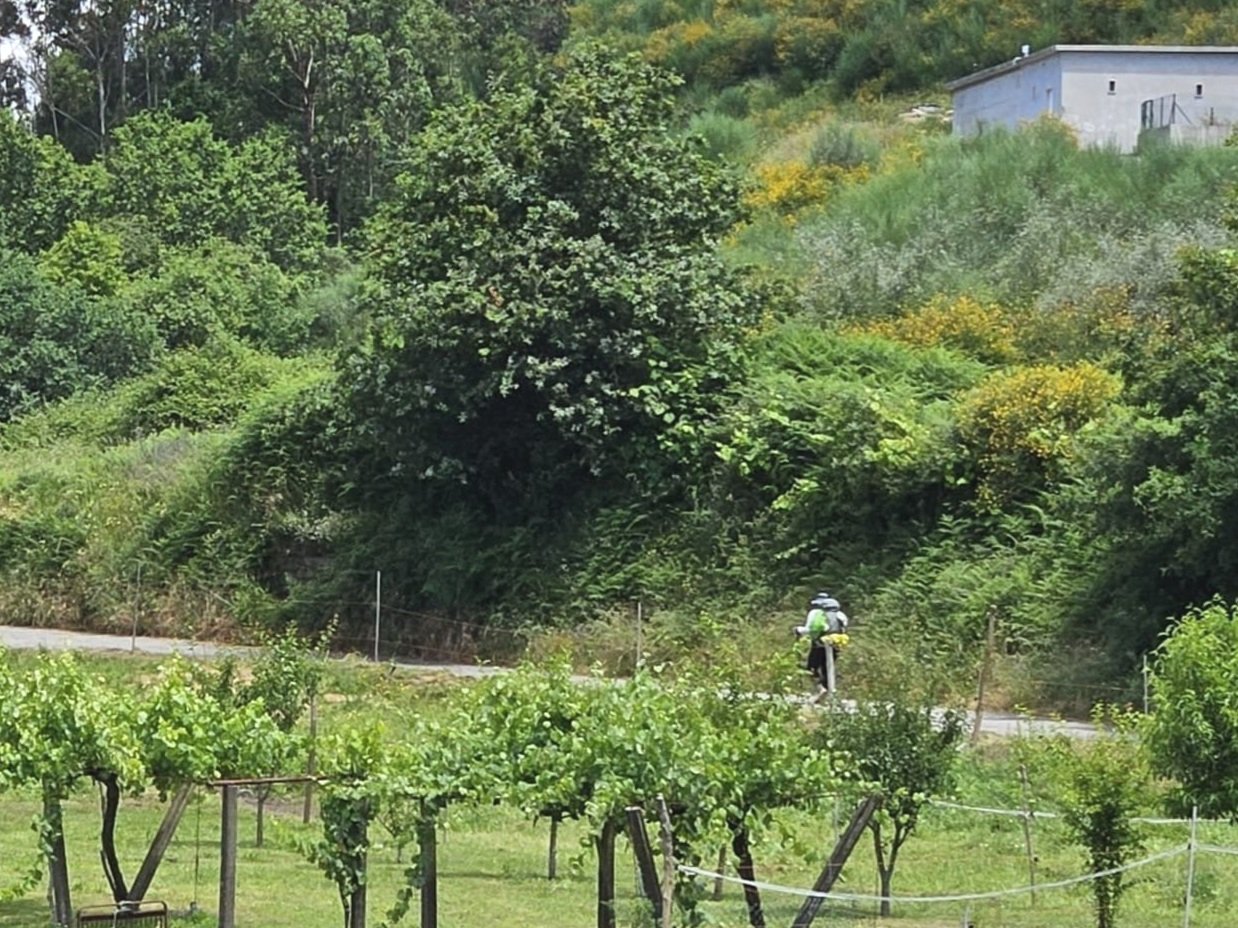

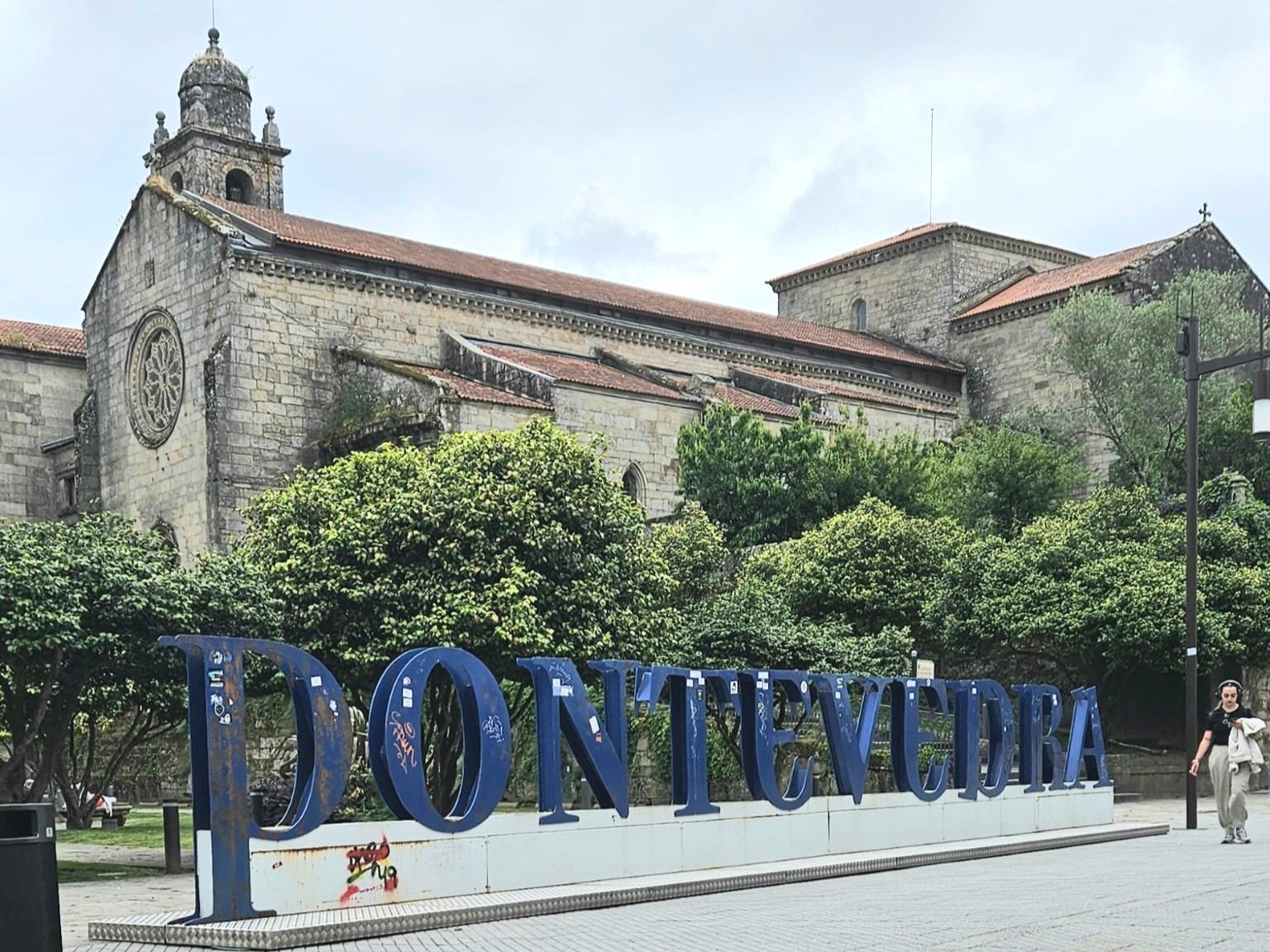
We set off around 8:30am in a light morning rain. It dried up soon enough and stayed pretty cool... perfect walking weather!
We met a lot of people along the way today. Mostly, we call them by their place of origin.
There's Dutchie (from the Netherlands) and Israel, whom we first met at a cafe in town as we were all fueling up for the day. They're two solo traveling ladies in their 40s-50s. They connected three days ago and have been walking together since. We kept finding each other at different points along the way. Funny how that happens with certain people on certain days.
We came across New York and Mexico early on, a couple with good energy and warm smiles. Then came the New Zealand ladies, power walkers in their 50s. We chatted briefly about familiar terrain (hilly like NZ) and weather (rainy like Seattle). The trekking veterans they surely were, off they went as quickly as they had come up on us.
We then met "Baby Family," a young couple pushing a stroller with a little guy. We saw them again once we all got out of the city into a wooded trail, this time with a baby backpack and no stroller. We asked about that. They said they ran into a local who took one look at them and said, "You're not going to be able to take that stroller past here." So they arranged to have the stroller driven to Santiago, where they will get it when they arrive.
That's the second young couple walking with a baby we've encountered. So impressed with them.
We got shells today--see photos. The scallop shell is a common symbol of the Camino. There are a number of different origin stories for the shells that make a link to the spiritual pilgrimage and St. James.
The Camino de Santiago is the Way of St. James, who is considered to have come to Spain to preach the faith. Pilgrims who follow "The Way" are tracing his path, in spirit at least. Many pilgrims have the shell on the outside of their pack. And now we can count ourselves among them.
The miles passed quickly today. Jessica had to manage a new blister, and she did. Otherwise, we both felt strong. None of the soreness of earlier days. It feels great to feel good.
We had a funny moment towards the end of our walk. A woman came up from behind and practically shouted, "Seattle and DC!" It was someone we had met in one of the early days. It was an ironic and interesting moment... we are characters in someone else's Camino story. There's something deeper in that. More to explore there.

